Samsung QN70F is quite a decent television from the mid-range segment. Its strongest point is definitely the smoothness of the picture – thanks to the 144 Hz panel, low input lag, and a plethora of gaming features, we have here a recipe for an almost perfect gaming screen. It also performs well for sports fans – the picture is fast, clear, and there are no tears. In terms of picture quality – it’s really not bad at all. The VA panel provides good blacks, brightness is above average, and colours look great after calibration. Samsung advertises the QN70F as Neo QLED, meaning Mini LED, and in a sense, you can view it that way – but only partially. The backlighting is edge-lit, so it is far from being a full-fledged Mini LED with local dimming. It’s a shame, as marketing has its influence, and the user may feel somewhat misled. Additionally, there are minor shortcomings – no USB recording, no DTS support. But despite everything, the QN70F leaves a really good impression. It may not be a “true” Mini LED, but for its price, it is a solid piece of television – especially for gamers and those who enjoy fast, dynamic content.
- Matching (Score)
- Our verdict
- TV appearance
- Where to buy
- Contrast and black detail
- HDR effect quality
- Factory color reproduction
- Color reproduction after calibration
- Smoothness of tonal transitions
- Image scaling and smoothness of tonal transitions
- Blur and motion smoothness
- Console compatibility and gaming features
- Input lag
- Compatibility with PC
- Viewing angles
- TV efficiency during daytime
- Details about the matrix
- TV features
- Apps
- Playing files from USB
- Sound
Samsung Neo QLED QN70F / QN74F / QN77F vs Samsung Q8F
Direct compare
Check the best price offer:
Samsung Neo QLED QN70F / QN74F / QN77FQN70F / QN74F / QN77F
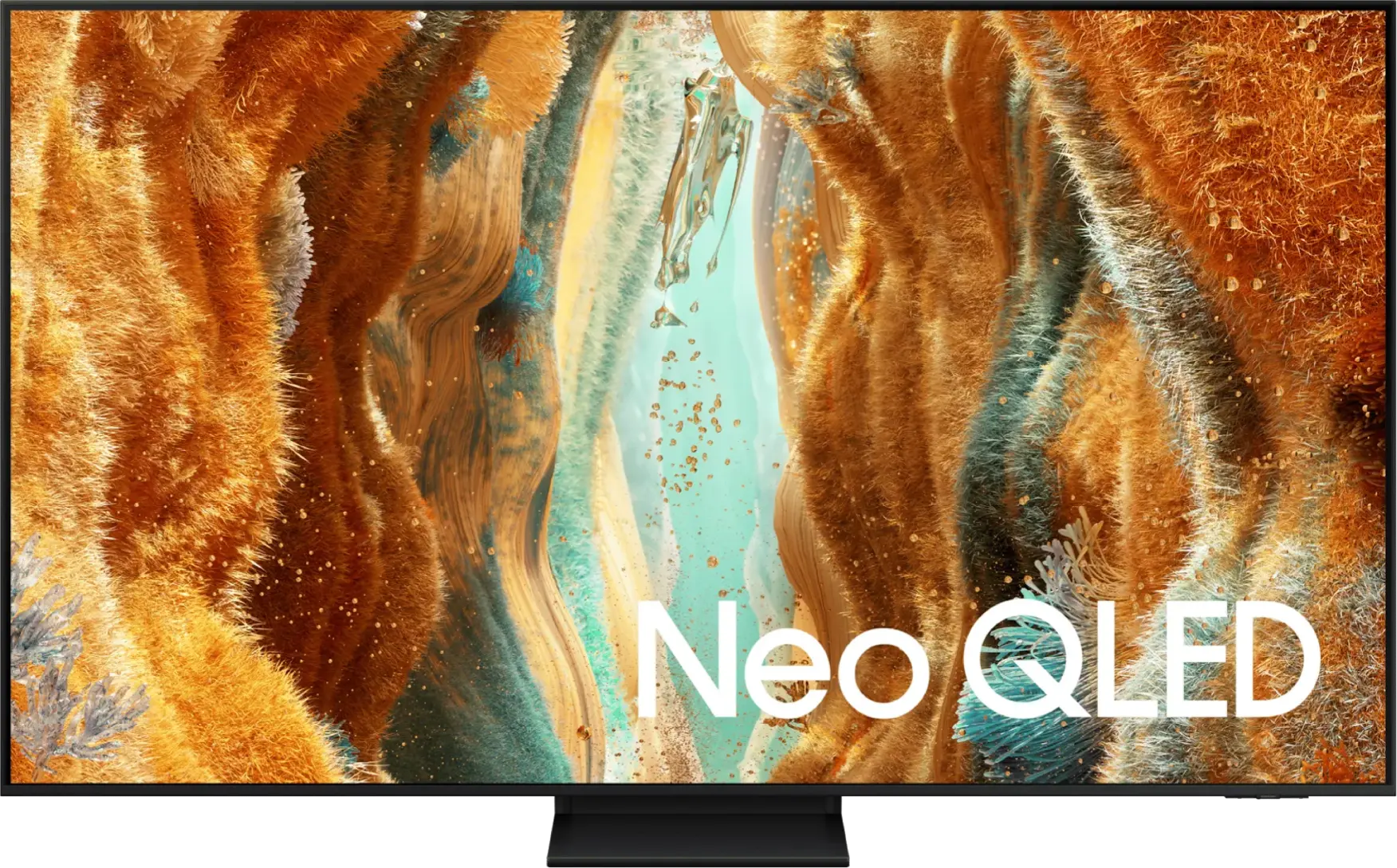
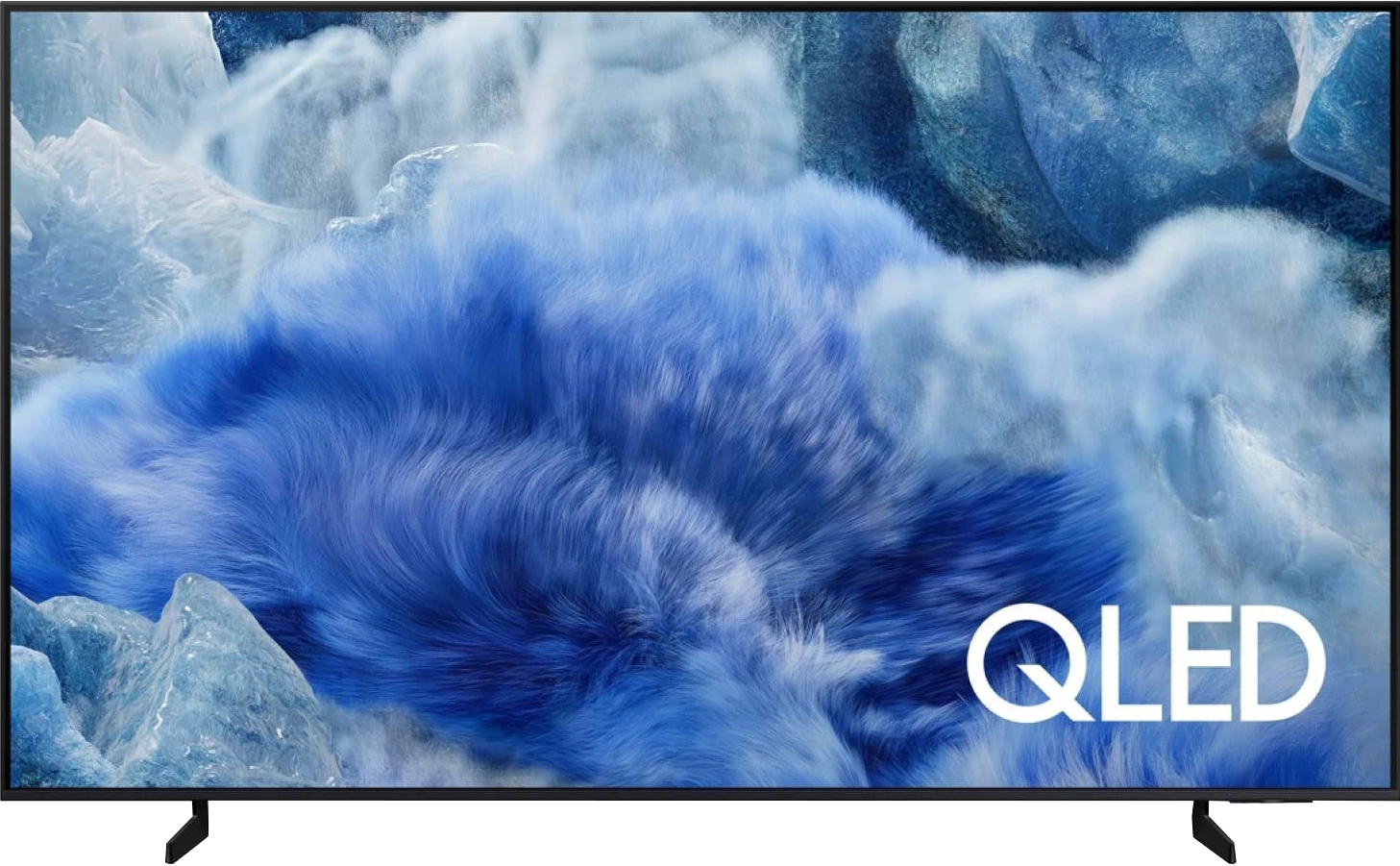
Panel type: LCD VA
Resolution: 3840x2160
System: Tizen
Model year: 2025
Complete the survey to find out the result

Panel type: LCD VA
Resolution: 3840x2160
System: Tizen
Model year: 2025
Complete the survey to find out the result

Overall rating
7.1
6.3
Movies and series in UHD quality
6.7
6.3
Classic TV, YouTube
6.6
6.0
Sports broadcasts (TV and apps)
6.7
5.1
Gaming on console
8.5
6.9
TV as a computer monitor
8.2
6.0
Watching in bright light
6.3
5.6
Utility functions
7.2
7.3
Apps
8.7
8.7
Sound quality
6.4
6.0
Complete the survey to find out what fits your preferences
Advantages
Nice black and contrast
Above average panel brightness
High refresh rate of 144Hz
Many features for gamers: ALLM, VRR, Game Bar etc.
Low input lag
4 HDMI 2.1 ports
Advanced and smooth Tizen operating system
Super slim design
Solid contrast thanks to the VA panel
Quite good brightness in SDR and HDR (up to around 500 nits)
Satin finish handles reflections well
Tizen operating system – fast, intuitive, with a rich selection of applications
Solar remote with USB-C charging
Integration with the SmartThings ecosystem
Excellent input lag
Good font readability when working with a PC, suitable as a monitor for text tasks
Adjustable stand on multiple planes
Disadvantages
No USB recording feature
No DTS format
Issues with the HGIG function (for gamers)
Symbolic local dimming (Is this really MINI-LED?)
Severely limited features for gamers (no VRR in practice, no HGiG)*,
No USB recording or PiP functionality
Average digital image processing
*We hope that the promises on the promotional brochures will be quickly fulfilled through software updates.
Our verdict
Samsung Q8F is quite a successful continuation of the Q67D model. It offers similar image quality in HDR content, and with a brightness of around 500 nits, it can create an effect that is hard to call average. The support for the HDR10+ format also helps, as it has been realistically competing with Dolby Vision for some time and delivers comparable experiences in many productions. The contrast is another positive aspect – for a VA panel, it performs solidly and allows for enjoyable blacks in films and series. However, the greatest advantage of the Q8F remains the operating system. Tizen operates quickly, provides access to many applications, and works well with the SmartThings ecosystem, allowing the television to easily integrate into a larger network of home devices. Interestingly, the Q8F also has a niche application – thanks to its very good font readability, it performs excellently as a screen for working with text. Additionally, there is an adjustable stand that allows the television to be set on practically any desk or narrower TV cabinet. The biggest drawback, in our opinion, is not the image quality itself – as it is difficult to expect miracles in this price range – but rather what has happened to the gaming features. Options such as VRR and HGiG have disappeared with updates, which were available even in simpler constructions in previous generations. Indeed! The manufacturer even boasts about the availability of these features in its catalogue. This makes it difficult to recommend the Q8F to anyone today who plans to connect a console and expects full support for new technologies. Thus, the Q8F is a television that can be appealing – primarily for its design, above-average image quality, and efficient Tizen system. But at the same time, one can see a step backward compared to its predecessor. Let us hope that Samsung will manage to quickly rectify these shortcomings, as otherwise even such a successful 'everyday' television may leave some users with a sense of dissatisfaction.
TV appearance
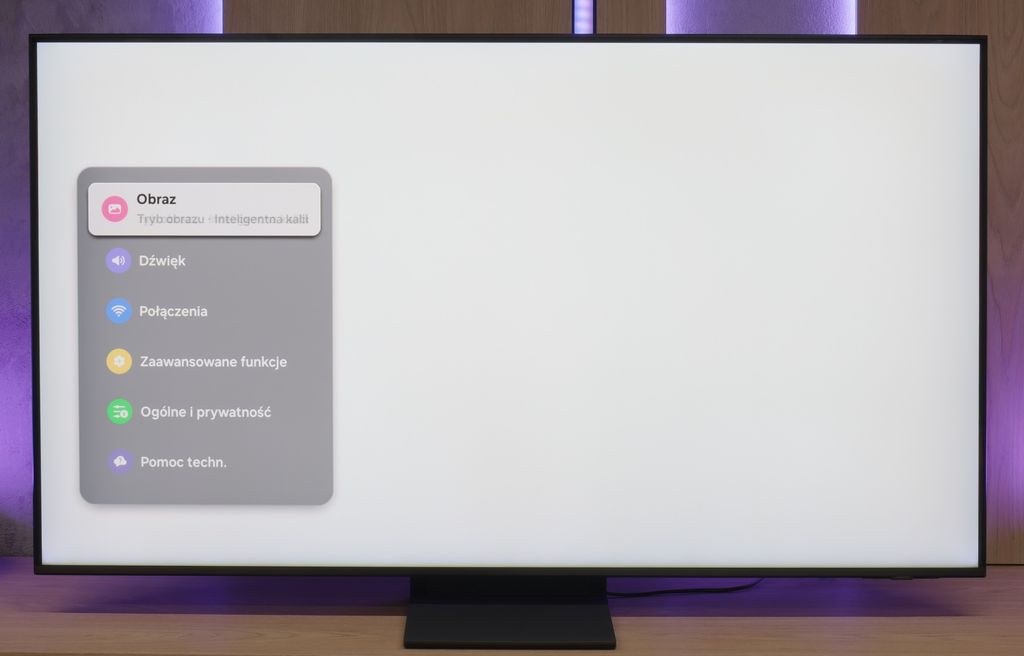
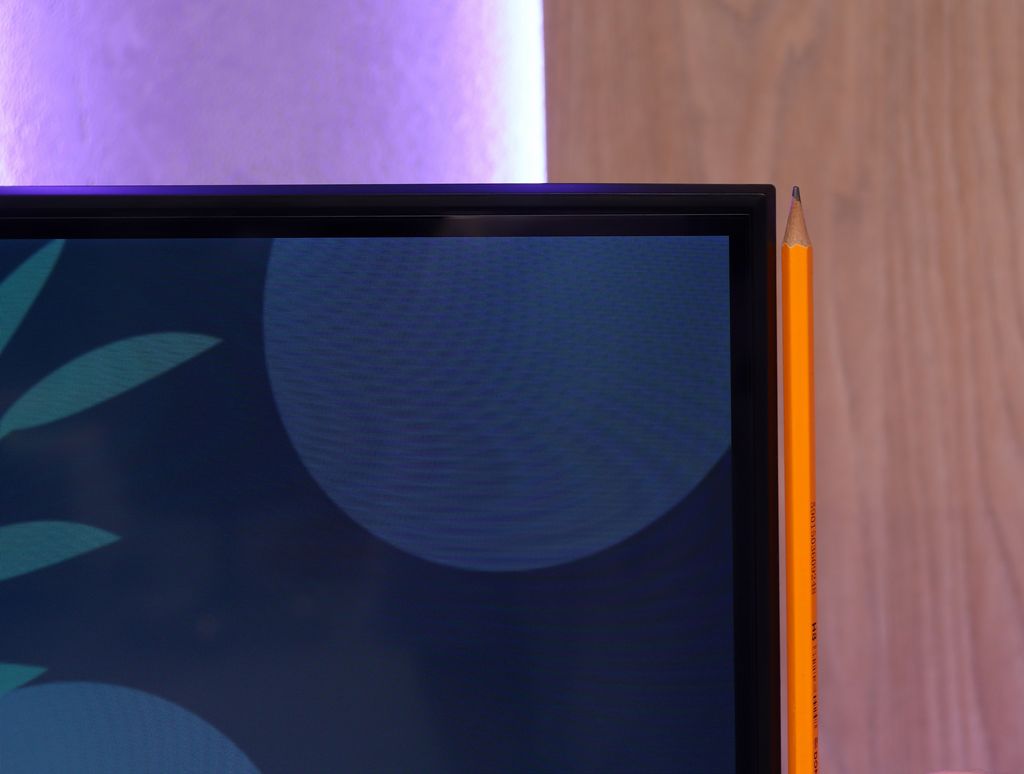
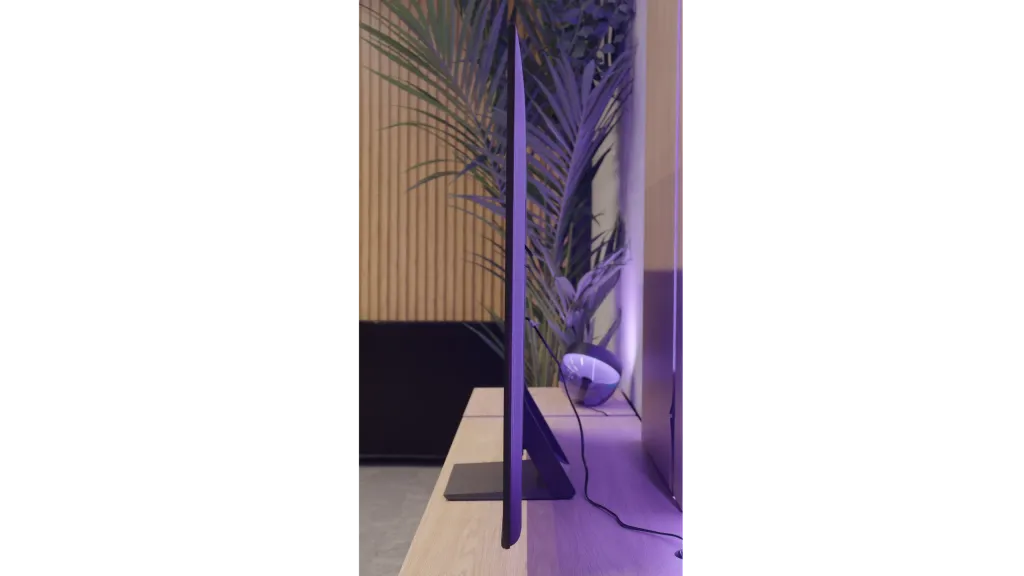
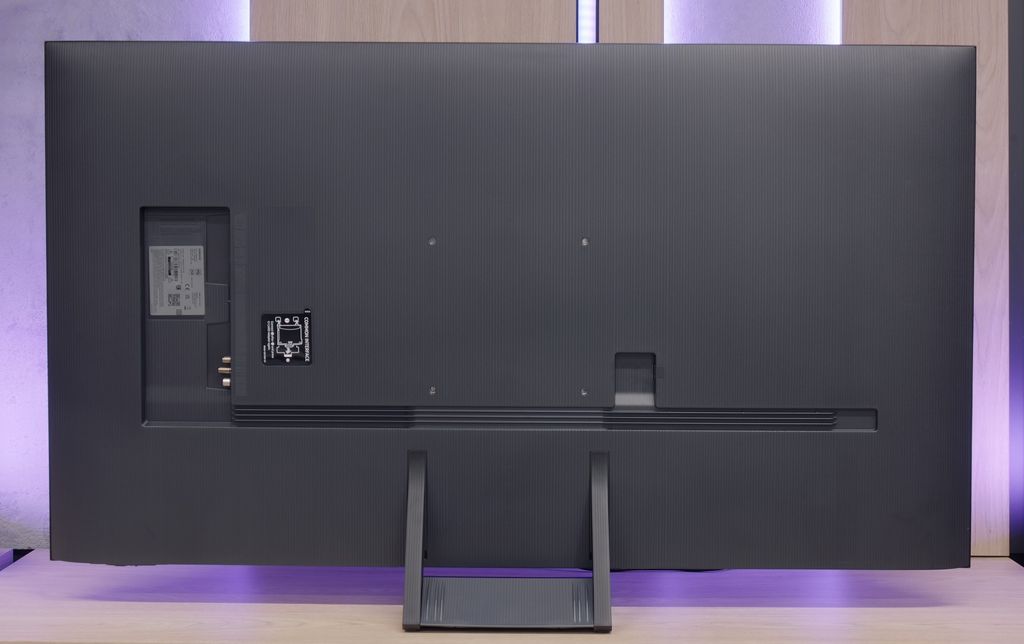
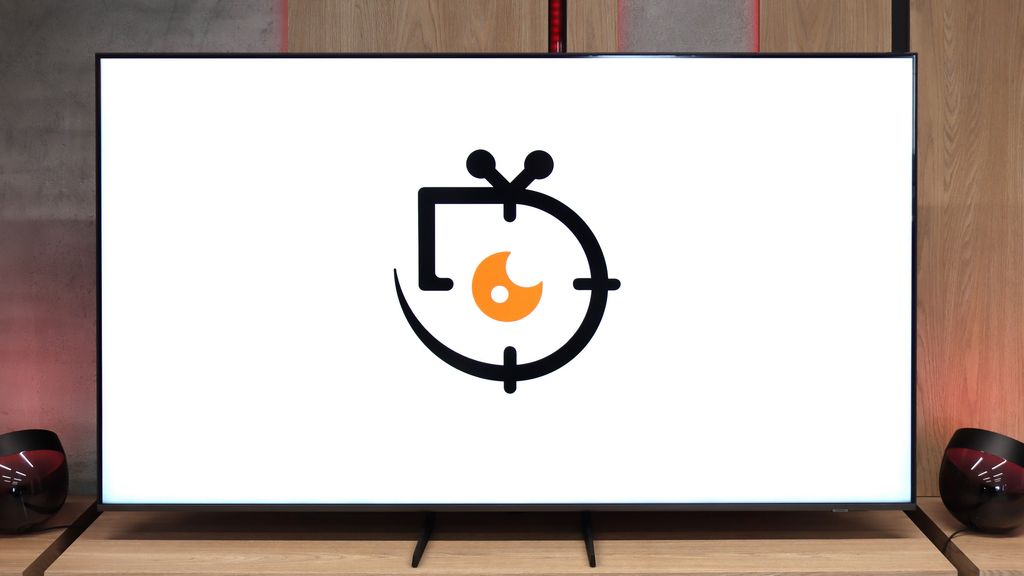
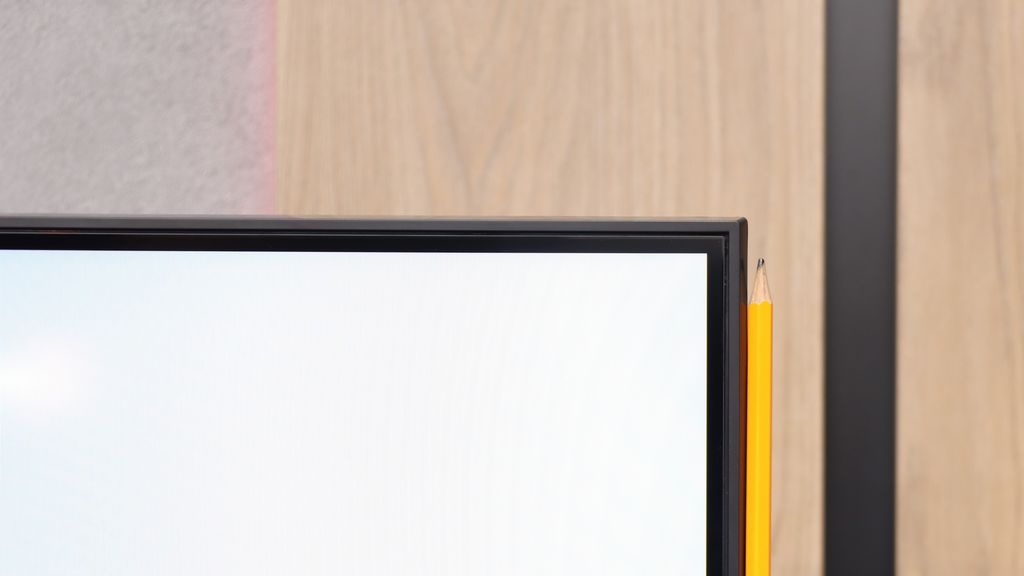
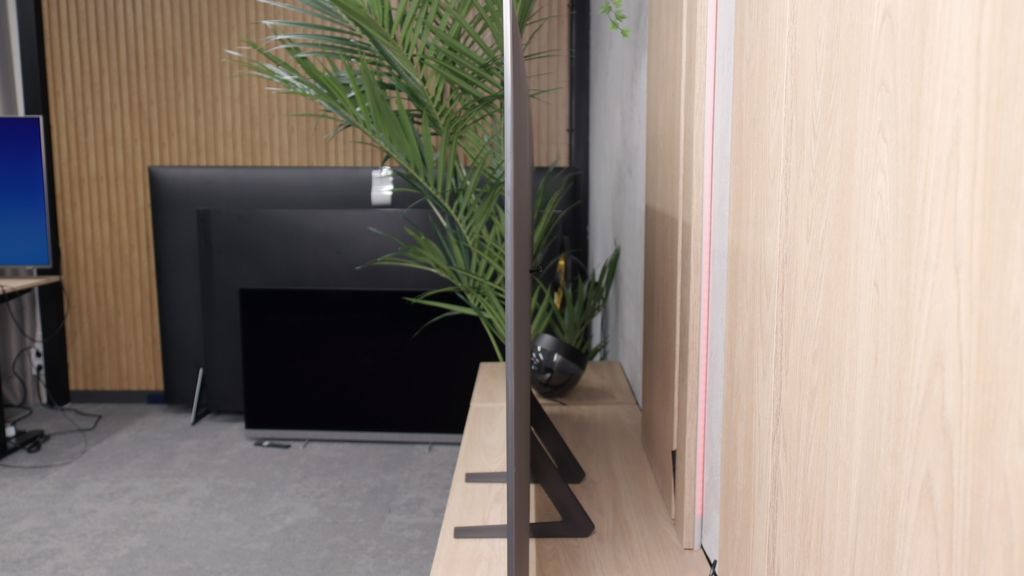
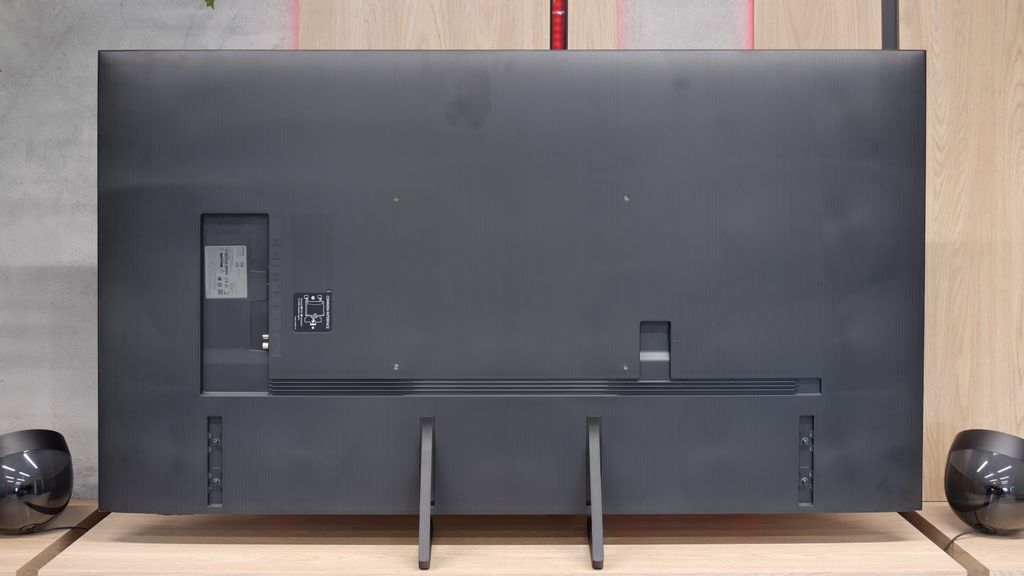
Contrast and black detail
6.2/10
5.5/10
Local dimming function: Yes, number of zones: 20 (1 x 20)
Local dimming function: No
Contrast:

Result
9,200:1

Result
7,000:1

Result
5,350:1

Result
5,700:1

Result
5,300:1

Result
5,200:1

Result
4,650:1

Result
3,650:1

Result
4,100:1

Result
4,150:1
Halo effect and black detail visibility:
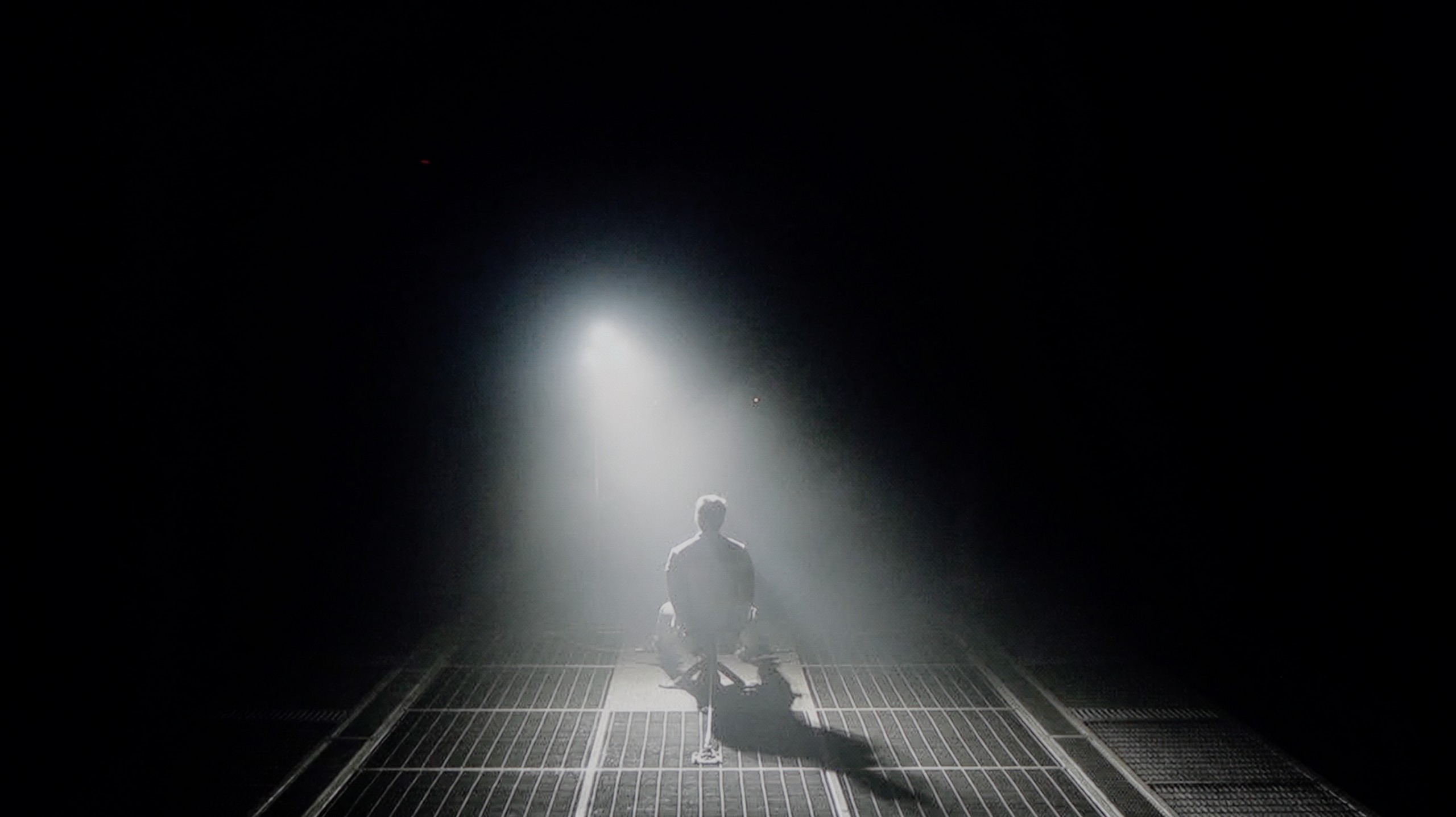
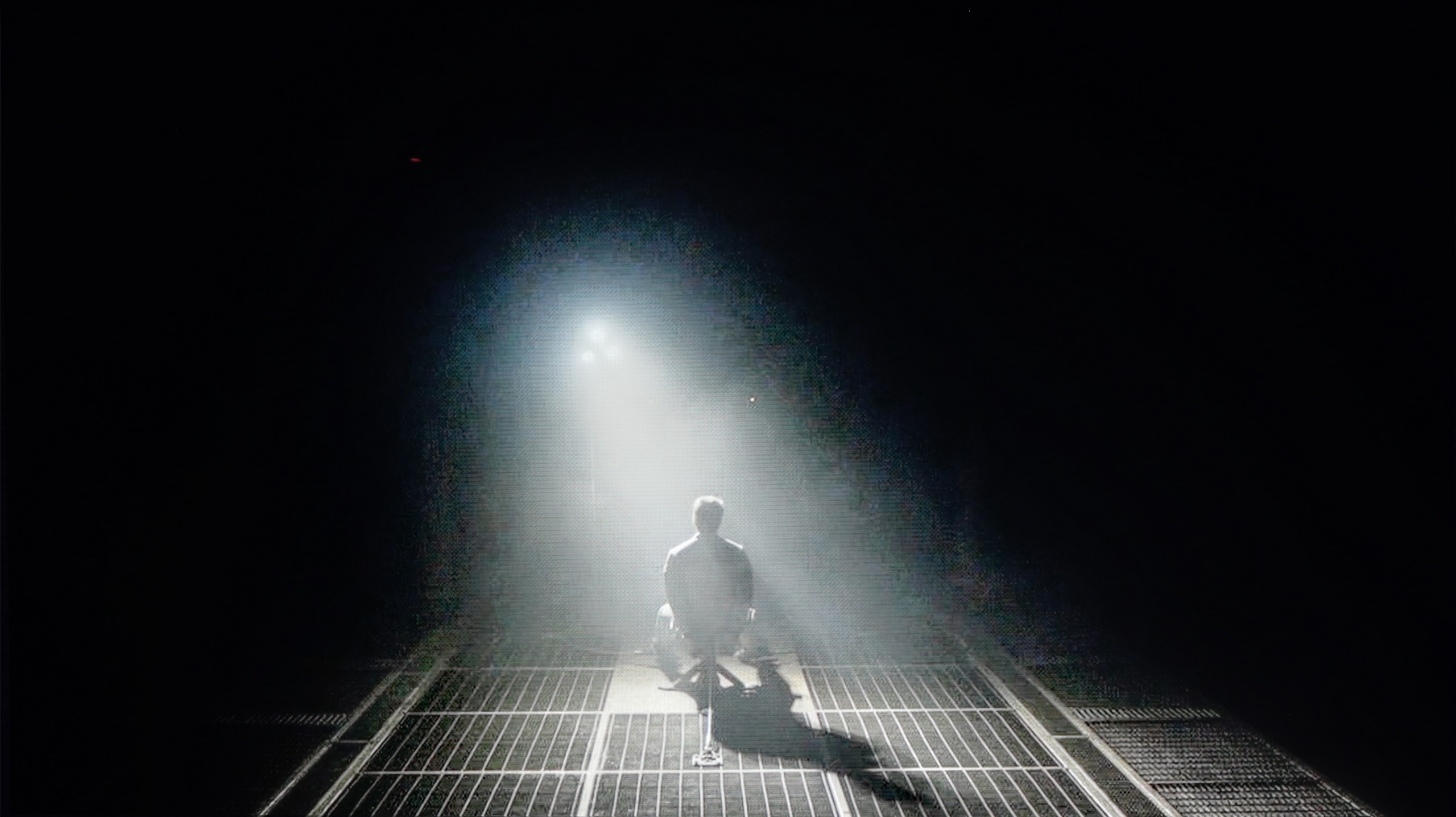
The QN70F is equipped with a VA panel that offers a high native contrast – this is already a good starting point for black levels, especially during evening viewing. However, its capabilities do not theoretically end there. The television is branded as Neo QLED, which indicates the presence of Mini LED technology and a local dimming system. And indeed – the QN70F has this function. The problem is that we are not talking about classic local dimming with LEDs positioned directly behind the panel. Instead, edge lighting has been implemented with an overall dimming mechanism known as global dimming. The effect of this is that instead of selective brightness control in individual zones, the entire screen is slightly dimmed when a dark scene appears. In practice, this means that the contrast is average compared to Mini LED models that offer true local dimming. The black levels are not bad – thanks to the VA panel itself – but one cannot speak of precise light control like that provided by advanced systems with multiple zones. This raises the question: is the QN70F series really a Mini LED television, or just a marketing variation on the Q70 series? Looking at the technical aspects – it is hard to consider this model a full-fledged representative of this technology. But in everyday use, the black levels appear decent and for many people may be fully satisfactory.
Samsung Q8F uses a VA LCD panel, which immediately puts it in a good position when it comes to contrast. By nature, such panels offer deeper blacks than IPS displays, and this effect is indeed noticeable here. In the test patterns, the contrast maintained itself in the range of around 4000:1 to even 6000:1, which in practice results in a surprisingly engaging image, especially in a slightly dimmed living room. Of course, it does not reach the level of LCD screens with local dimming, let alone OLED — sometimes the black can shift to a shade of blue, making the overall image appear flattened. However, Samsung employs a simple trick: so-called global dimming, which dims the entire screen when a lot of dark areas appear. The effect can be impressive, but it comes at the cost of losing some detail, which may not appeal to everyone. Despite this, the Q8F still presents itself significantly better than televisions with IPS panels, offering solid contrast and blacks that can draw you into the cinematic atmosphere.
HDR effect quality
5.6/10
5.2/10
Luminance measurements in HDR:

Result
619 nit

Result
449 nit

Result
500 nit

Result
422 nit

Result
483 nit

Result
473 nit

Result
417 nit

Result
457 nit

Result
210 nit

Result
471 nit
Scene from the movie “Pan” (about 2800 nits)


Scene from the movie “Billy Lynn” (about 1100 nits)


Static HDR10


Dynamic: HDR10+
Dynamic: HDR10+


HDR luminance chart:
Samsung Q8F
HDR luminance
Samsung Neo QLED QN70F / QN74F / QN77F
HDR luminance
The QN70F is a television that can pleasantly surprise when it comes to brightness. In ideal testing conditions, it reaches up to 800 nits, which – for this price range – is a really solid figure. Of course, this result comes from measurement charts, so we decided to check how it performs in practice, with real films. Here, the television somewhat tempers its capabilities. In most tested scenes – for example, in "The Meg" – the actual HDR brightness hovered around 500 nits. This is still a decent result, allowing for enjoyment of HDR effects, although it is far from perfect. On the other hand, we have a QLED screen with a layer of quantum dots, which means very good colour reproduction capabilities. The colours are vibrant and saturated. The QN70F covers about 94% of the DCI-P3 colour space, and in the wider BT.2020 palette, it exceeds 75%, so in this respect, there is nothing to be ashamed of.
In terms of brightness, the Samsung Q8F performs surprisingly well for a television without local dimming. In measurements, it reaches up to 500 nits, which in practice means that most movie and series scenes look pleasing, and it cannot be accused of lacking the 'HDR effect'. In films such as Life of Pi or The Meg, the screen was able to burst with brightness and deliver a light effect at a satisfying level. It struggles more in difficult moments — during dark scenes with individual bright points. The global dimming used causes the television to dim the image to maintain deep blacks, but at the expense of detail brightness. This is clearly visible in the scene from Sicario 2, where the helicopter lights dropped to around 200 nits. This is a conscious design decision that gives the impression of deeper blacks, but somewhat takes away the brightness from individual elements, and one must simply keep this in mind. In terms of colour reproduction, the Q8F uses quantum dot technology, which widens the colour gamut. A coverage of the DCI-P3 palette at 91% can be considered a decent result, although it is not a record-breaking figure compared to other QLEDs.
Factory color reproduction
7/10
4.6/10
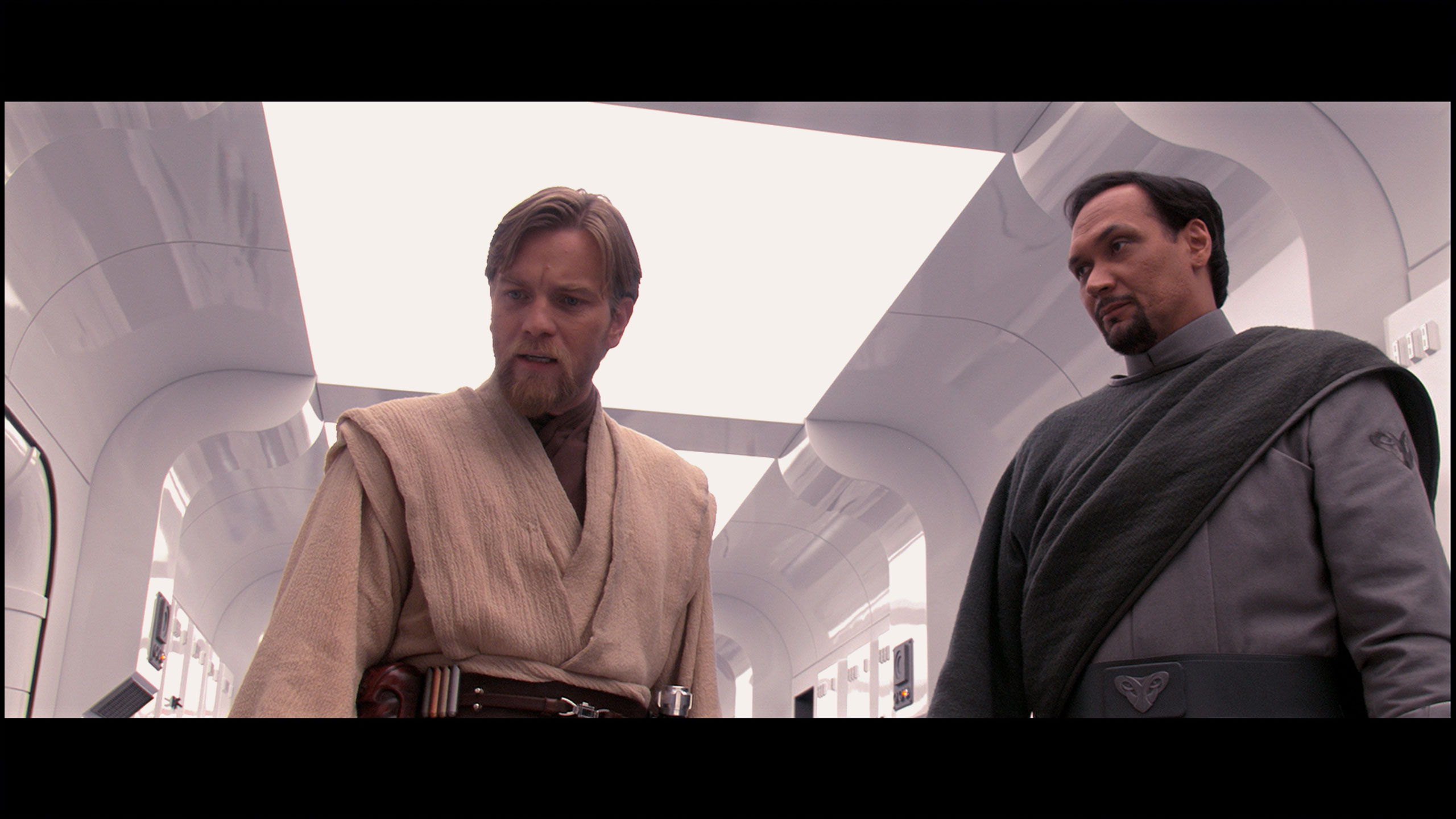
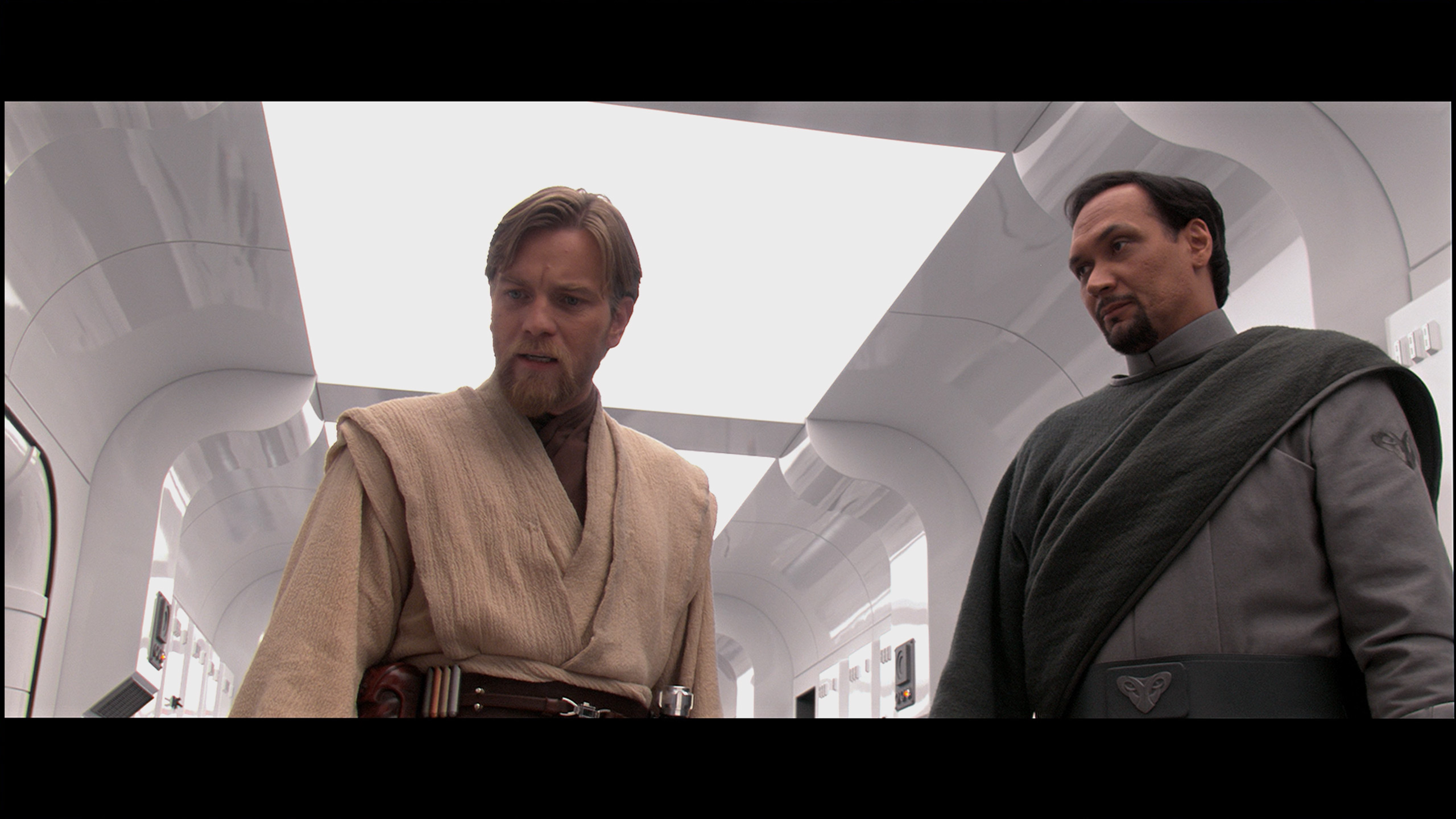
Factory Mode
After calibration
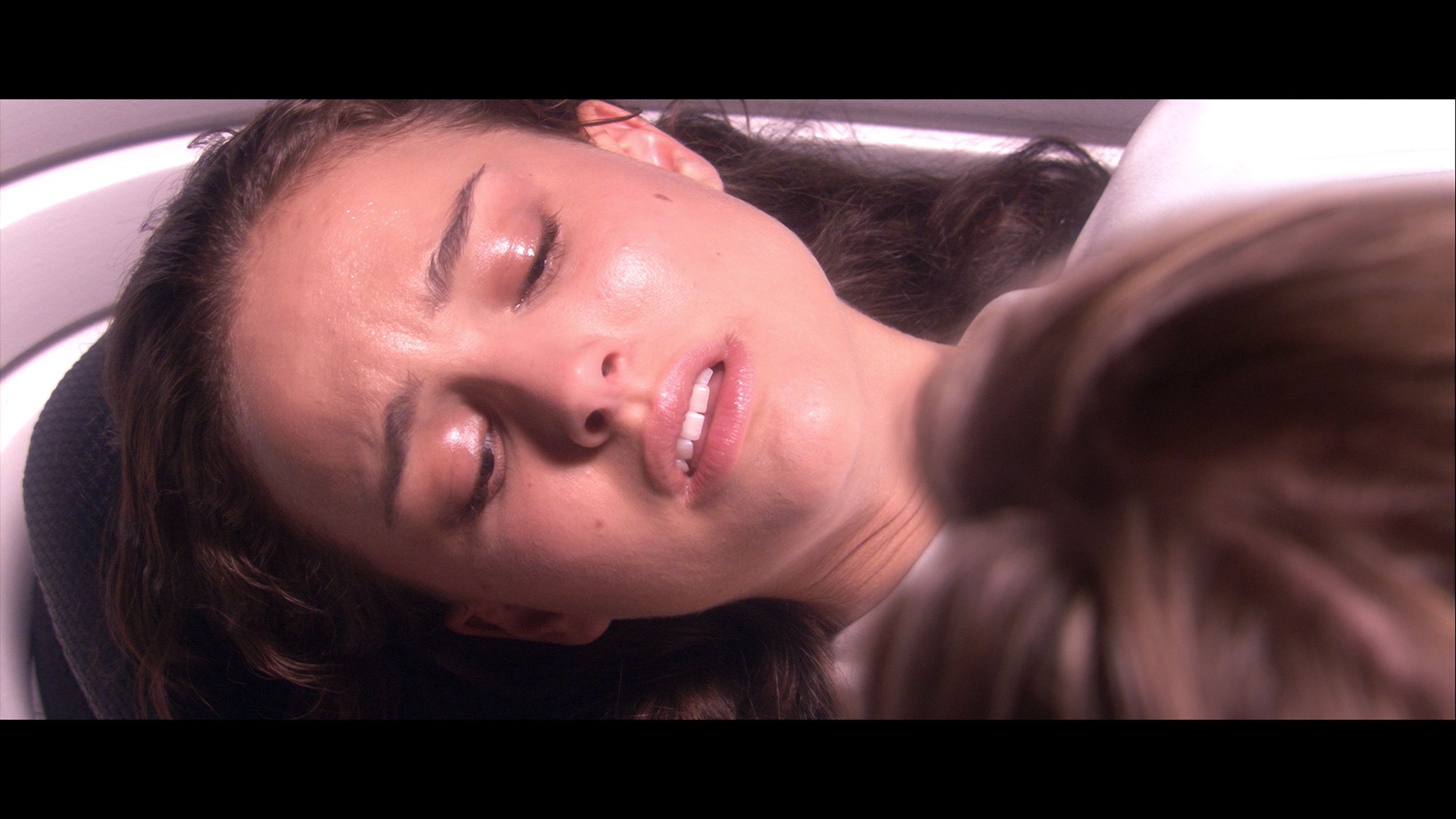
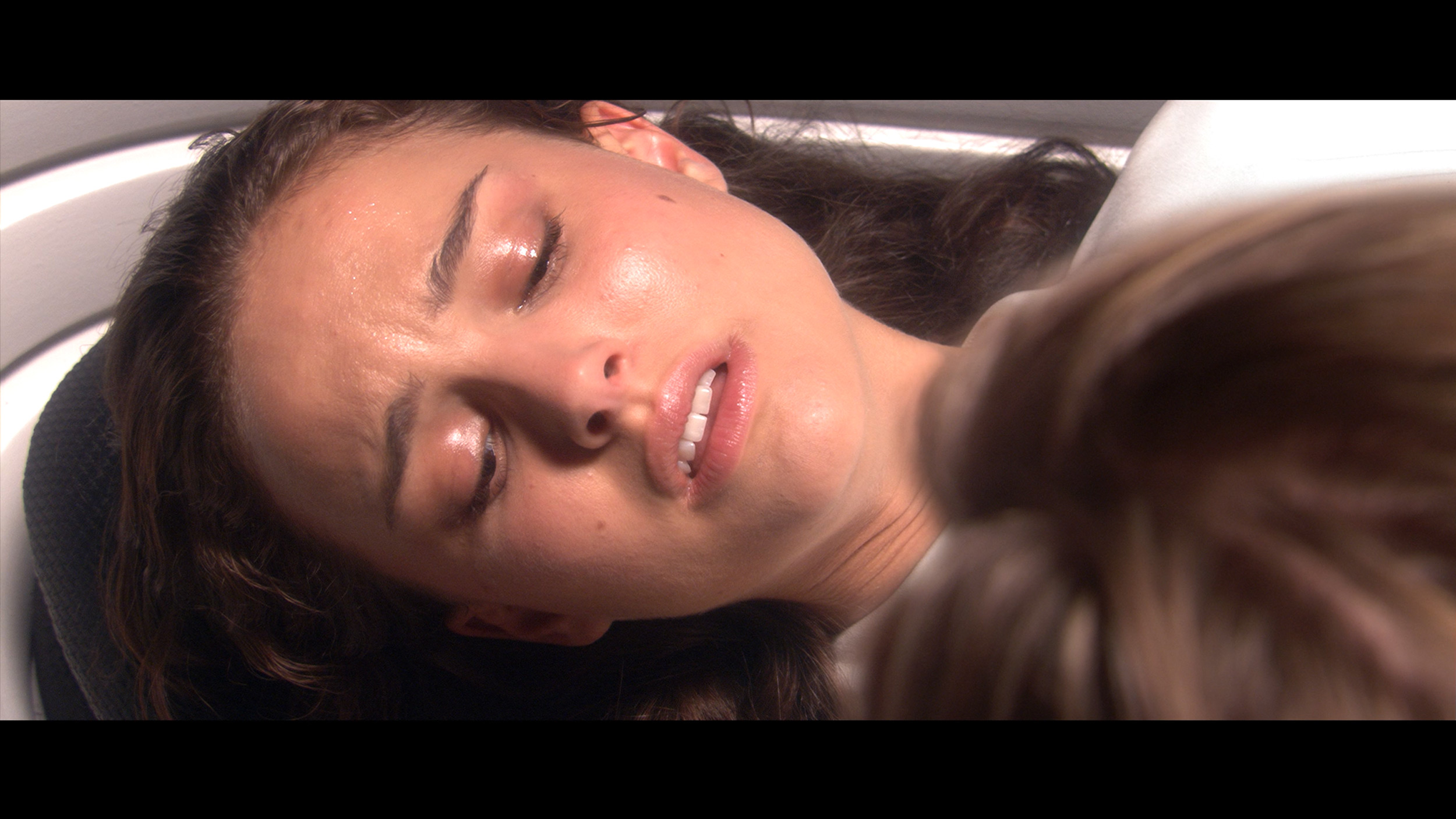
Factory Mode
After calibration
We tested the QN70F in its best default picture mode, which is Filmmaker Mode. I must admit that in this particular test unit, the factory settings performed quite well. The image was calm, natural, and despite minor deviations – pleasant to watch. The biggest flaw was a slight dominance of red in the white balance, which caused a slight pinkish hue across the entire scene. However, this was not a glaring defect – rather subtle and only noticeable when directly compared to a properly calibrated screen. A somewhat larger issue arose in the brightness characteristic. The television tends to underestimate the brightness of parts of the image that should be displayed more brightly. As a result, some details can appear slightly muted – not so much lost completely, but not resonating as clearly as they should. Nonetheless, as far as televisions in this category and in these settings are concerned – we consider the result a good starting point for further calibration.
We decided to check out the Filmmaker mode, as it provided us with the best image straight out of the box. However, this does not mean it was perfect. The white balance had too much blue and red, resulting in the white taking on a slight mauve-pink hue. Such an imbalance affected the visibility of practically all colours, as can be seen in the comparison photo below. The brightness characteristics in SDR content were quite well adjusted, though in HDR material we noticed that the television did not always manage its global dimming effectively — at times the screen was too dim, while at other moments it could suddenly brighten. Fortunately, issues related to colours can be effectively corrected with calibration tools, so we decided to get to work.
Color reproduction after calibration
8.5/10
7.8/10




After calibration, the QN70F shows that it can offer a truly high level of colour reproduction. The white balance was nearly perfectly aligned, and the values in the Color Checker test dropped below level 3 – meaning below the threshold at which the average eye can perceive differences. The image looks natural, and the colours are faithfully rendered, without excessive saturation or the coolness known from factory settings. It must be admitted that Samsung provides very extensive calibration options – not only for enthusiasts but also for professionals. The QN70F takes advantage of this potential and, after proper adjustment, can come close to significantly more expensive models in terms of colour accuracy. The only thing that can still be nitpicked is the brightness characteristic. There is still a tendency to lighten the smallest areas of the image – particularly those that should remain darker. However, this is a design feature of this model, not a calibration error. Despite this, the final effect definitely deserves recognition.
After calibration, we managed to correct the white balance to near perfection. Older SDR content looks fantastic — most errors fall within a value range of 2, which is well below the threshold of perceivability for the human eye. In HDR, we also brought the white balance to an acceptable level, but another issue arises here. So why are there still relatively large errors in colour reproduction? This mainly stems from the limited colour palette and the way the television manages brightness. The global dimming technique used does not give the user control in the settings, so when analysing the EOTF curve in HDR films, it is apparent that the Q8F can modify luminance independently. This can be regarded as a certain limitation, but despite this, the picture after calibration is still much more pleasant to view than in the factory version.
Smoothness of tonal transitions
9/10
9/10
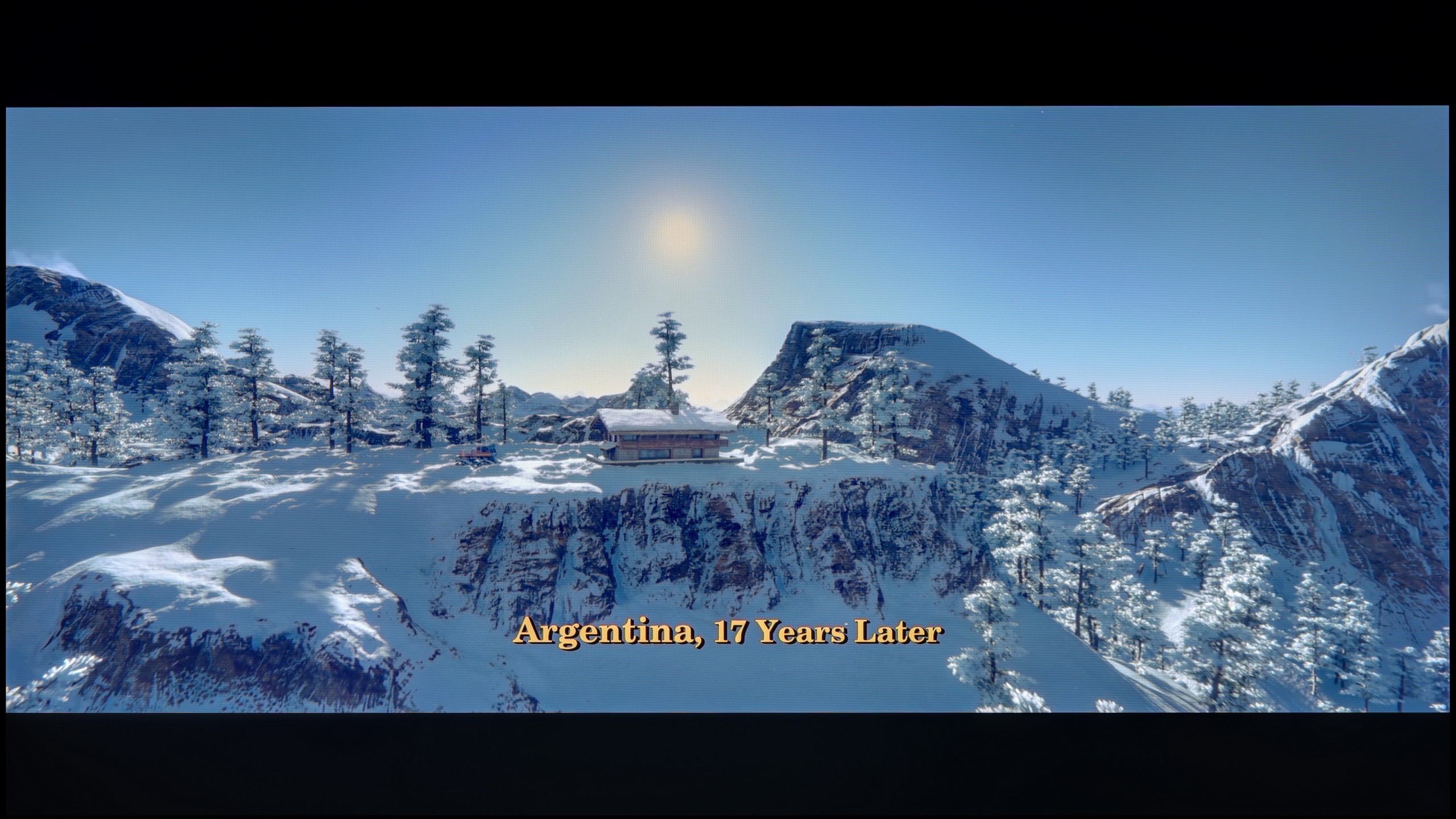



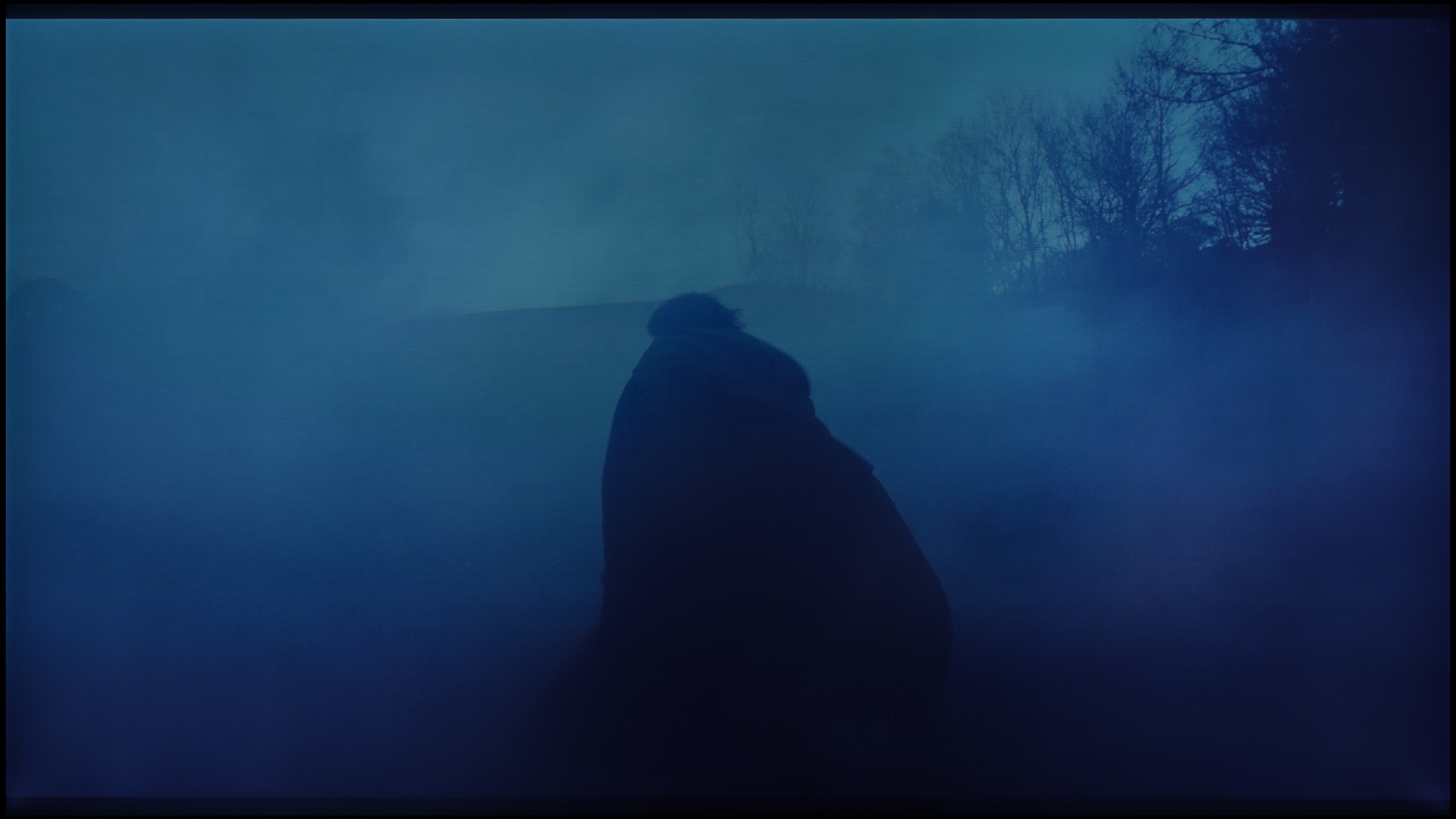
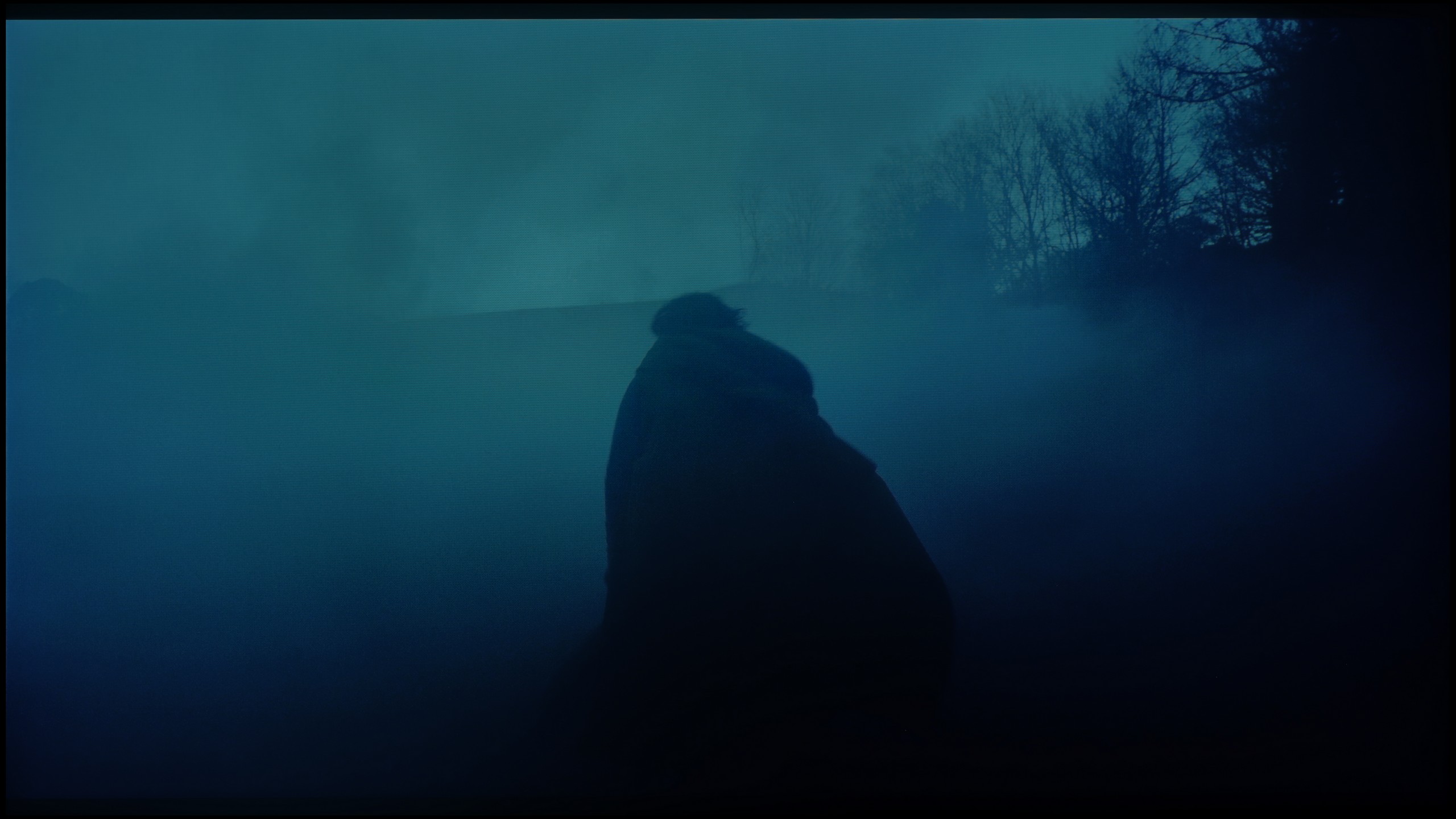

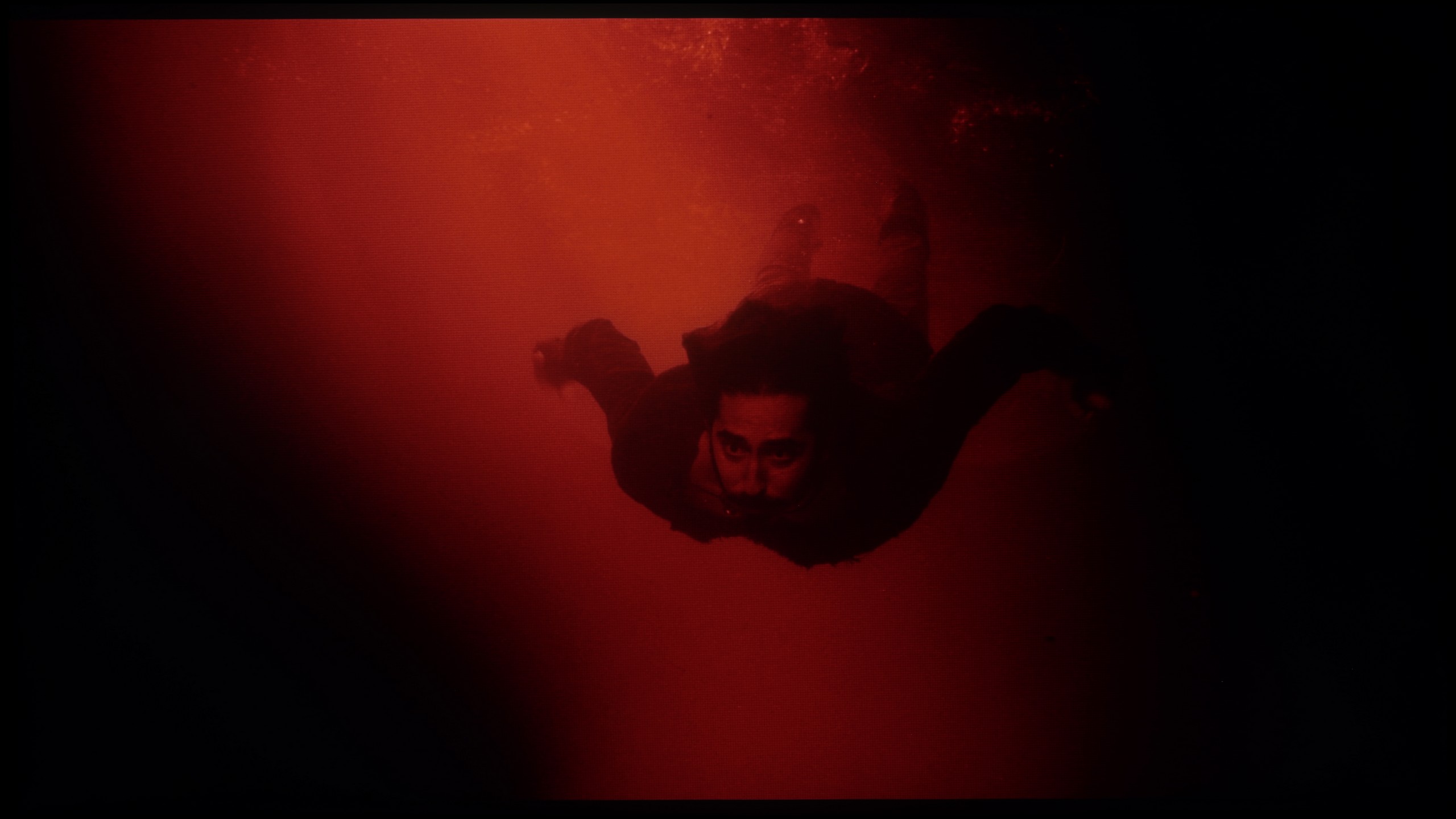




In terms of the fluidity of tonal transitions, the QN70F performs really well. Gradients are smooth, and colours blend into each other without obvious thresholds or banding. Even in more difficult movie scenes – particularly those that are very dark – any possible imperfections are minimal and you really have to make an effort to notice them. In regular viewing, most users should not encounter any issues with colour merging. The image looks clean and coherent, without artificial smoothing or distortions. This is another aspect in which the QN70F pleasantly surprises.
The fluidity of tonal transitions in the Q8F performs really very well. The television beautifully blends colours, both in bright patches of sky and in darker scenes, where it is easy to spot visible "steps" in colours. Admittedly, there are occasional errors, but you have to look closely to catch them. In practice, when watching films or series, the image appears cohesive and does not distract with any artefacts. Therefore, the rating in this category had to be high. 😉
Image scaling and smoothness of tonal transitions
6.9/10
5/10
Smooth transition function
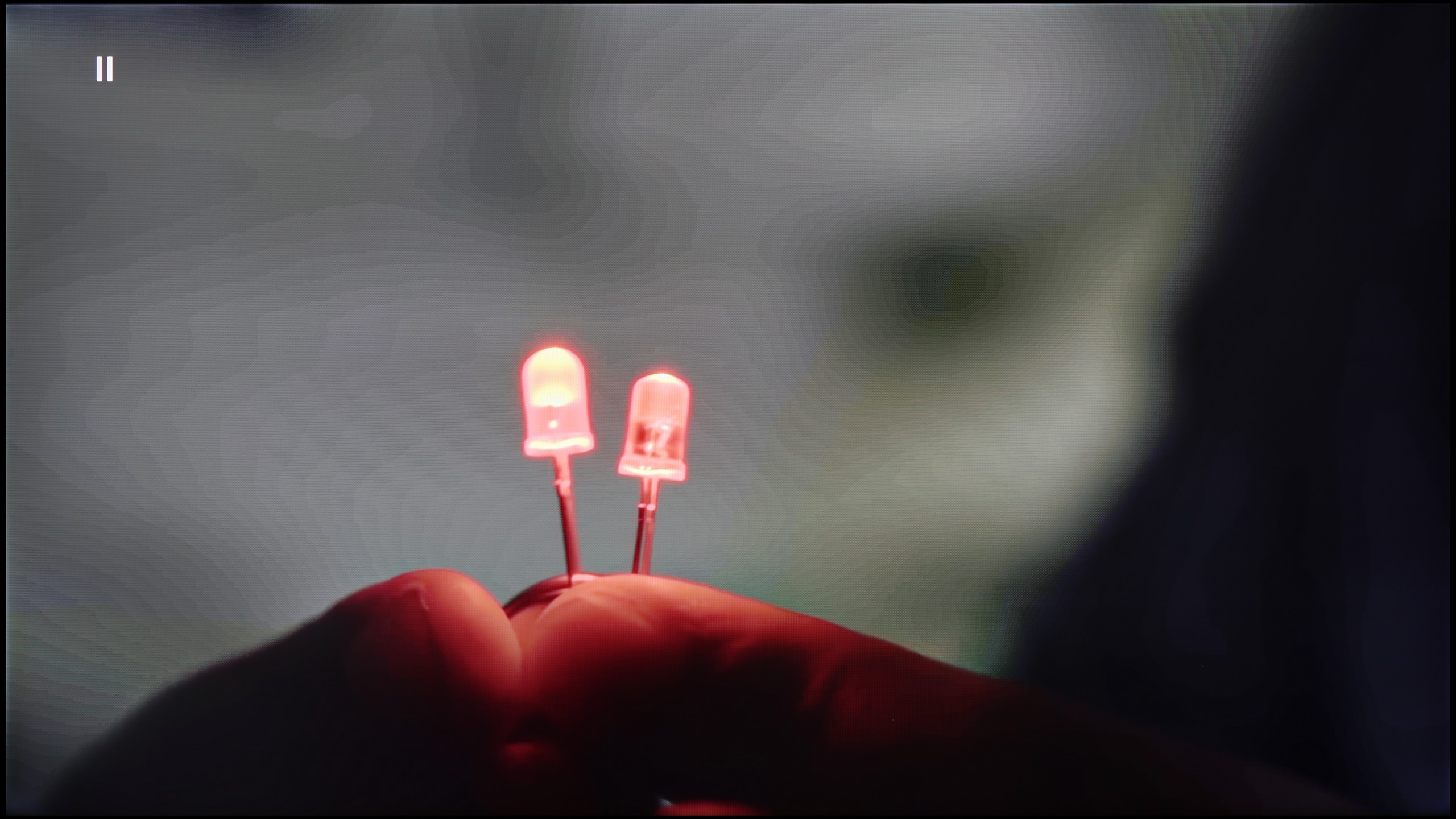
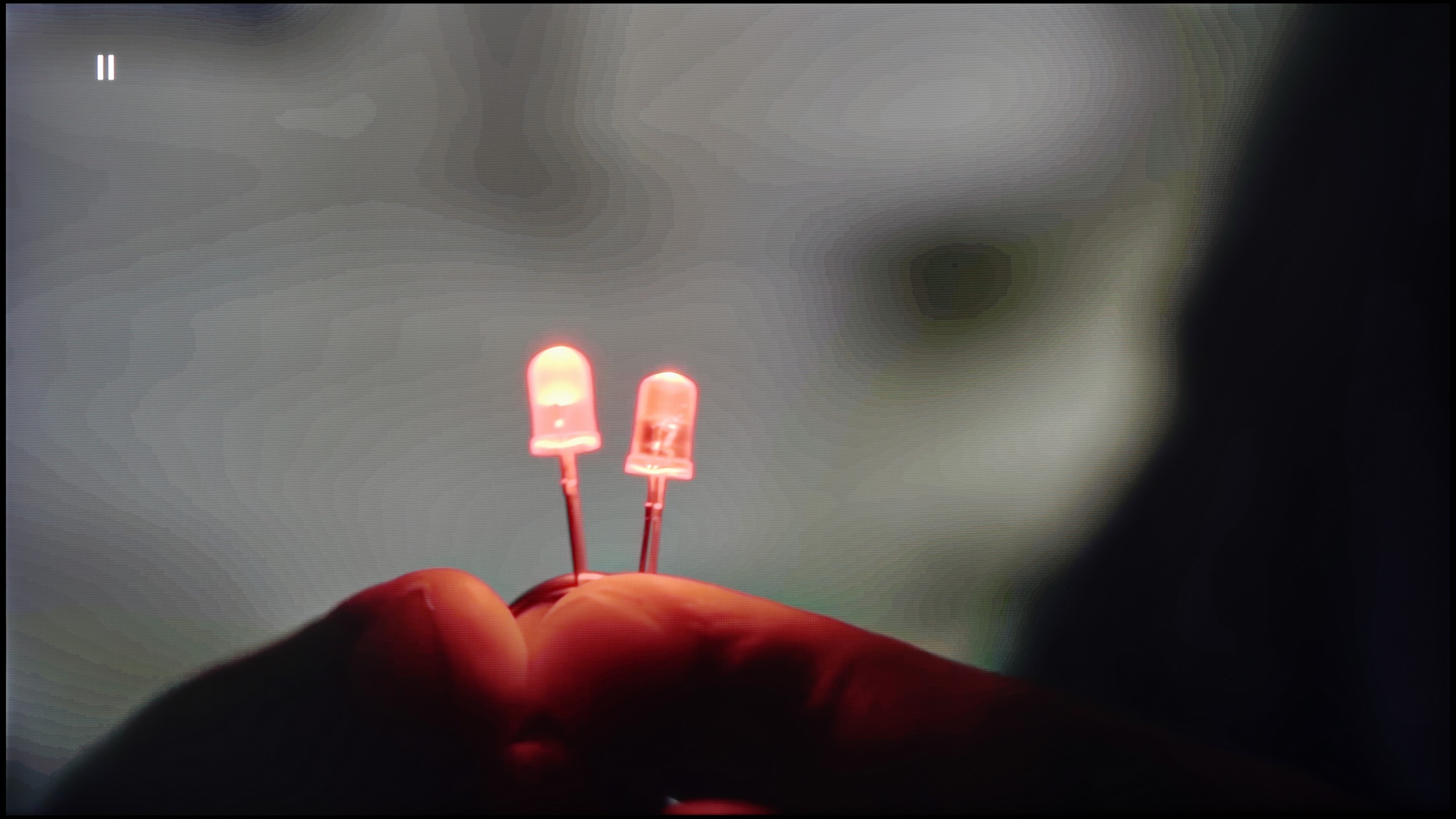
Image without overscan on the SD signal
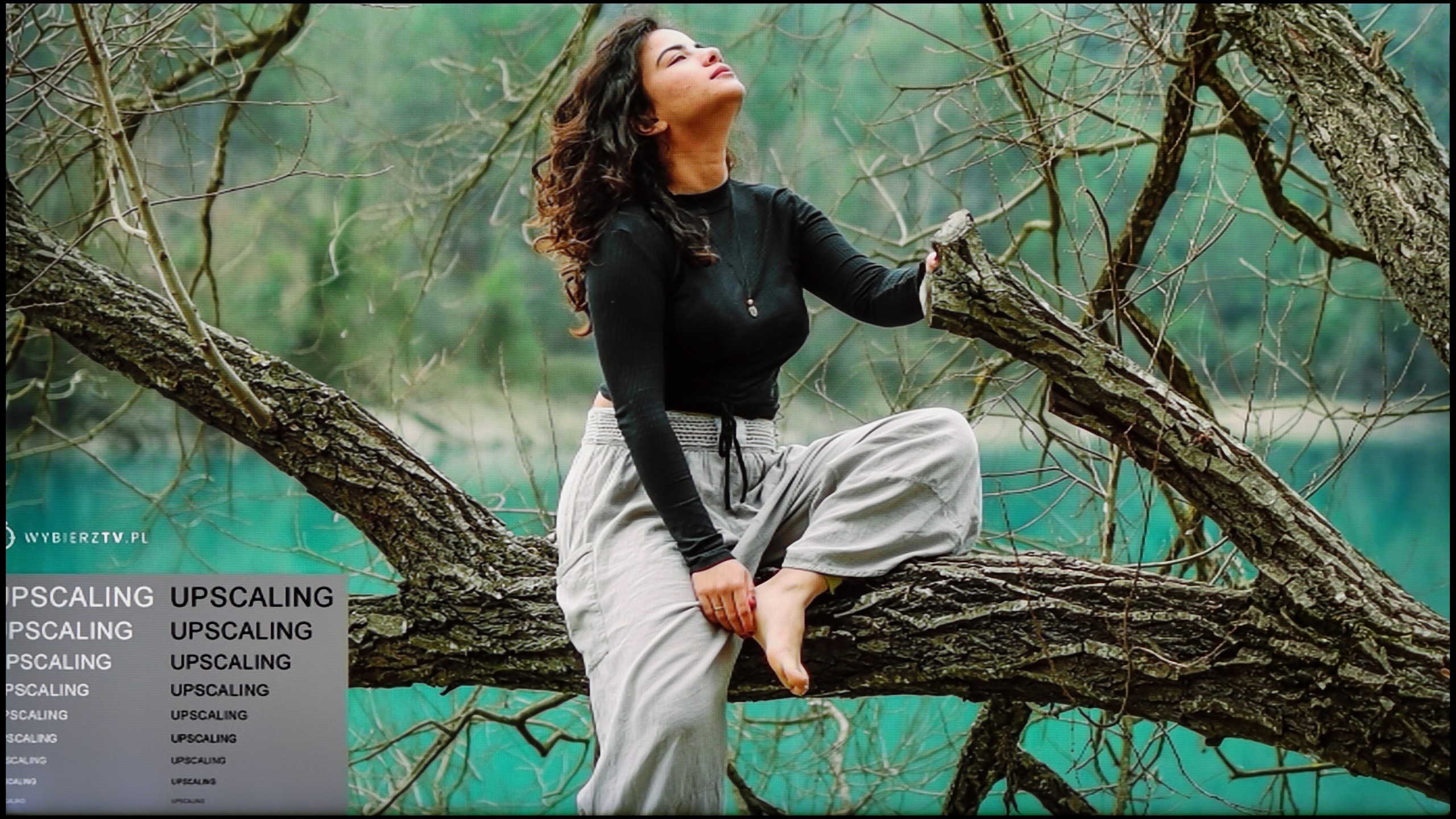

Samsung QN70F offers a distortion reduction feature that enhances the smoothness of tonal transitions. In "Standard" mode, it works quite well – it smooths out problematic transitions without significantly interfering with the structure of the image. Film grain is somewhat reduced, but details such as texture and skin structure remain visible. The "High" mode is much more aggressive. The smoothing is stronger, but it comes at the cost of a noticeable loss of detail. Therefore, in practice, we recommend sticking with the "Standard" setting or completely turning this function off. The improvement in gradation may be less spectacular, but the image retains more naturalness.
When it comes to scaling low-quality content, the QN70F performs very well. Tests with lower resolution images were really very good. Despite slight edge ringing, everything looks clean and clear, even if the original content was very poor. It’s just a pity that the television has an issue with overscan, which cannot be completely turned off. As a result, images with very low resolution may be slightly cropped, which is mainly noticeable on subtitles or interfaces.
Let’s check how the Q8F performs with older content, which often has poor quality. Let's start with the positives: the upscaling, or raising the image to a higher resolution, works really well. The television handles both traditional television and YouTube material quite competently, without giving the impression that we are dealing with something completely unattractive. It performs less well with very low resolutions, such as 576p — the image can be cropped, and unfortunately, the overscan issue cannot be turned off. Moreover, the digital processing itself appears less effective. The noise reduction feature, instead of eliminating unwanted disturbances, smooths out almost everything: film grain (which is desirable for many viewers) disappears along with the texture of the image, and the faces of the actors start to resemble characters from cheap Turkish soap operas. Therefore, it’s hard to consider this option useful — it’s best to leave it completely turned off. Perhaps Samsung will refine the operation of this function in future updates, but for now, it’s difficult to view it as anything other than an unnecessary addition.
Blur and motion smoothness
7.5/10
4.5/10
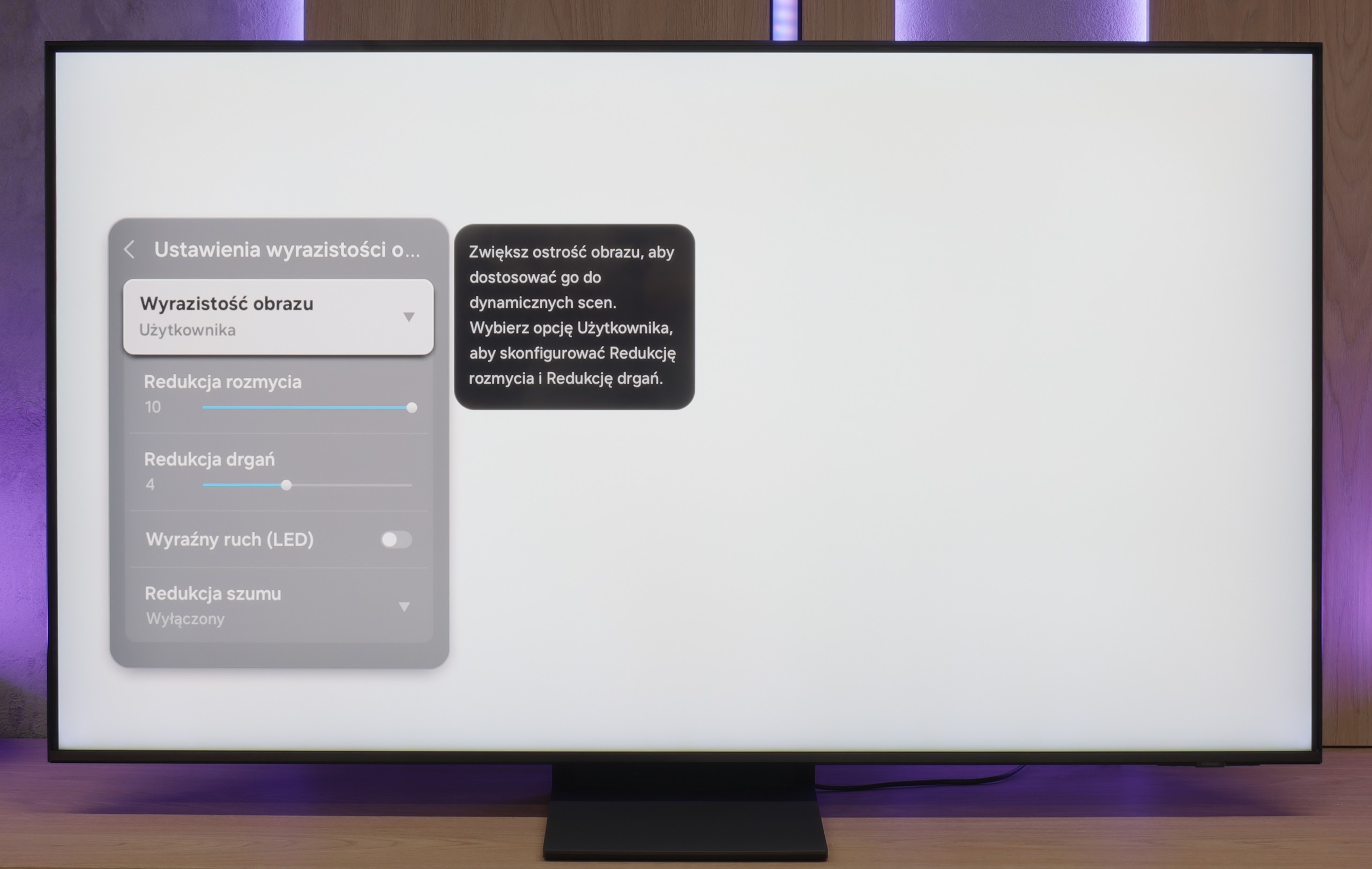
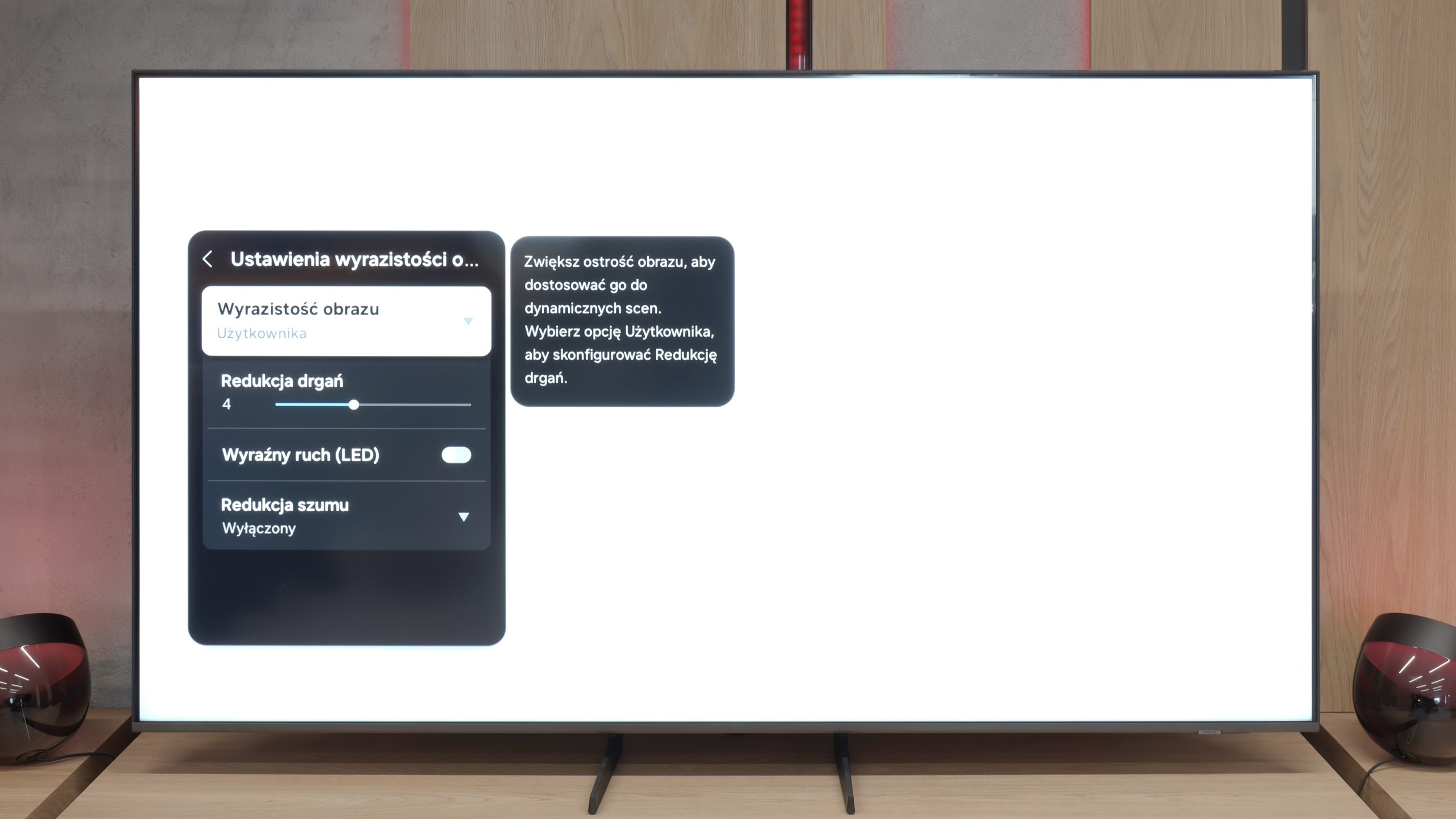
Blur (native resolution, maximum refresh rate):
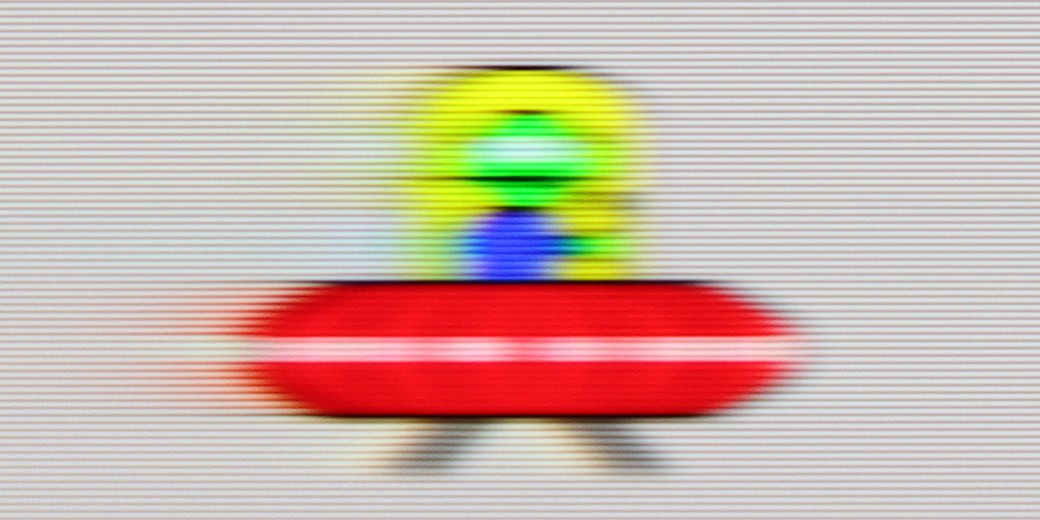
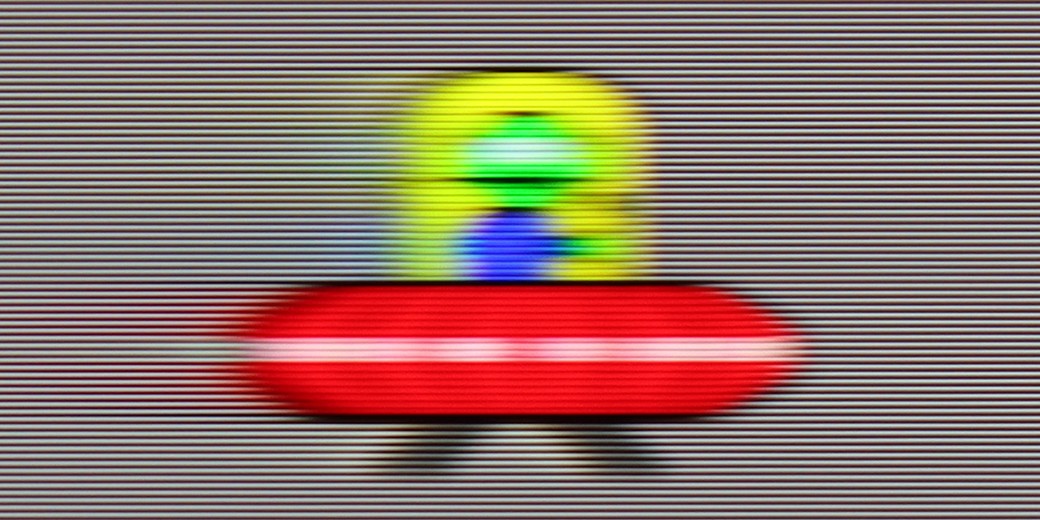
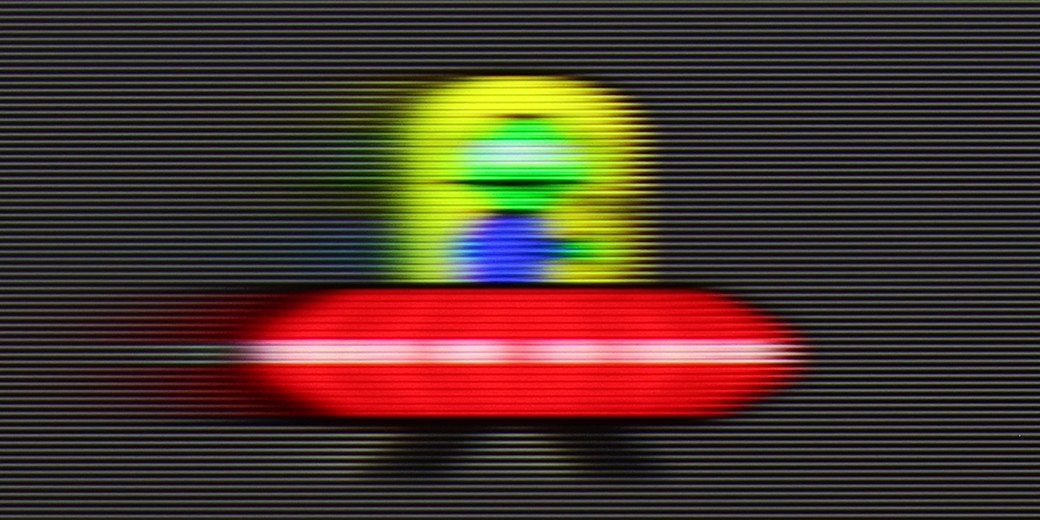
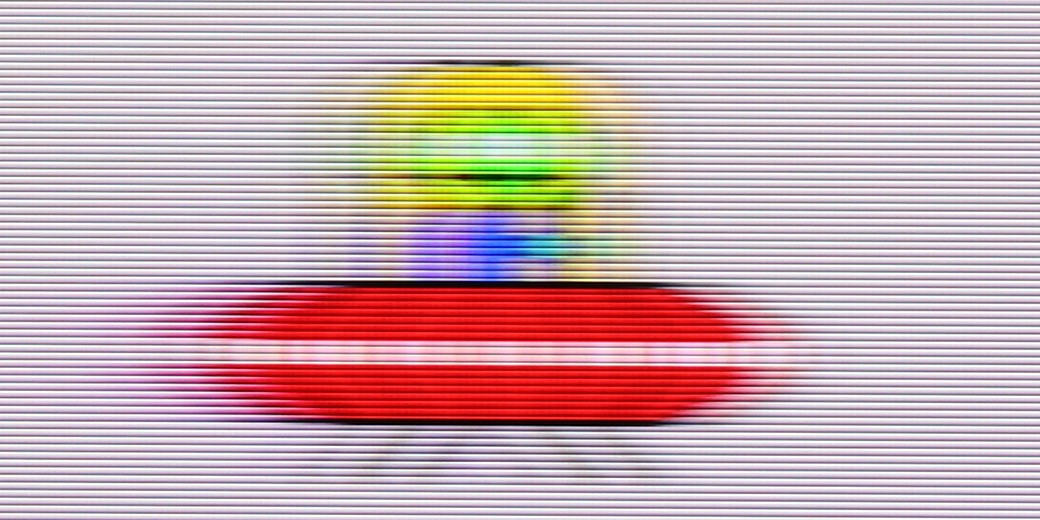
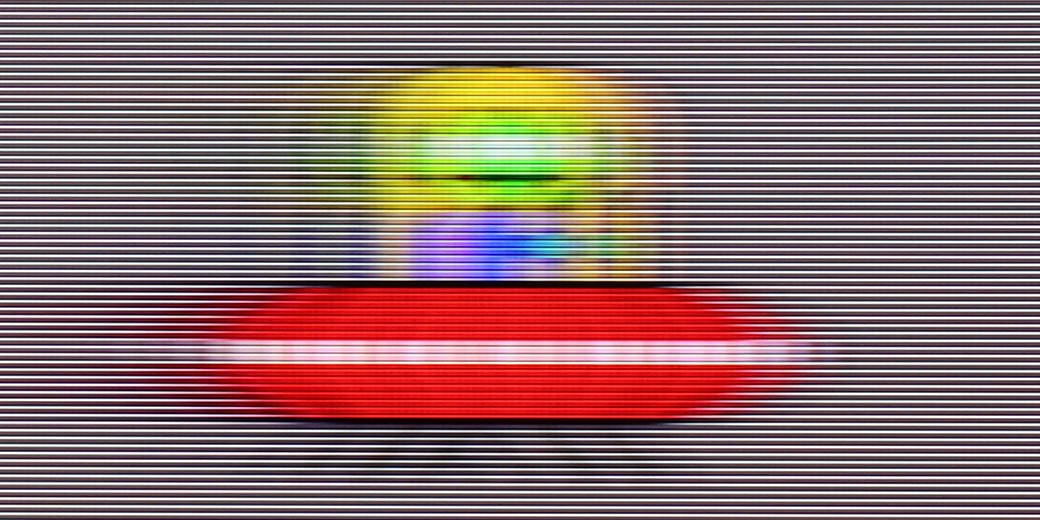
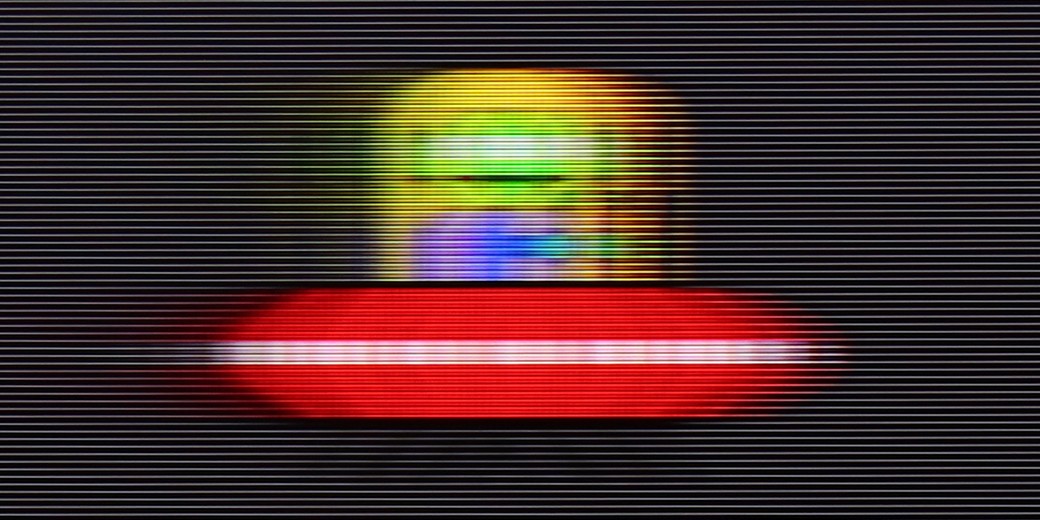
Blur (BFI function enabled):
Image flickers in this mode






Smużenie (4K 144Hz):

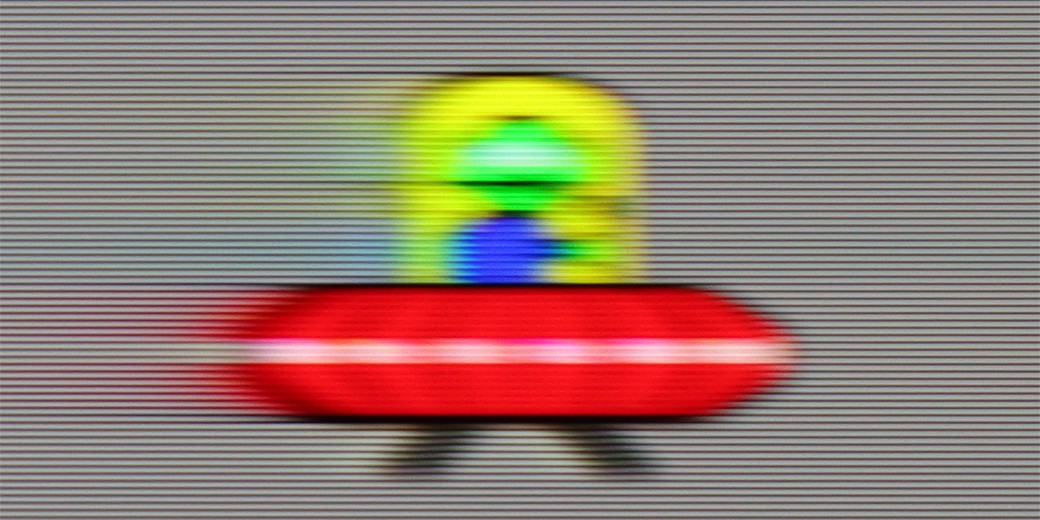
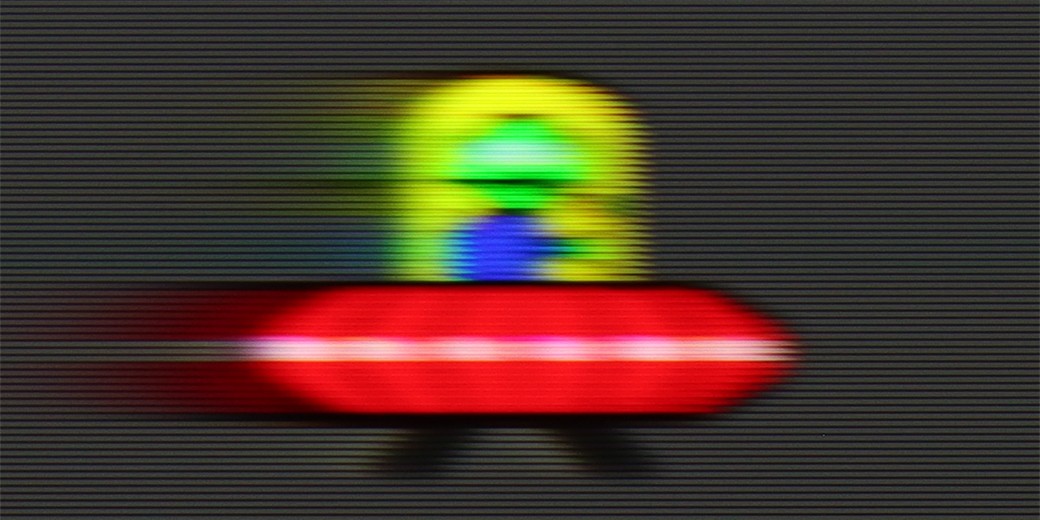
Smużenie ():
The QN70F is a television with a refresh rate of 144 Hz, which in itself places it among the top when it comes to image fluidity. Whether we are watching dynamic sports broadcasts or playing on a console – the picture looks very good. There is no sense of stuttering, choppiness, or the typical "tearing" associated with weaker models during fast motion. Samsung also allows you to adjust the fluidity to your own preferences. In the picture clarity settings, we find options such as blur reduction and judder reduction – each of which we can adjust independently. This is especially useful when watching content with a lower frame rate and wanting to give it a smoother, more theatrical character – or conversely, to maintain the natural cinematic "feel" of 24 frames.
Due to the applied 60 Hz matrix, it is difficult to call the Q8F a television designed for gaming or watching sports. The panel is not particularly fast, which makes motion blur noticeably visible. If you were hoping for spectacular, even 'stadium-like' experiences during broadcasts, you may feel slightly disappointed. Fortunately, in the case of films and series, Samsung has not abandoned the motion blur reduction feature. This is nothing but a motion smoother that allows you to improve the fluidity of productions recorded at 24 or 30 frames per second. This way, you can decide for yourself whether you prefer a smoother, 'television' image or to maintain a cinematic character. It all depends on the viewer's preferences, and the ability to adjust this parameter is undoubtedly a plus.
Console compatibility and gaming features
8.2/10
3.7/10
- ALLM
- VRR
- VRR range48 - 144Hz
- Dolby Vision Game Mode
- Correct implementation of HGIG
- 1080p@120Hz
- 1440p@120Hz
- 4K@120Hz
- Game bar
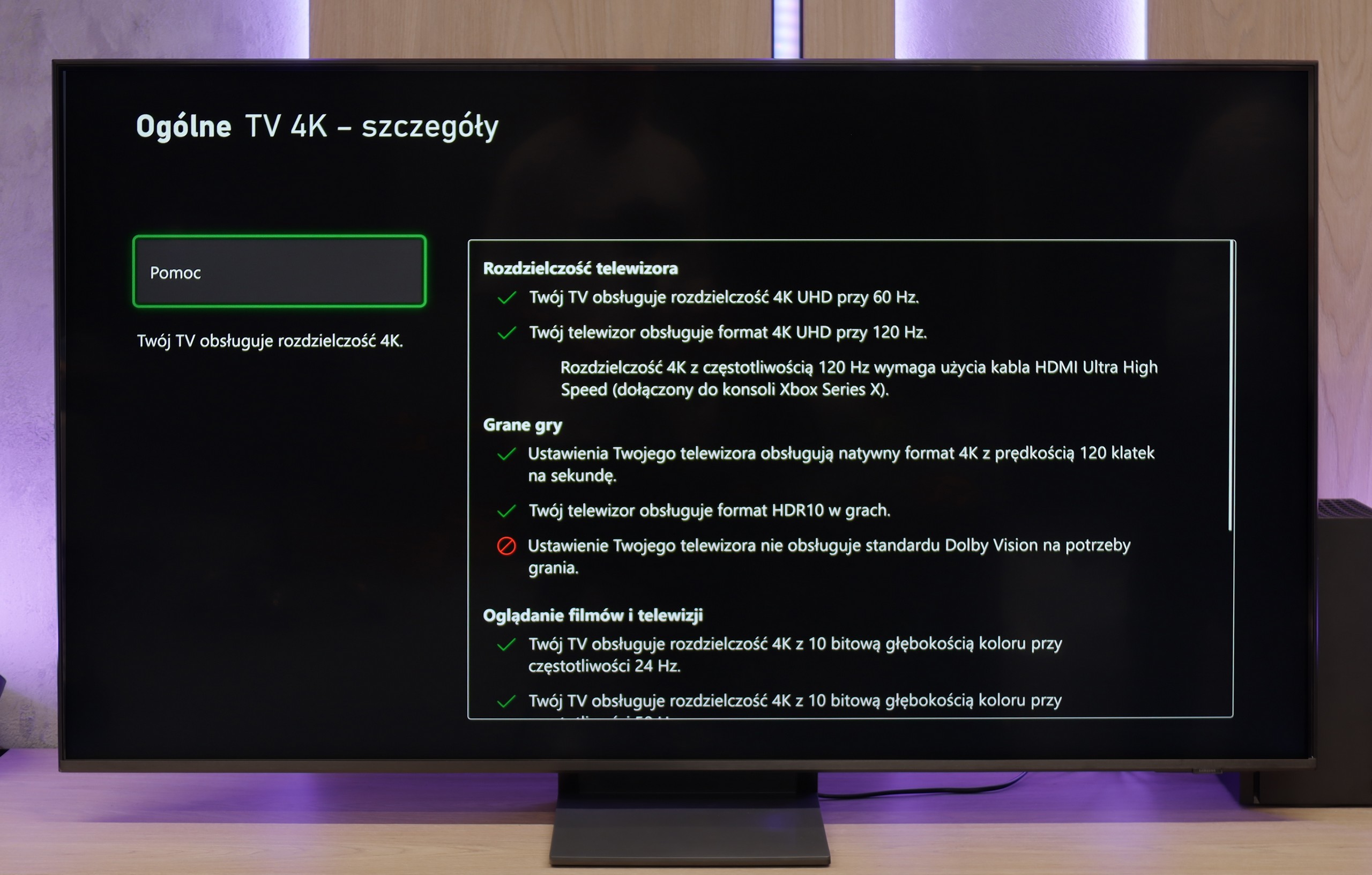
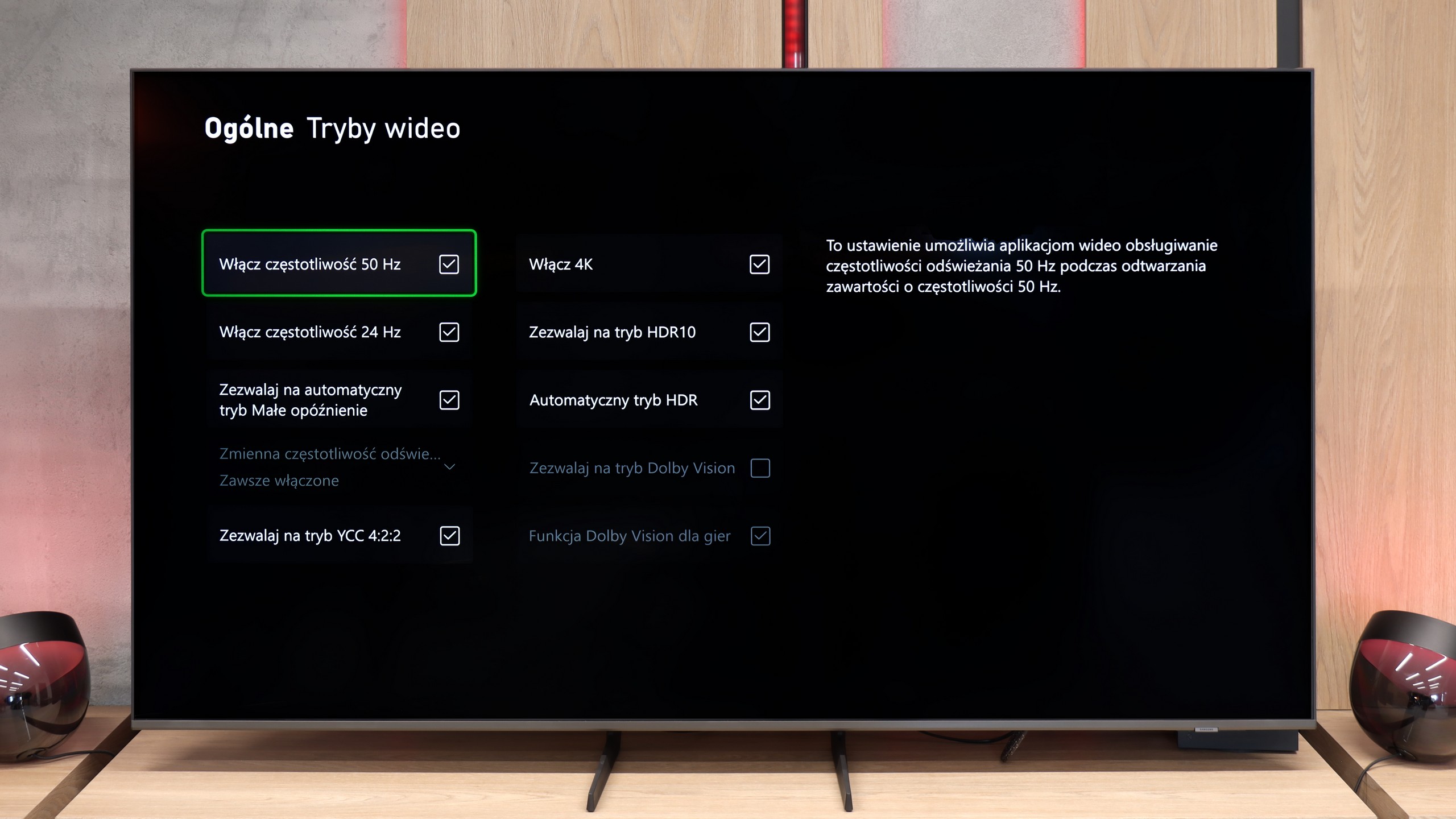
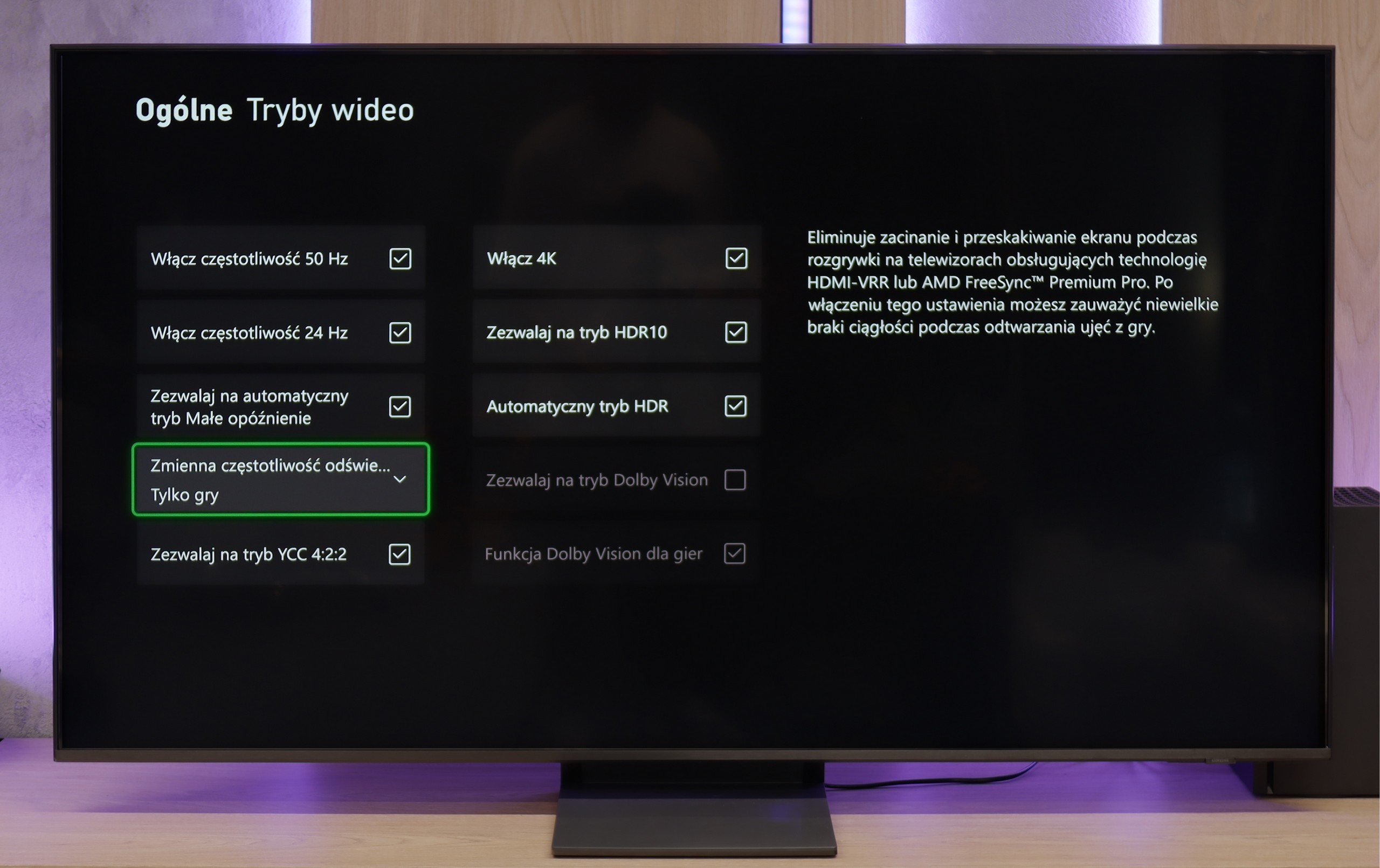
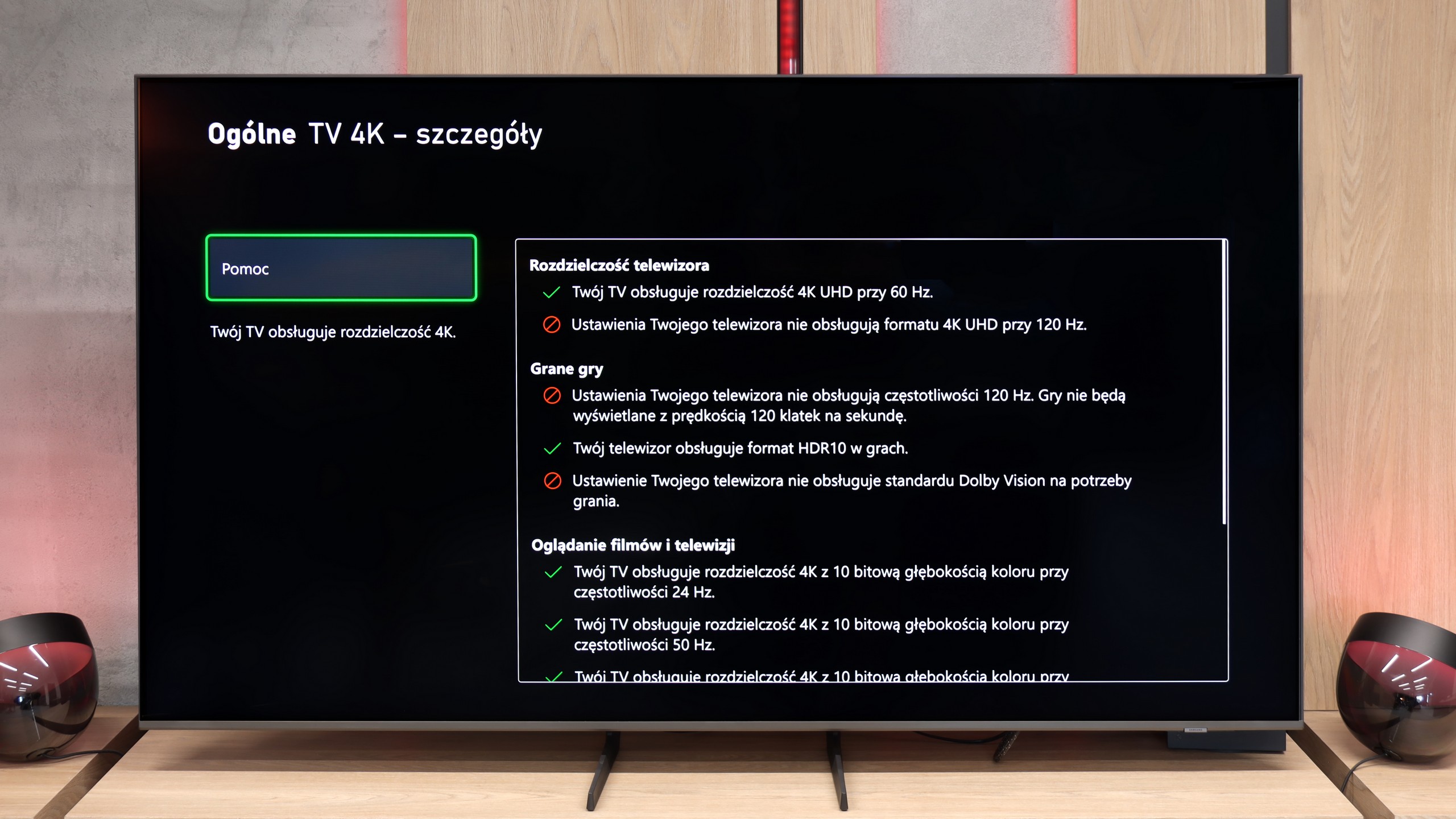
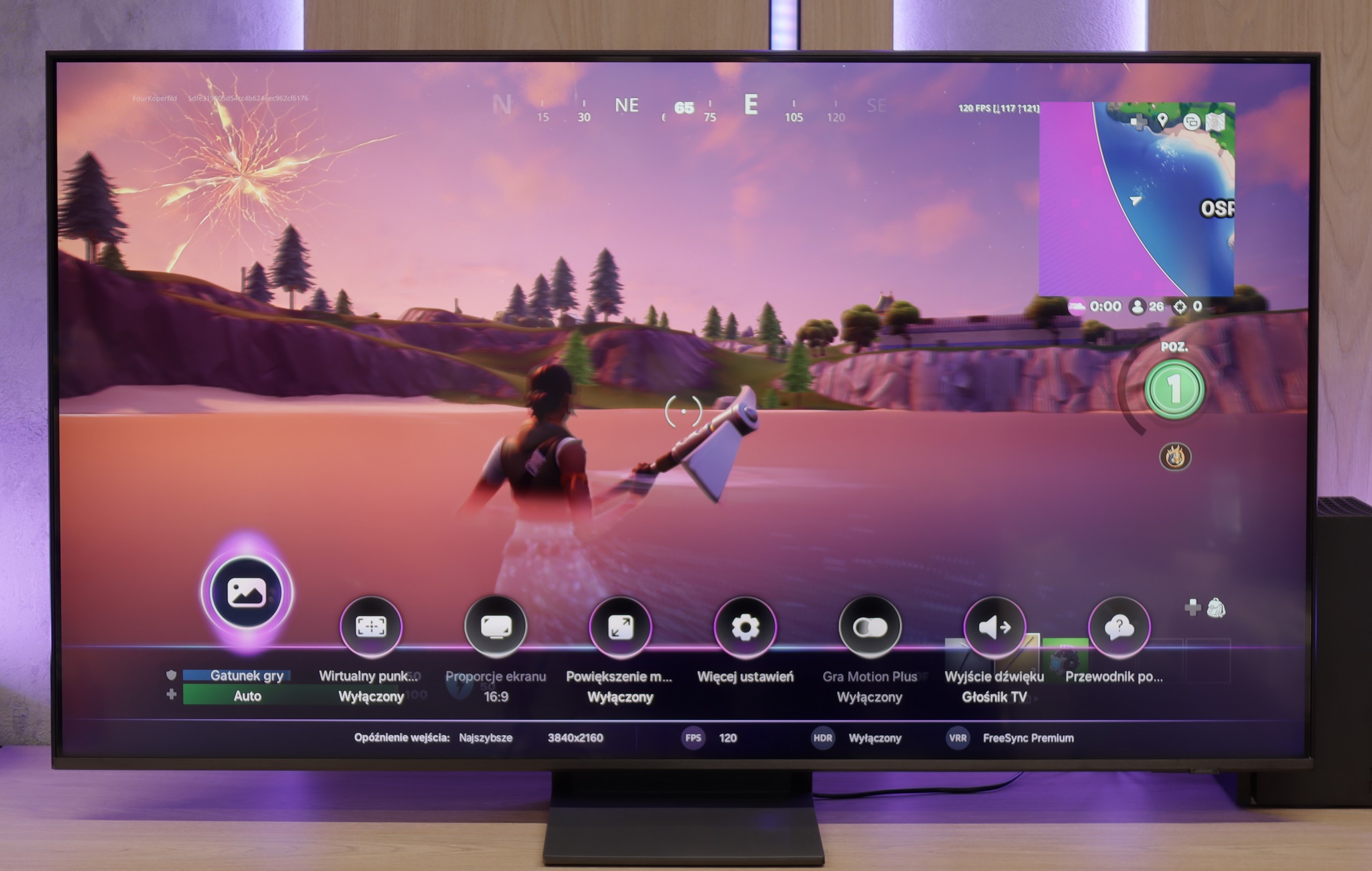
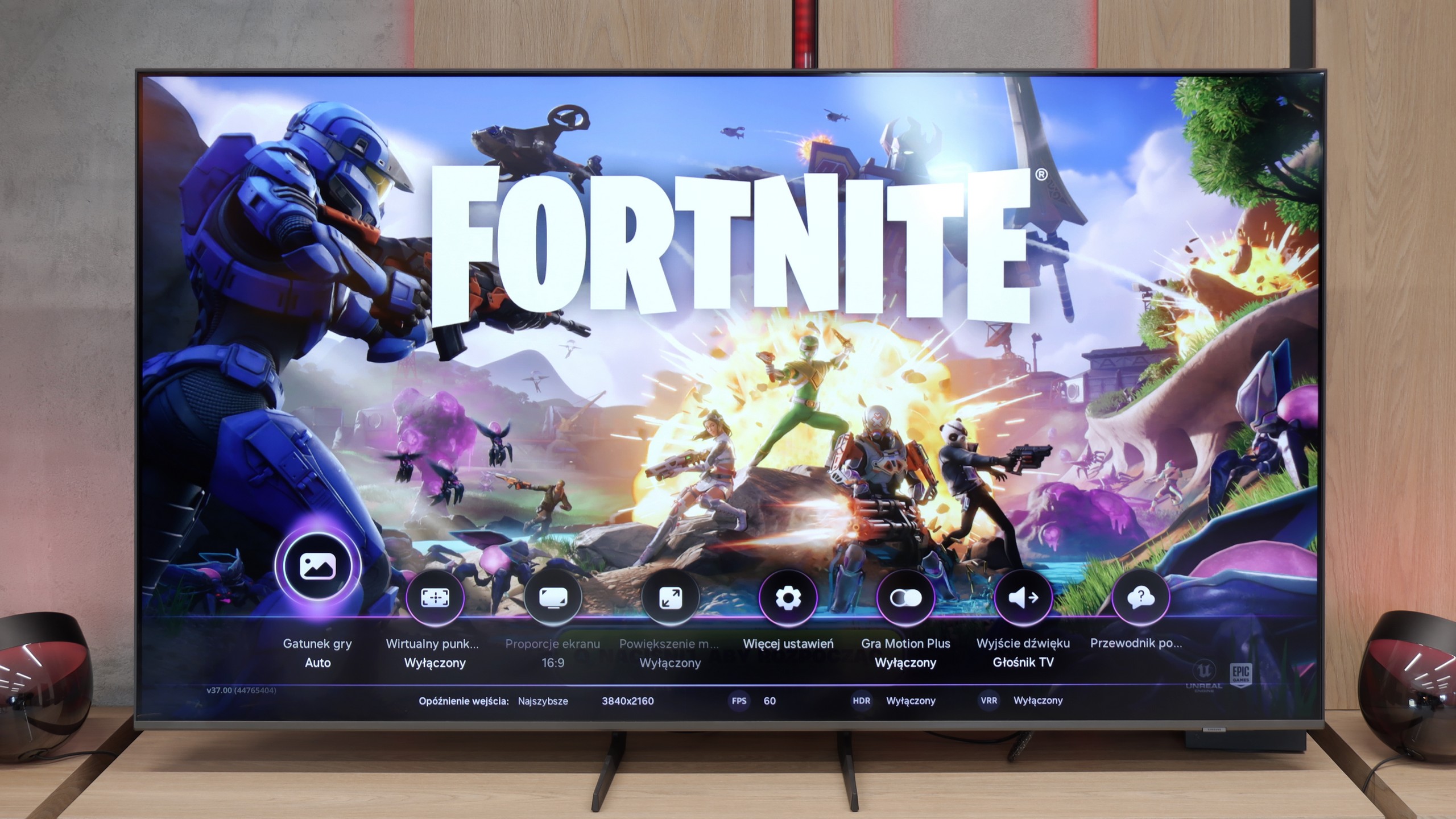
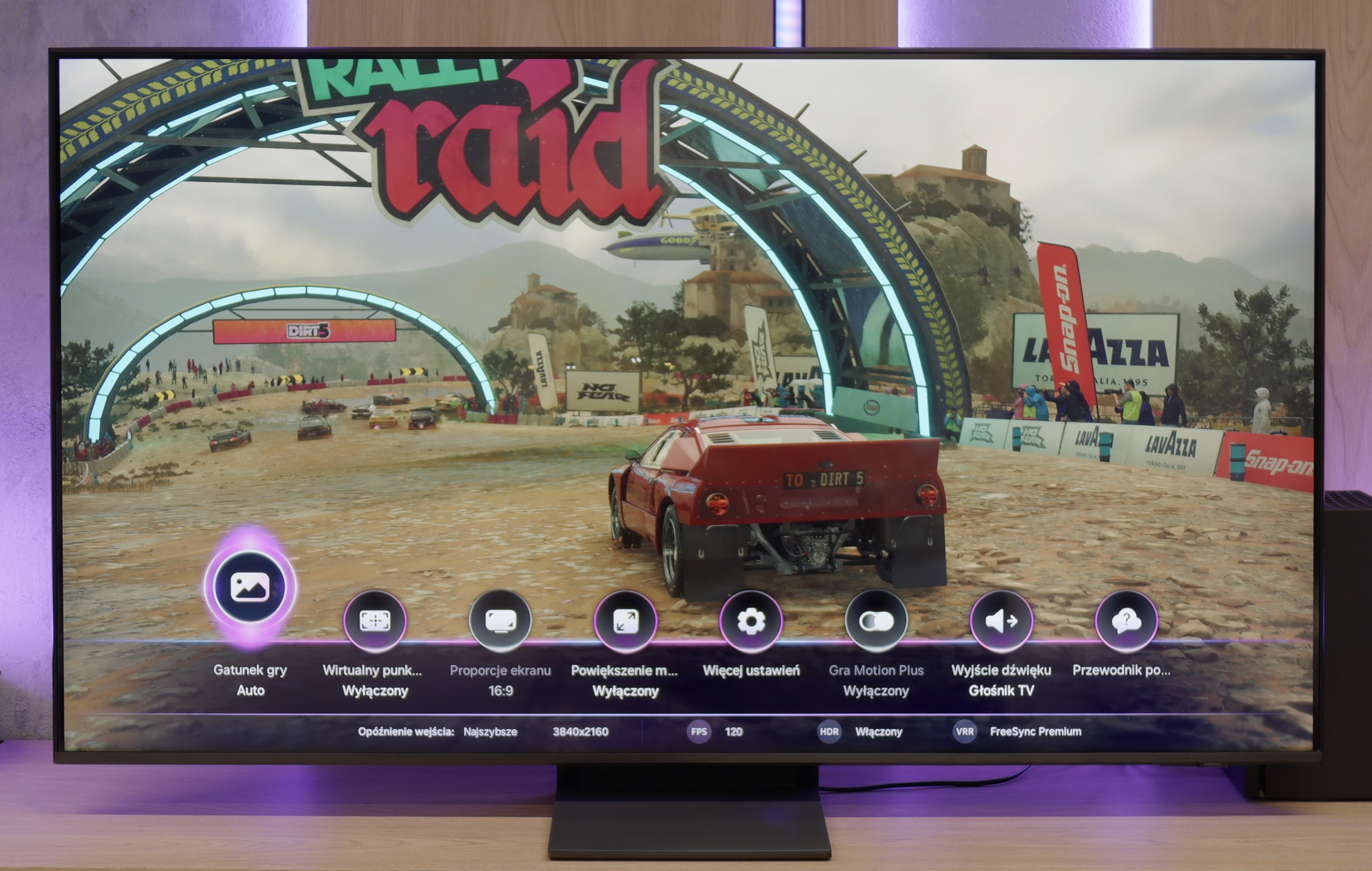
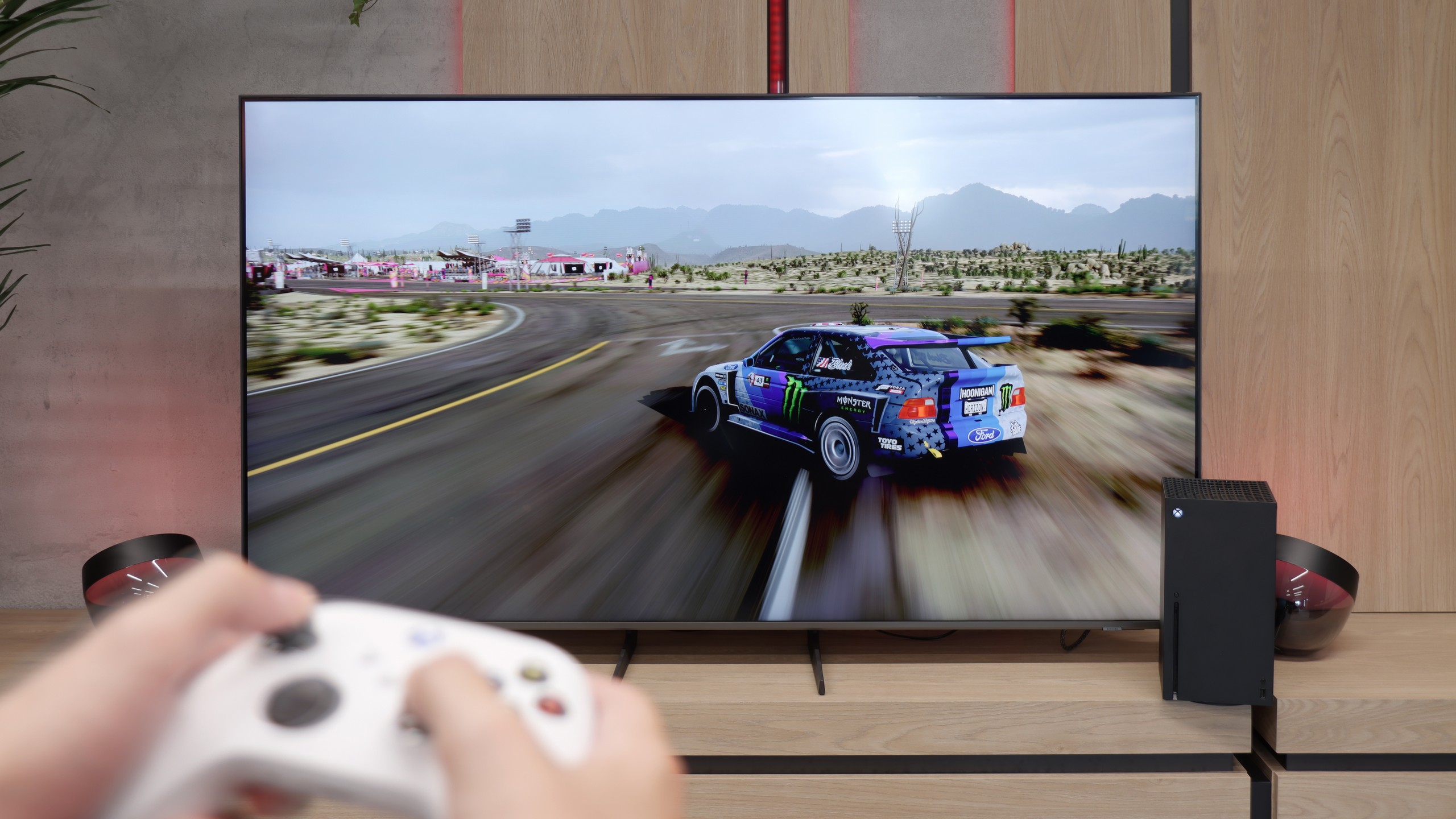
The Samsung QN70F is truly a solid choice for gamers. Here, we find as many as four HDMI 2.1 ports with full bandwidth of 48 Gbps, meaning full support for gaming in 4K at a refresh rate of 144 Hz. Additionally, it includes all the essential features we expect today: automatic game mode (ALLM), variable refresh rate (VRR), and a very well-designed, intuitive Game Bar showing information about mode, resolution, and frame rate.
Also noteworthy is the Game Motion Plus feature, which allows artificial frames to be added to games running at 60 fps or less. This works surprisingly well and in many titles – particularly those where consoles struggle to maintain a stable framerate – it improves the fluidity of gameplay without significant delay.
Unfortunately, there are some drawbacks. The lack of support for Dolby Vision mode is not surprising – it’s a standard with Samsung. However, the absence of the HGiG feature is much more disappointing. Worse still, it was removed with a software update, which may leave users who previously relied on it quite puzzled. Without HGiG, it is impossible to manually set the maximum HDR brightness from the console, resulting in some games appearing slightly washed out – especially if the television misinterprets the tonal range. Why Samsung, a brand that has set standards for gaming features for years, decided to take such a step is hard to say. At the time of writing this review, the tested television was running on software version 1110 – and frankly, if you care about full support for gamers, it’s better to hold off on updates for the time being.
It is not entirely clear what Samsung has meddled with this year regarding its televisions, but the Q8F is not free from all the confusion surrounding updates and shortcomings. While its older cousin, the Q67D, could still be recommended to casual gamers with a clear conscience, it is difficult to find a reason to do so here. Apart from the automatic game mode and the attractively designed Game Bar, we receive practically nothing that could attract gaming enthusiasts. The lack of proper HGiG implementation is a significant issue, especially since after the 1126 update, the feature simply disappeared. The situation regarding VRR is even worse. Although it is listed in the manufacturer's brochures and appears in the Game Bar, we were unable to activate it. The Xbox Series X console did not allow activation at all, and the option remained greyed out and inactive. It is hard to praise such a television even to casual gamers, which is a pity, as Samsung had a strong bargaining chip in the gaming segment for years.
Input lag
10/10
9.9/10
SDR
HDR
Dolby Vision
QN70F does not disappoint in terms of response time either. For 120 Hz materials, the input lag hovers around 8 ms, which can be considered a very good result – especially in the context of online competition or dynamic action games. The screen responds to the movements of the controller almost instantaneously, with no noticeable delay. As a result, the gameplay is smooth and comfortable, even in more demanding titles. In this category, Samsung still maintains a high standard, and it is hard to find anything that could raise objections.
Fortunately, in terms of gaming, Samsung did not attempt to 'enhance' anything and the input lag remained at an excellent level. Results hovering around 10–15 ms mean that delays are practically imperceptible. The controls are instant, and the responses from the console or computer appear on the screen with no noticeable delay. In this respect, the Q8F performs excellently and it is difficult to fault it in any way.
Compatibility with PC
8.2/10
6/10
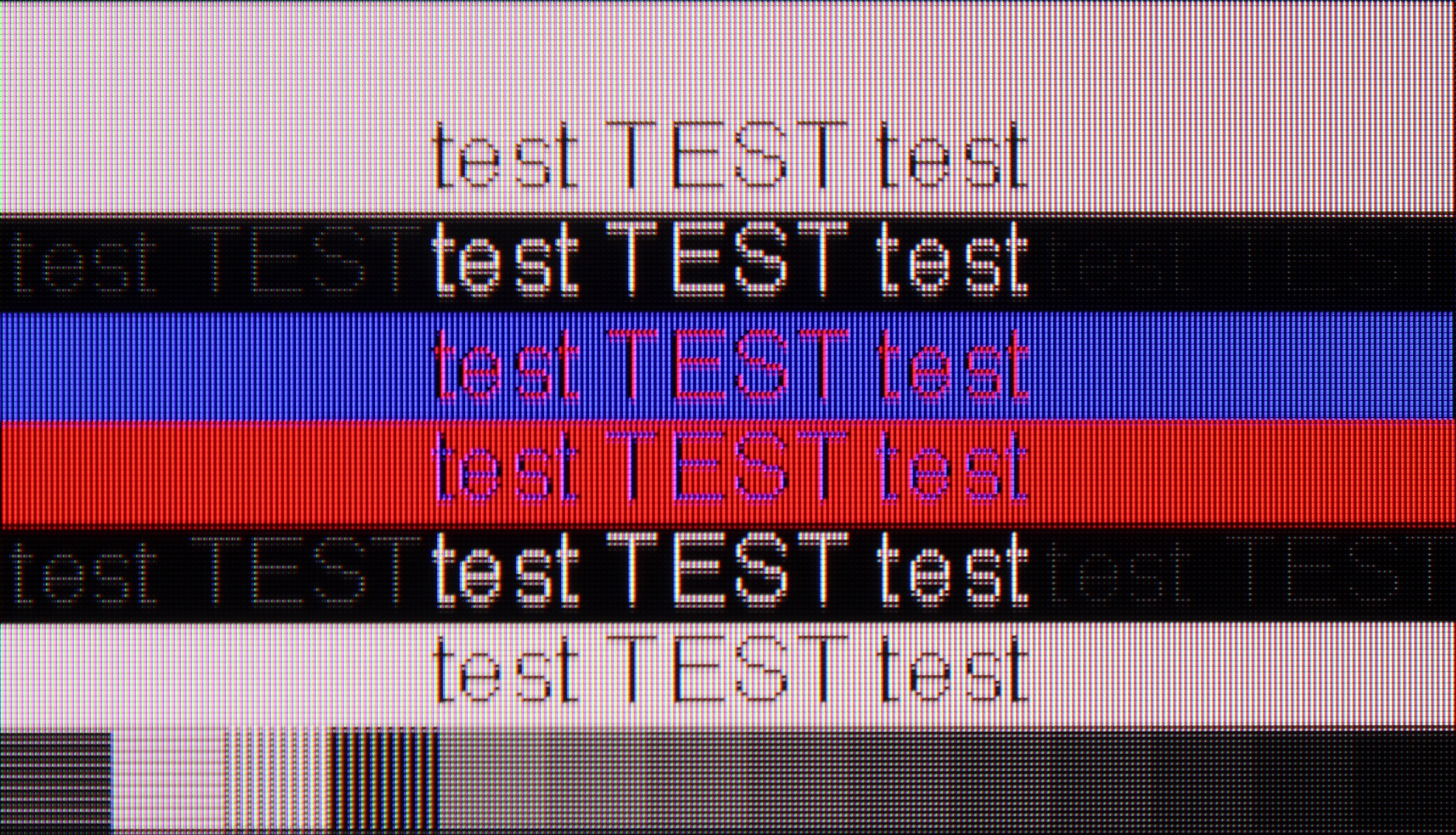
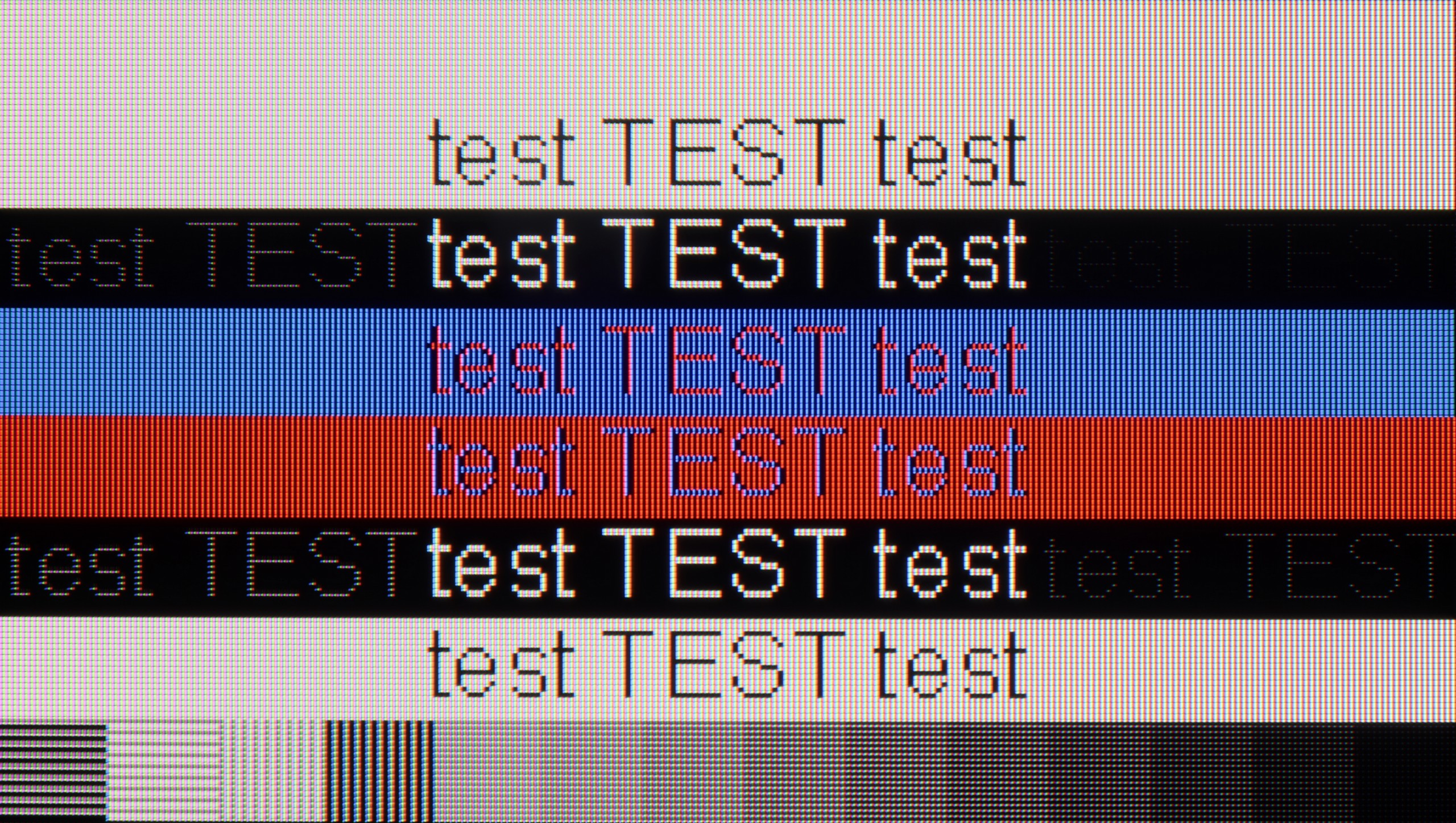
Let's start with the best aspect of connecting the QN70F to a computer – gaming. A refresh rate of 144 Hz, support for G-Sync compatible VRR, and very low input lag create the perfect recipe for an almost ideal screen for PC gamers. In this role, the QN70F truly does not disappoint – games look smooth, responsiveness is at a very high level, and everything runs stably.
However, the performance regarding text work is somewhat lacking. At a resolution of 4K and a refresh rate of 144 Hz, there is a noticeable blurriness in the font contours – text may appear slightly smeared, with a slight “layering” of the contours. This is not a problem that undermines the usability of the QN70F as a monitor, but individuals planning to do office work or text editing on this screen should keep this in mind.
Although gaming on the Q8F is not particularly attractive — there are no modes with lower resolution and higher refresh rates, and it also has issues with VRR (G-Sync) as well as a limitation of the panel to 60 Hz — it performs excellently as a work monitor. The readability of the fonts is very high, so working with text or Excel spreadsheets is a pure pleasure. In this regard, the Q8F can be a real alternative to a large office monitor.
Viewing angles
3.1/10
3.4/10
As for the VA panel, the viewing angles on the QN70F are typical – meaning rather average. The image quickly loses contrast and saturation when we start looking at the screen from a greater angle. Compared to IPS panels, it performs significantly worse. On the other hand – thanks to this panel, we gain better blacks and higher contrast when viewing straight on, which will be more important for many users than wide visibility from the sides.
The viewing angles on the Q8F can be described as average, which is due to the use of a VA panel. When watching the television straight on, the picture looks very good, but just moving slightly to the side causes it to start fading and losing contrast. Colours gradually lose their saturation, and black takes on a shade of grey. This is a typical limitation of this type of panel, and one cannot expect miracles here. Compared to IPS panels, the difference is clear — although they are weaker in contrast, they hold colour better at an angle. The Q8F will perform best in a classic setup, where viewers are seated centrally in front of the screen. If you plan to watch with a larger group, with people spread out across the living room, the effect may not be as satisfying.
TV efficiency during daytime
6.3/10
5.6/10
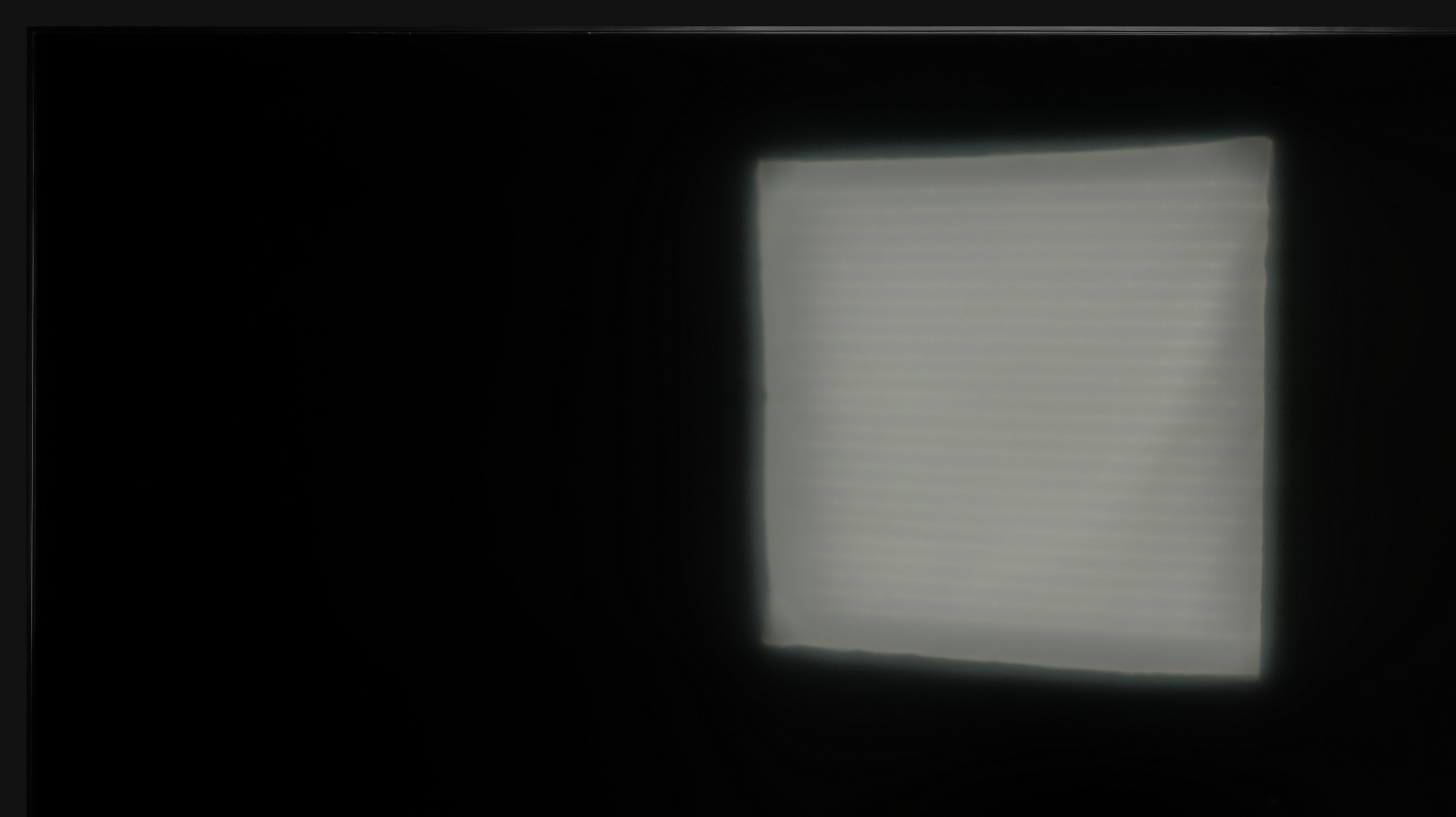
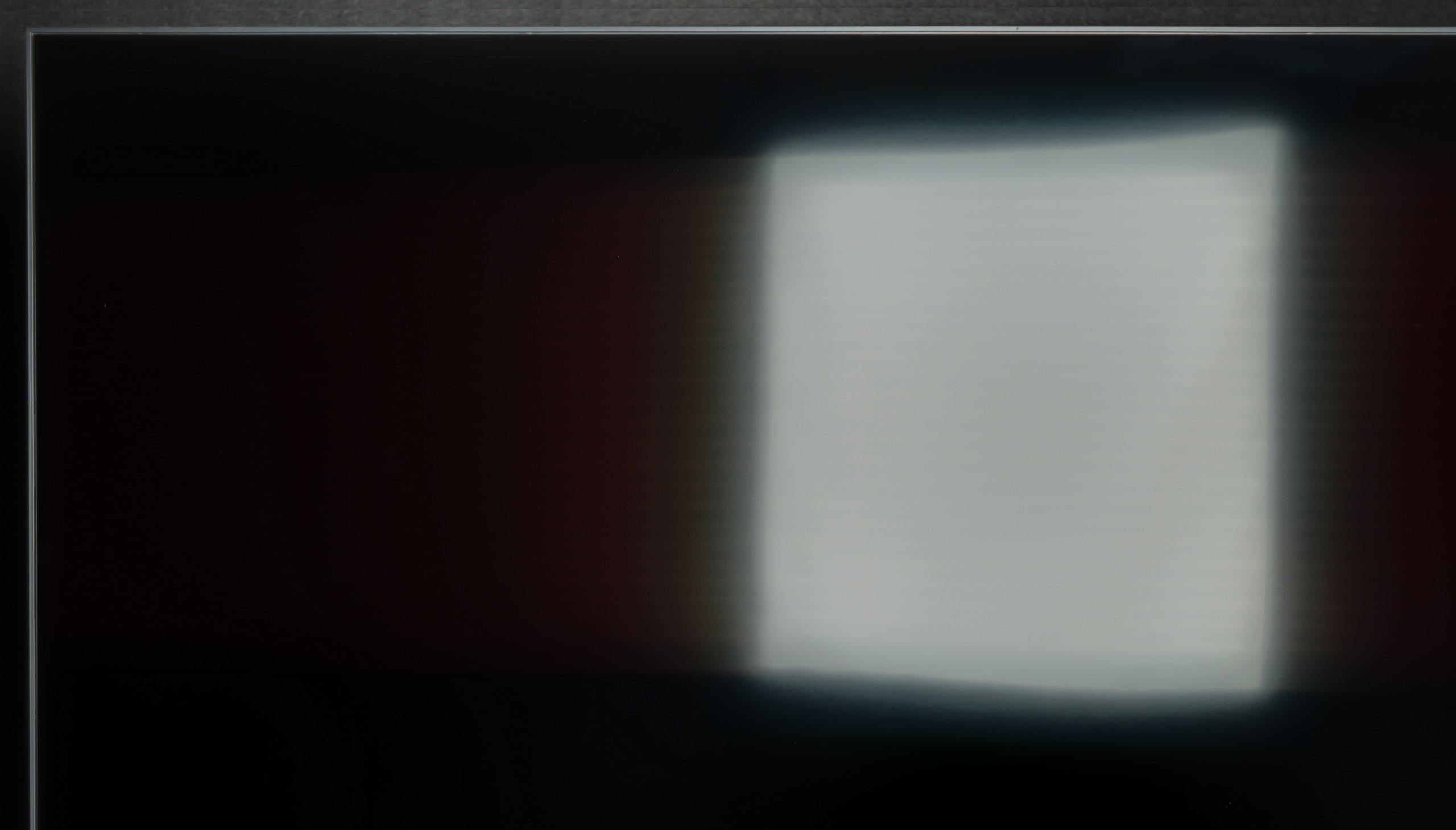

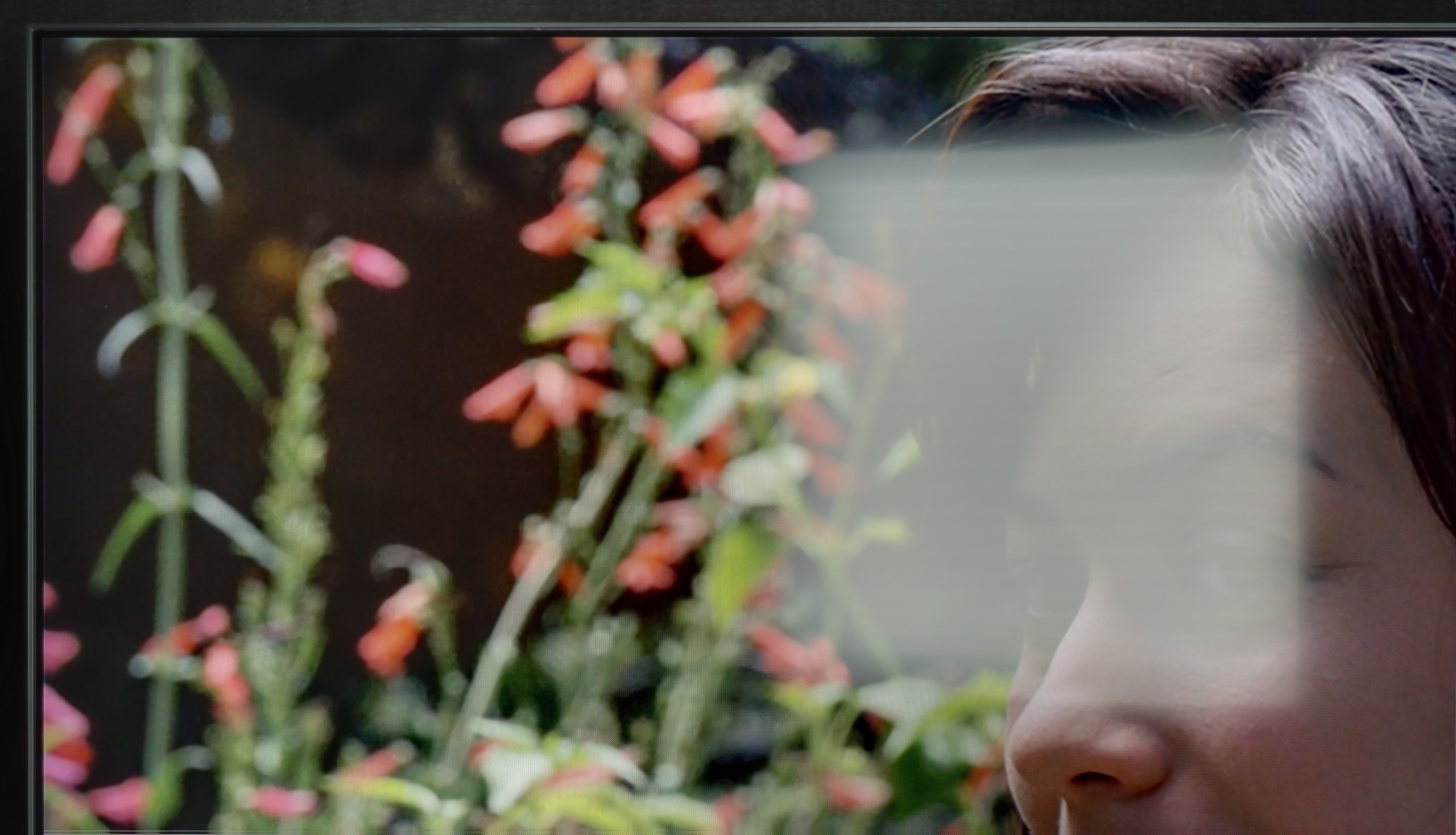
Matrix brightness
Average luminance SDR
Samsung Q8F: 430 cd/m2
Samsung Neo QLED QN70F / QN74F / QN77F: 492 cd/m2
The QN70F handles a bright living room without any issues. The screen has a satin finish that effectively suppresses reflections, so there's no need to immediately draw the curtains to see anything. Even when there's plenty of light in the room – for example, with a window to the side – the picture still looks clear and vibrant. The brightness is also at a solid level. In SDR mode, the television averages around 500 nits, which is more than sufficient for daytime viewing. While it may not reach the levels of top models, in practice – for everyday television watching, sports, or YouTube – it performs very well.
The Q8F performs quite well during the day. Its brightness hovers around 450 nits, which proves to be a sufficient level for moderately bright living rooms. It is not a television that will win a battle against sunlight streaming directly through the window, but under typical home conditions, the picture remains clear and appealing. A significant advantage is the satin finish of the panel, which effectively reduces reflections and helps maintain colour saturation even when the room is bright. As a result, watching series during the day or evening sports broadcasts with the lights on poses no problems. The Q8F does not aspire to be a cinema television in full sunlight, but as an everyday screen in normal home conditions, it performs really well.
Details about the matrix
Subpixel Structure:
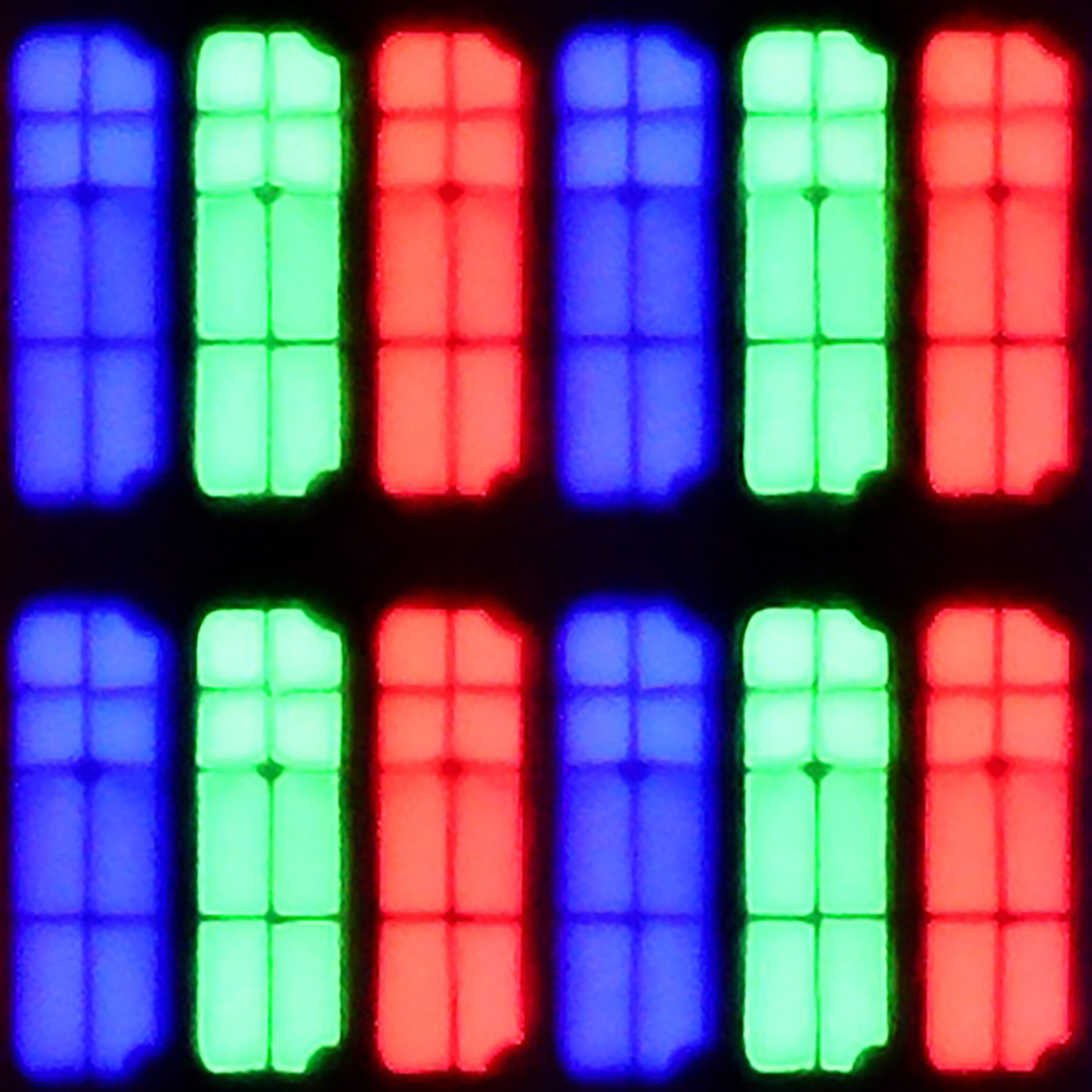
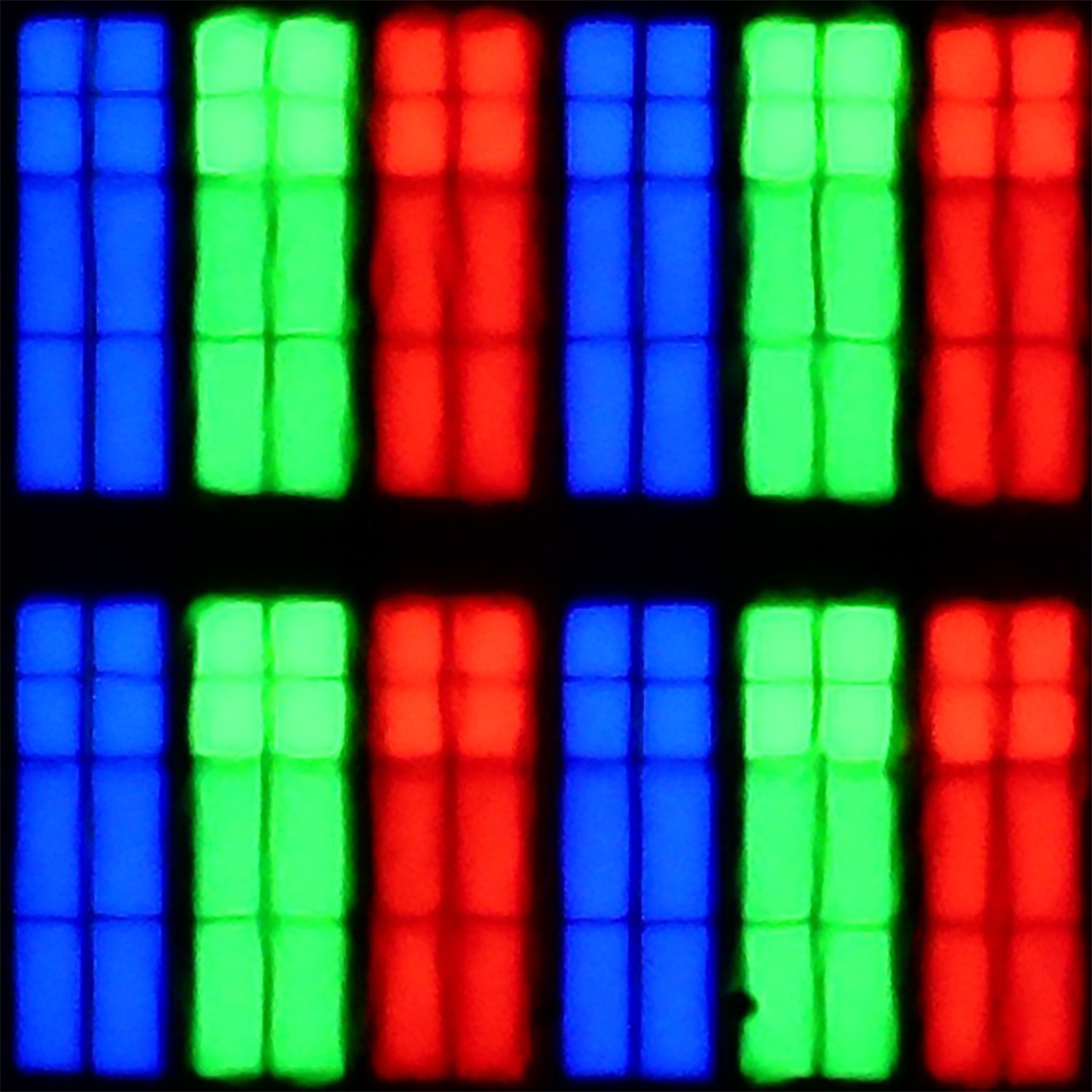
Panel uniformity and thermal imaging:
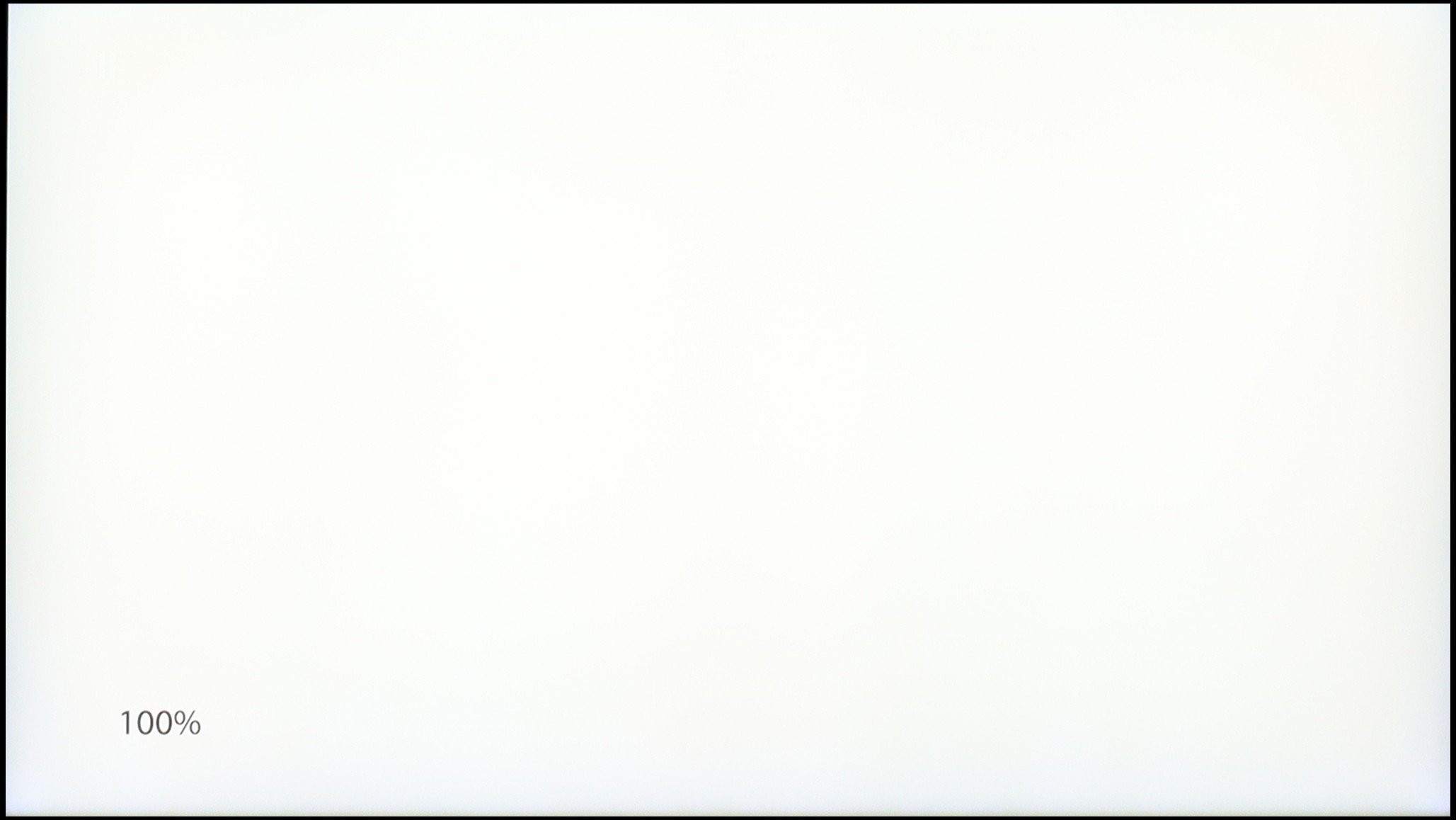
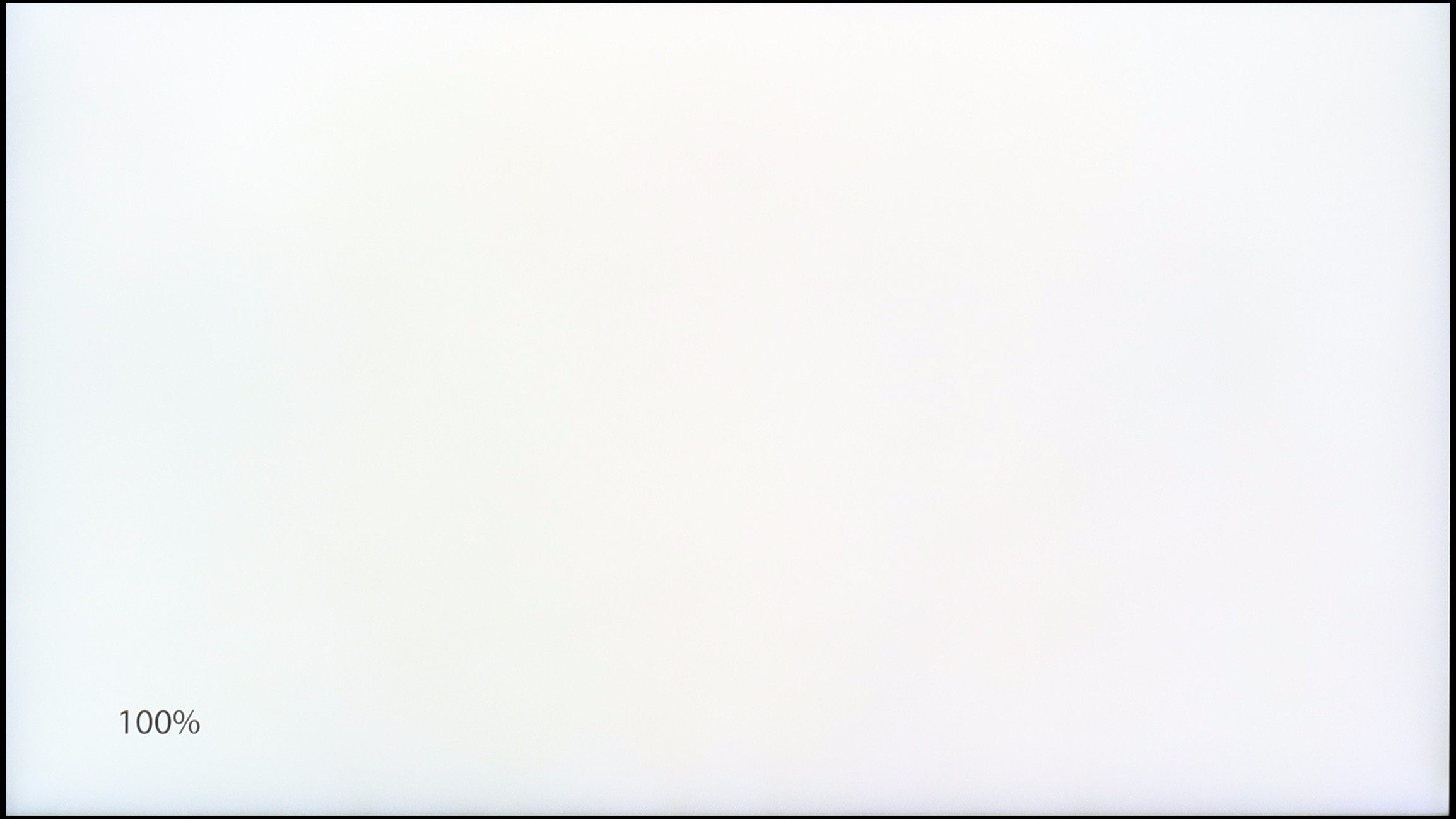
Samsung Neo QLED QN70F / QN74F / QN77F
Samsung Q8F
TV features
7.2/10
7.3/10
- HDMI inputs0 x HDMI 2.0, 4 x HDMI 2.1 48Gbps3 x HDMI 2.0, 0 x HDMI 2.1
- OutputsToslink (Optical audio), eARC (HDMI), ARC (HDMI)Toslink (Optical audio), eARC (HDMI), ARC (HDMI)
- Network InterfacesWi-Fi 2.4GHz, Wi-Fi 5GHz, Ethernet (LAN) 100MbpsWi-Fi 2.4GHz, Wi-Fi 5GHz, Ethernet (LAN) 100Mbps
- TV receptionDVB-T, DVB-T2, DVB-S, DVB-S2, DVB-CDVB-T, DVB-T2, DVB-S, DVB-S2, DVB-C
Classic features:
- Recording to USB (terrestrial TV)
- Recording programming
- Picture in Picture (PiP)
- RF remote control (no need to aim at the screen)
- Backlit remote control
- Teletext
- Audio only mode
- Bluetooth headphones support
- Simultaneous Bluetooth headphones & TV audio
Smart features:
- AirPlay
- Screen mirroring (Windows Miracast)
- Voice search
- Voice search in native language
- Ability to connect a keyboard and mouse
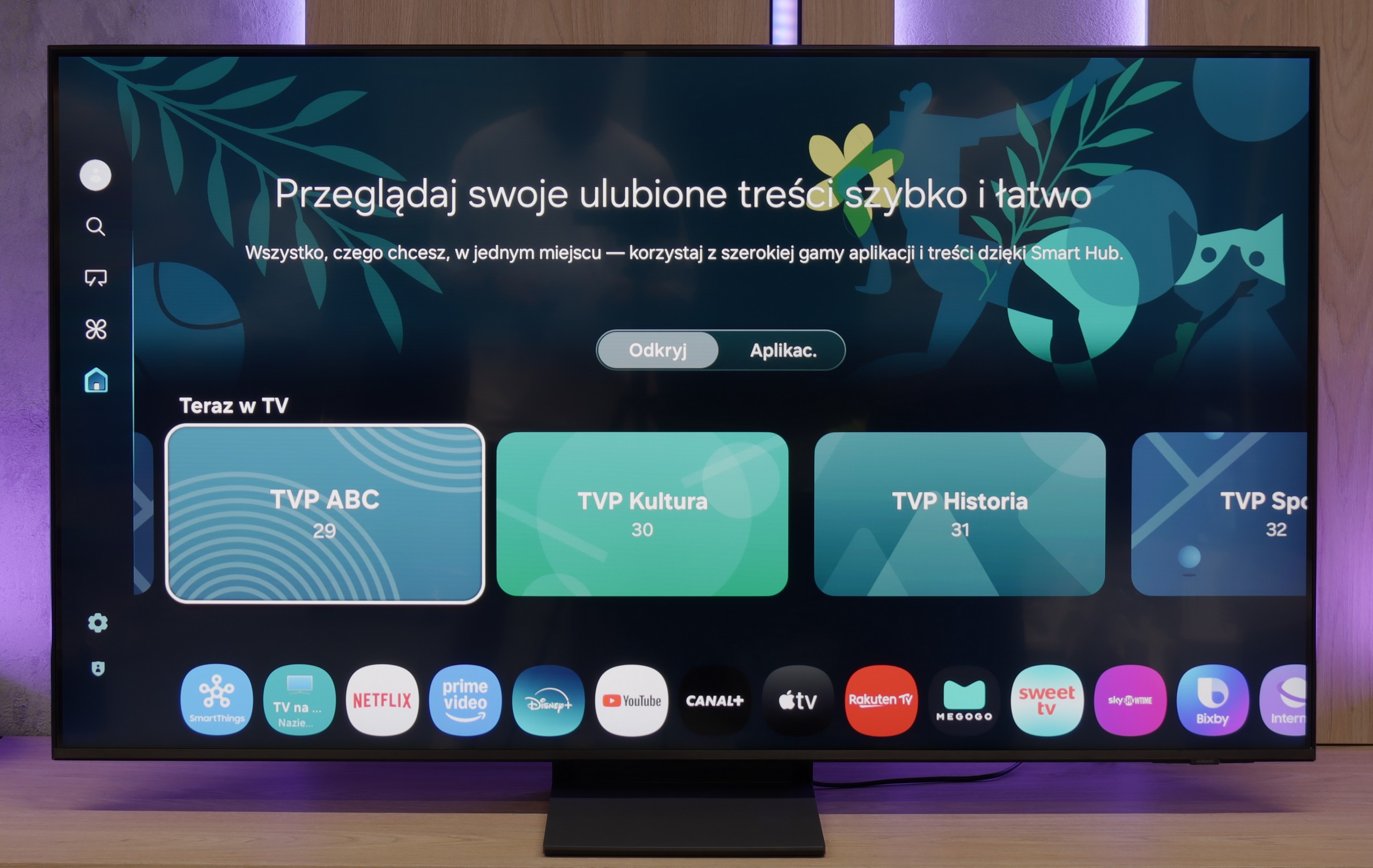
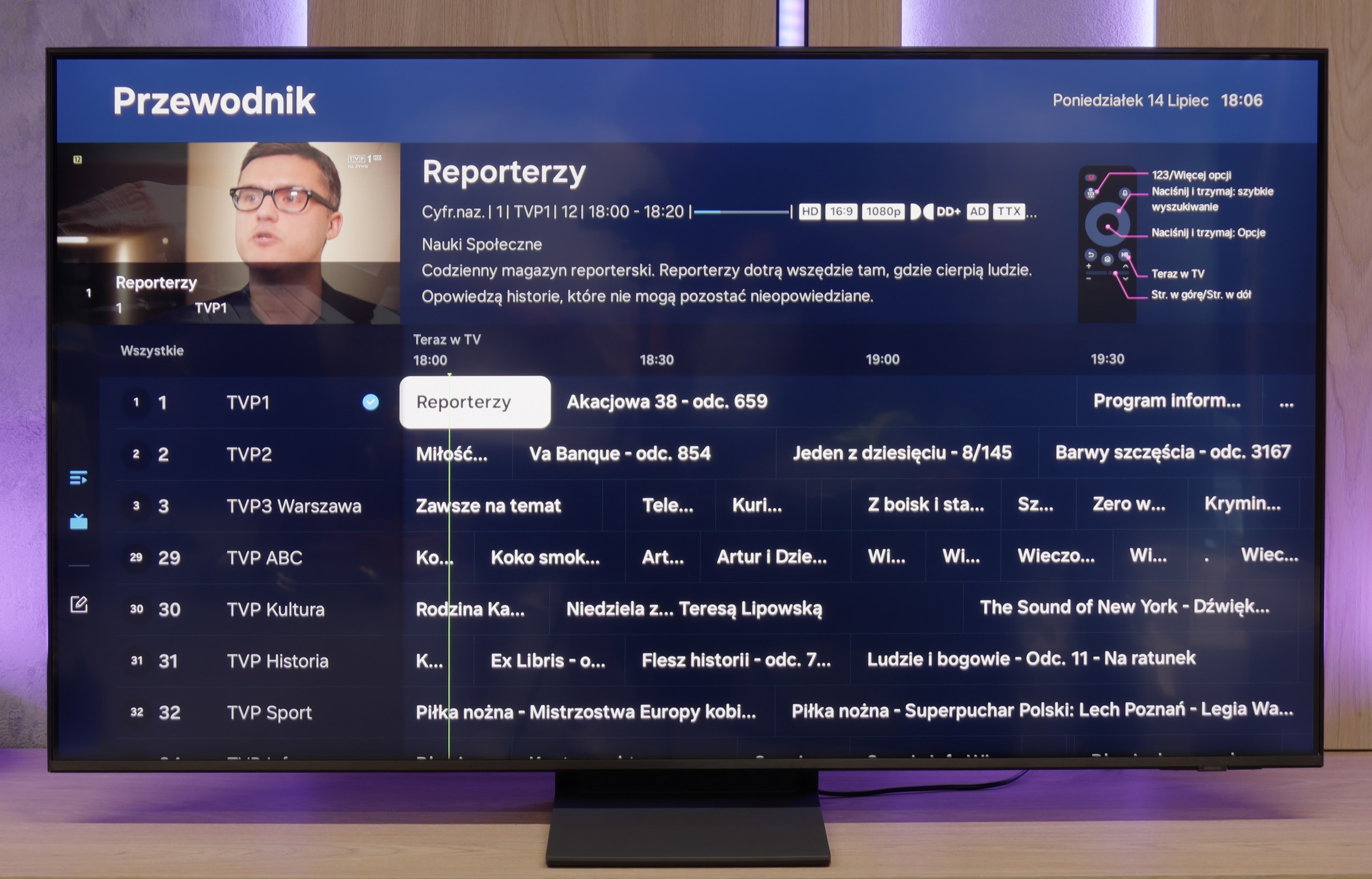
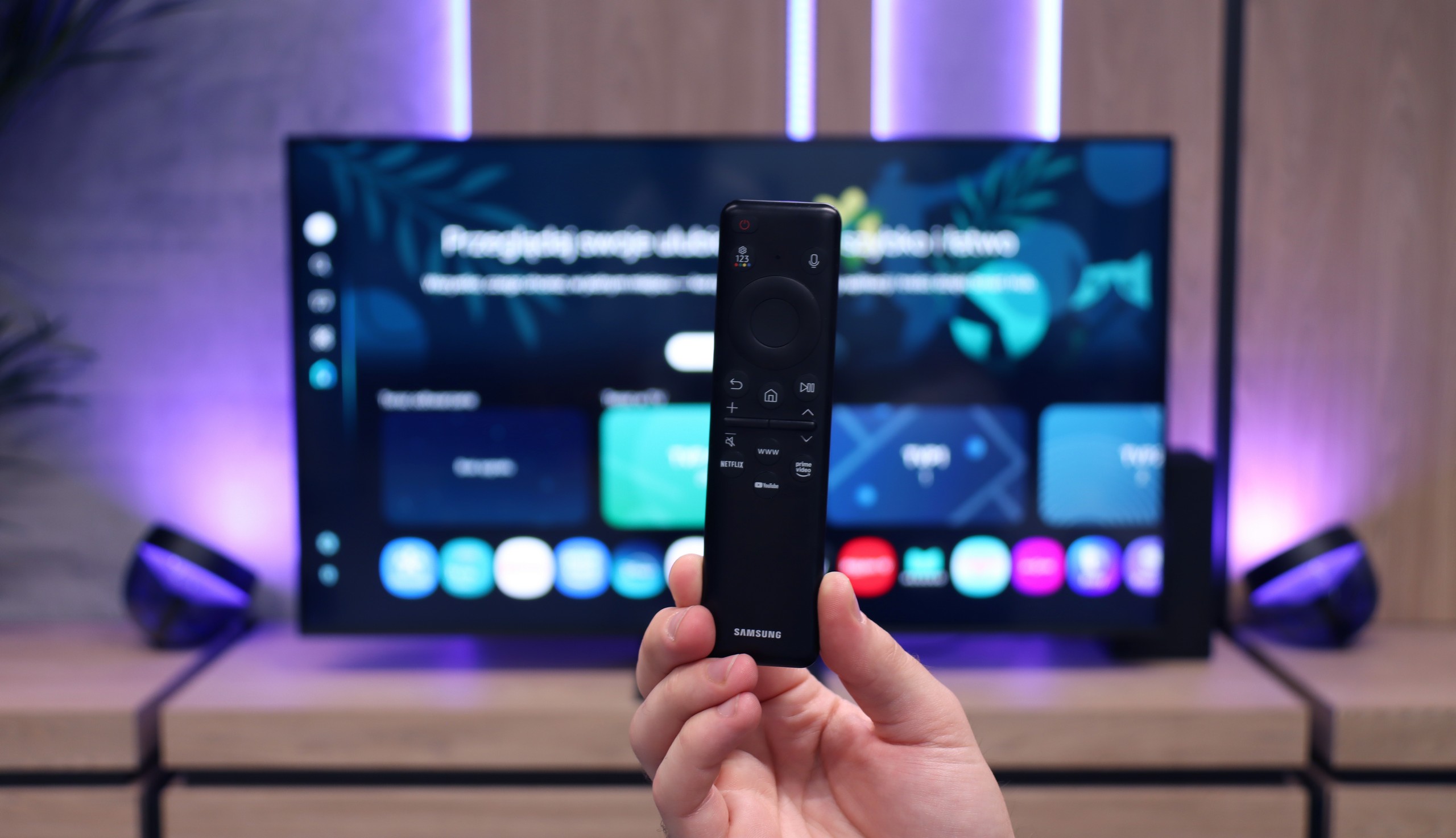
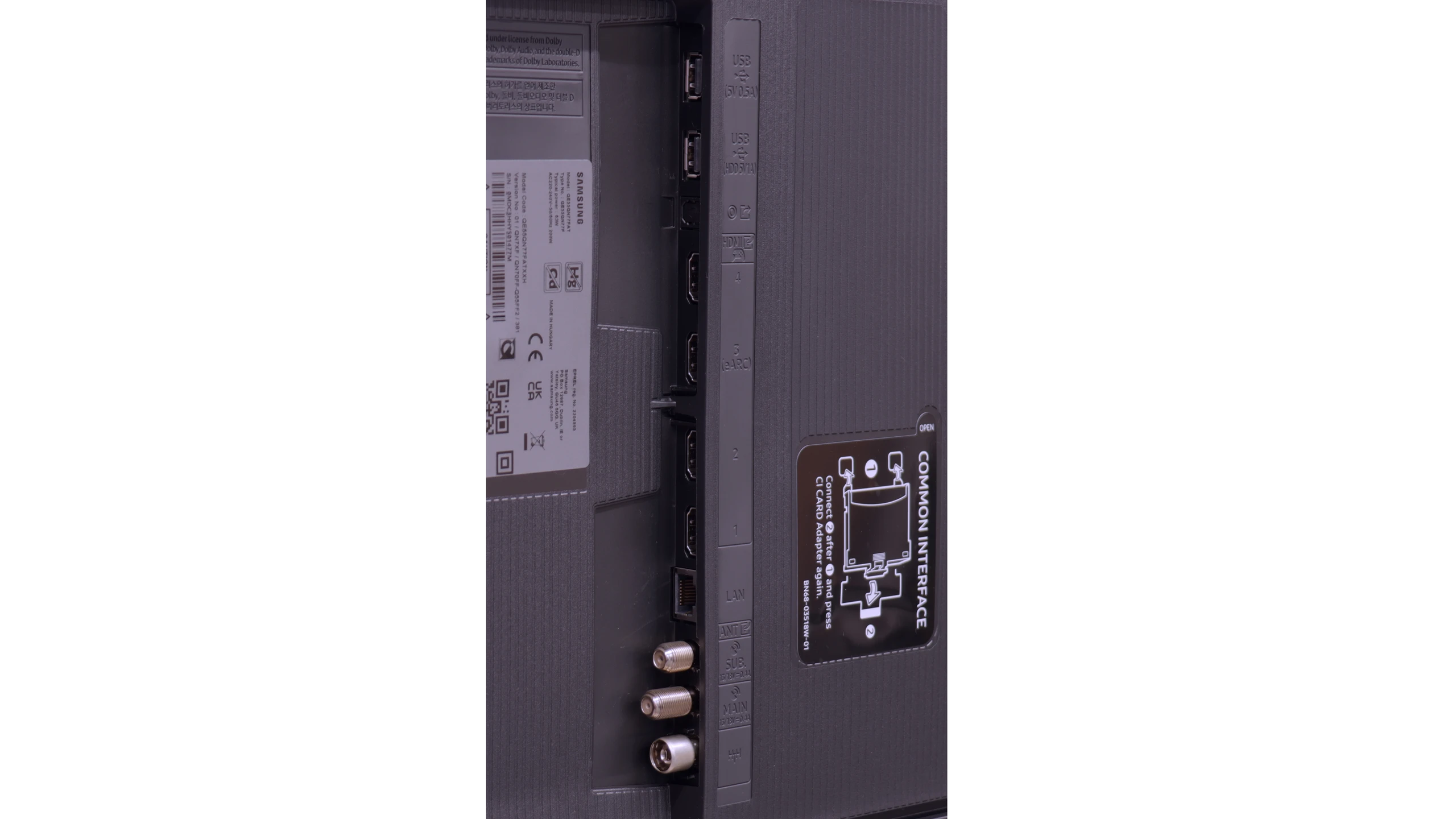
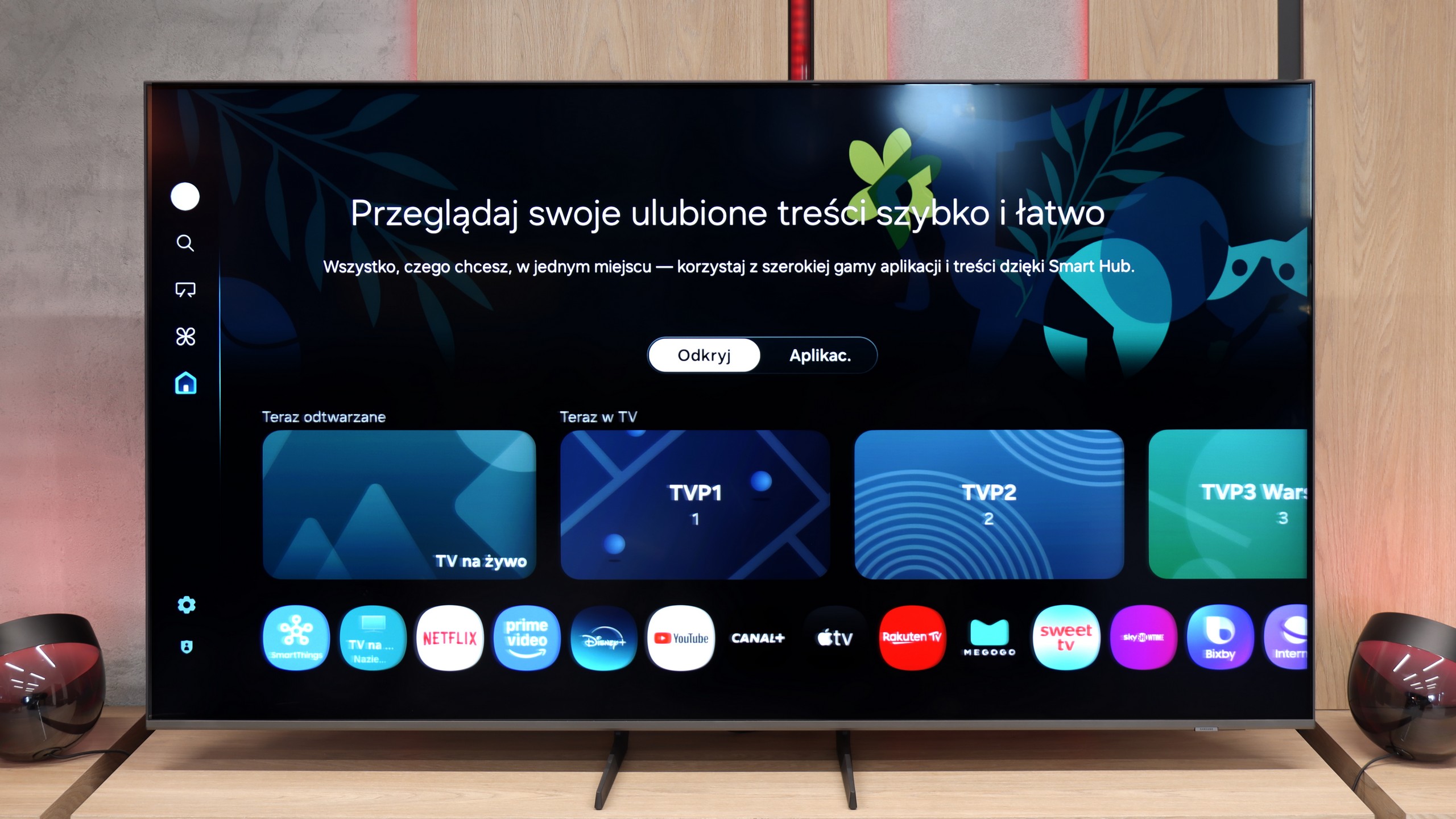
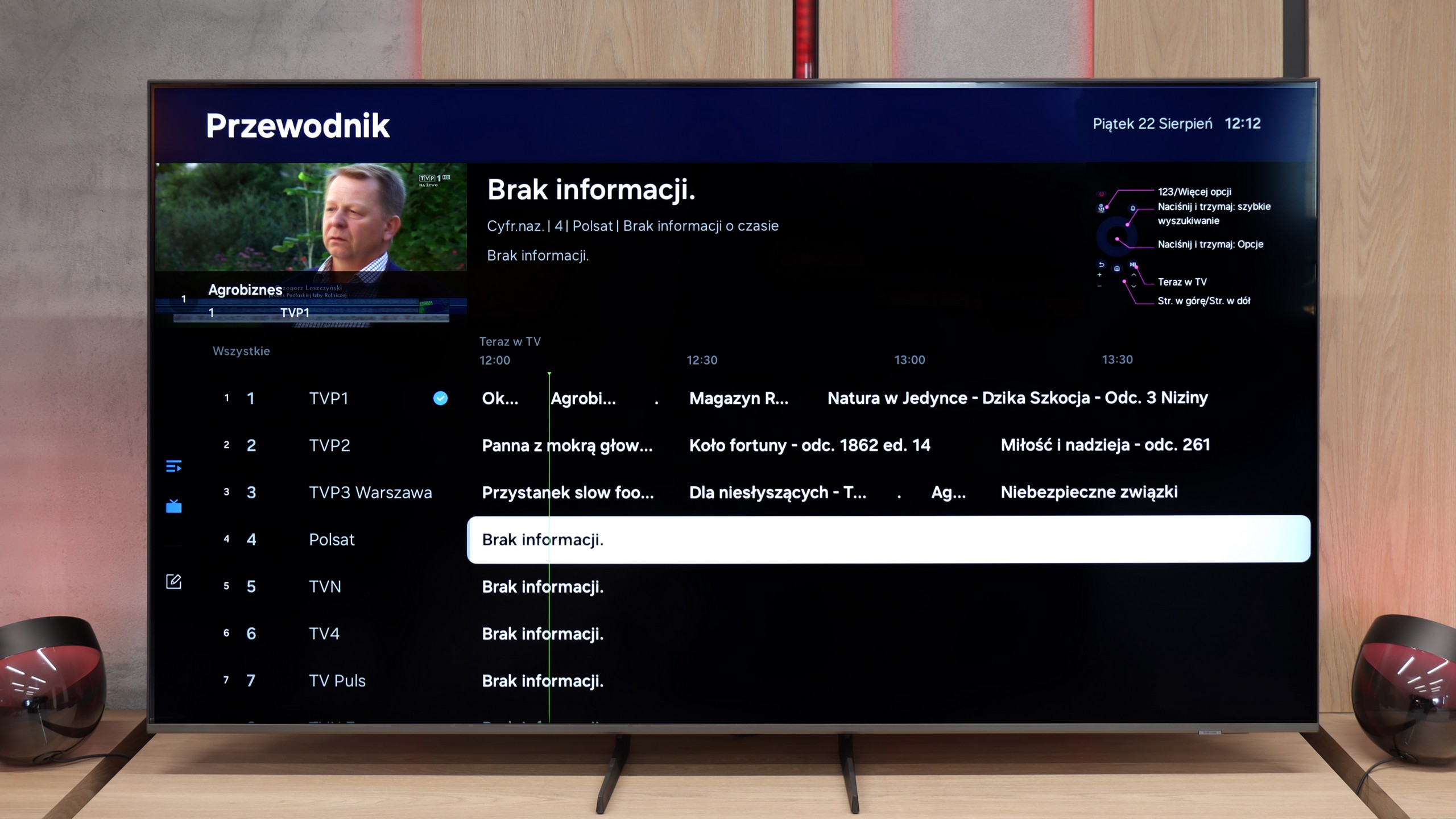
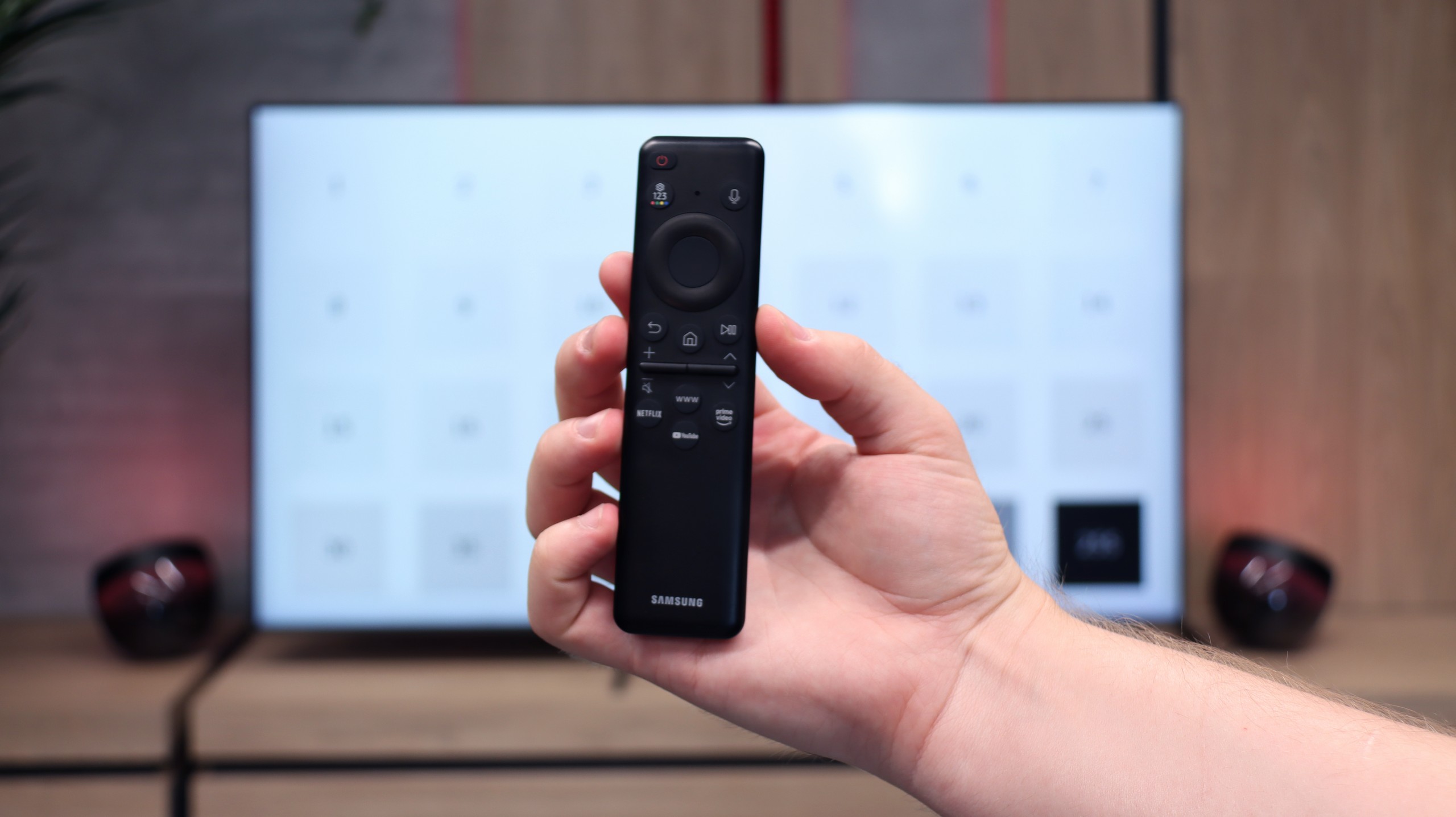
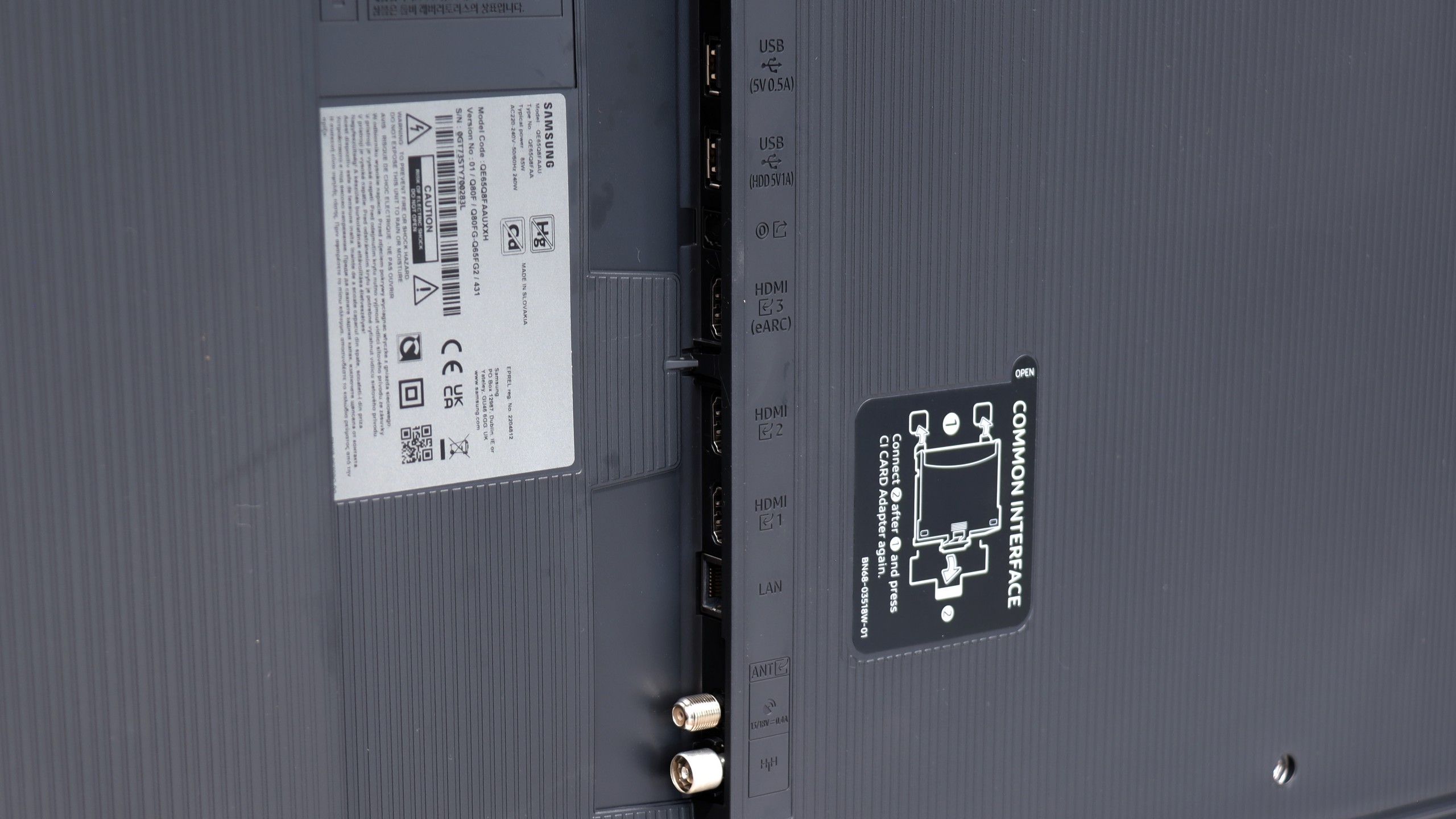
Television Features
The QN70F doesn't forget classic features that still matter to many users. On board, we find, among other things, picture-in-picture (PiP) mode, enabled by the presence of two tuners, teletext, and a "Sound Only" mode – perfect if we want to use the television like a radio. We can easily pair it with headphones or a soundbar via Bluetooth, and the remote control – despite the absence of a numeric keypad – works reliably, allowing us to operate other devices and additionally does not require us to aim at the screen. However, it should be noted that like all new Samsung models, we will not find USB recording functionality here. This is a system limitation that the brand clearly adheres to consistently.
Smart TV QN70F – Tizen
The Tizen system, developed by Samsung for years, is one of the most refined Smart TV interfaces. It is fast, intuitive, and feature-rich. The QN70F supports voice search (also in Polish), wireless screen mirroring from a phone (both via AirPlay and Miracast), as well as integration with watches and other devices in the Samsung ecosystem. All of this is connected by the SmartThings app, which allows you to control hardware, automate tasks, and connect devices in one network. (Not only Samsung brand devices). However, it is not perfect. Tizen is a closed system, so the selection of apps can be somewhat limited – especially in comparison to Google TV. All the major streaming services are in place, but if you use less popular services, it's worth checking before purchasing if they are available in the Samsung store.
SmartTV Features: Tizen
In terms of smart features, the Q8F does not lag behind what Samsung has accustomed us to. On board, we have the Tizen system – fast, intuitive, and well integrated with other devices. AirPlay, screen mirroring, and simple voice commands work seamlessly, so the basics are checked off perfectly. Additionally, there is SmartThings, an app that turns the television into the centre of a home ecosystem. You can connect a washing machine, vacuum cleaner, light bulbs, or speakers and control everything from one place, including the television. There is also no shortage of apps within Tizen for watching films or series – Netflix, YouTube, Disney+, and Prime Video are readily available. However, it is worth noting that Tizen is a closed system, so anyone hoping to install less popular programmes may be disappointed.
Traditional Television
Traditional television fares worse. The Q8F will simply act as a screen here – it will display the image, but we won't find additional functions such as USB recording or PiP mode. The remote is small and strongly minimalist. It looks modern and can be charged with solar batteries on the back cover or via USB-C, but it must be recognized that it may not appeal to everyone – particularly older users may miss traditional buttons. However, it must be noted honestly that Samsung has been consistently steering its televisions (as has the competition, which copies some of their ideas) towards the smart home, rather than towards equipment "for grandparents." Considering the tremendous popularity of the brand, it can be assumed that most users, even the older ones, have already got used to the fact that the era of remotes with a full array of rubber buttons is slowly coming to an end.
Playing files from USB
9/10
9.1/10
Supported photo formats:
Maximum photo resolution:
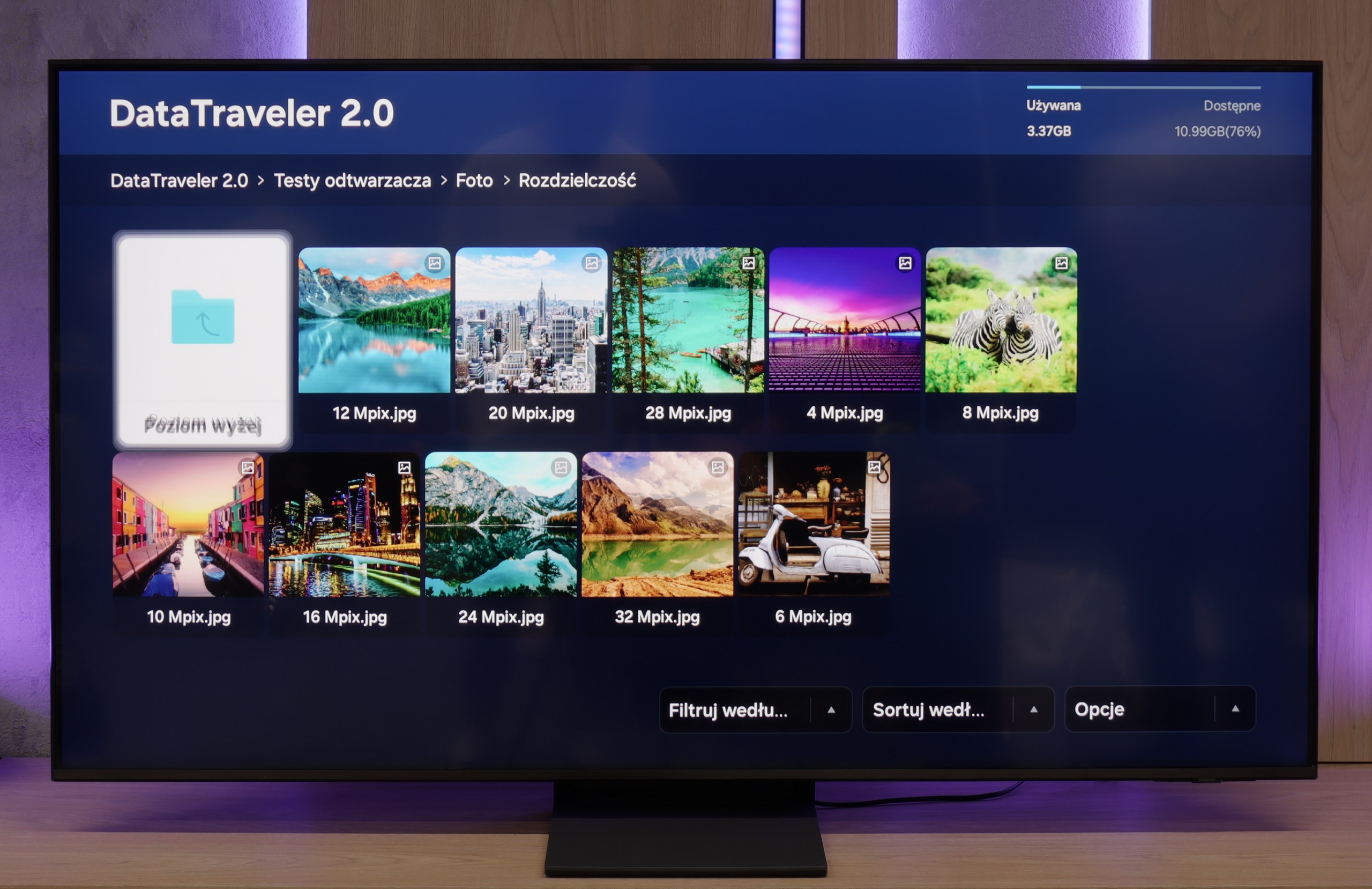
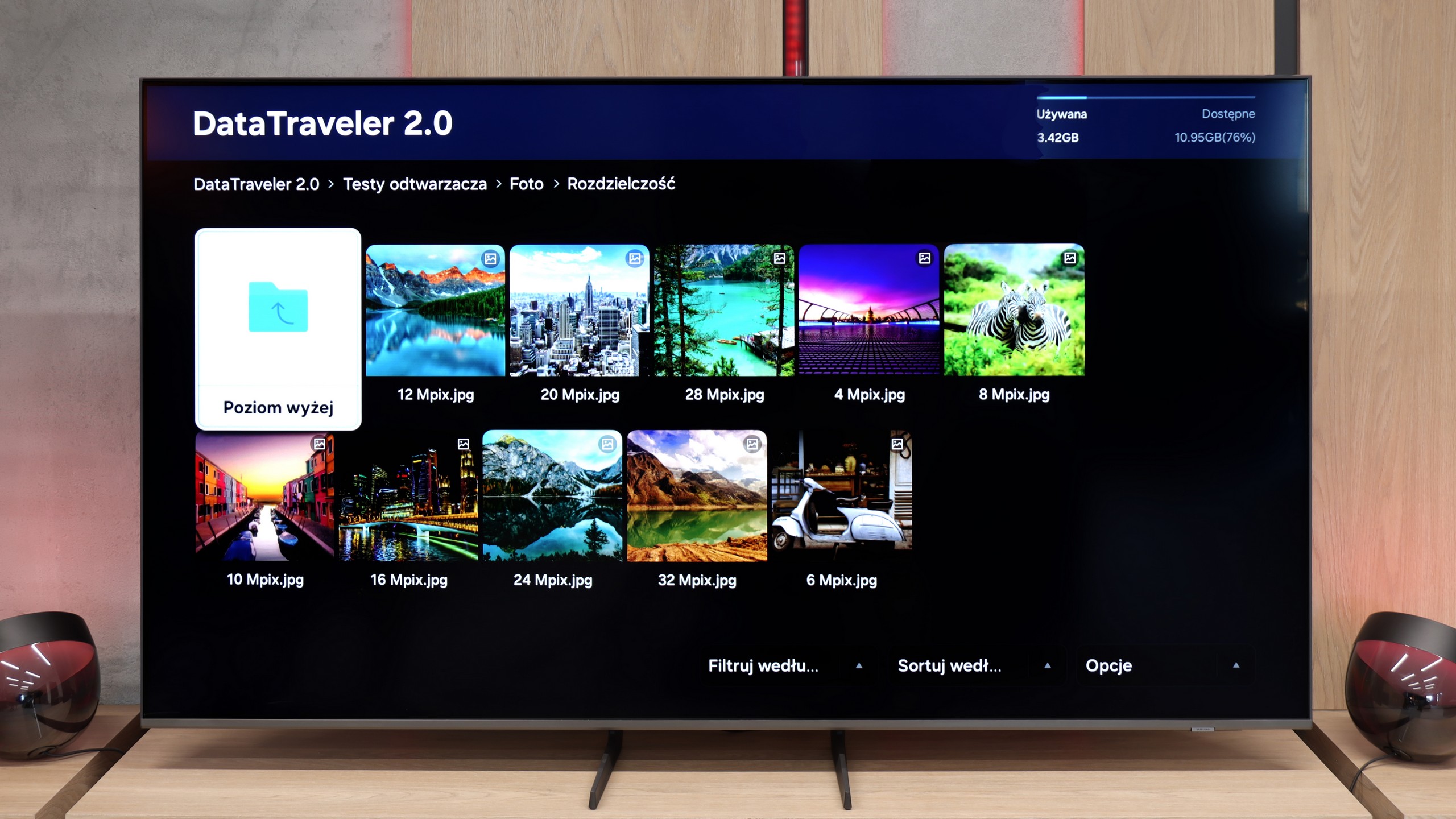
Samsung QN70F performs well with media playback – it easily runs photos, music, and videos in the most commonly used formats. During tests, it effortlessly opened JPG files, MP4, and subtitles in TXT format, so for most people, this will simply be sufficient. However, there were instances where a few files – despite having the correct extensions – would not play. It may be an issue with a specific version of the system, and the problem might disappear after future updates.
Samsung Q8F handles playing files from USB quite efficiently. It supports virtually all popular video formats as well as photos, so you can easily load a holiday video or a family album. There are occasional exceptions with less common photo formats, but the most important JPEG works perfectly, which will be crucial for the majority of users. It's just a pity that Tizen does not allow for the installation of alternative players, such as VLC. Even then, less popular formats would not pose any problem.
Apps
8.7/10
8.7/10














































Sound
6.4/10
6/10
- Maximum volume84dB84dB
- Dolby Digital Plus 7.1
- Dolby True HD 7.1
- Dolby Atmos in Dolby Digital Plus (JOC)
- Dolby Atmos in Dolby True HD
- DTS:X in DTS-HD MA
- DTS-HD Master Audio
The Samsung QN70F performs quite mediocrely in terms of sound, which shouldn't come as a surprise considering the exceptionally slim design of the television. The built-in speakers will manage perfectly well during everyday viewing of news or simpler content, but it's hard to talk about any depth or spaciousness of sound here. It's simply a compromise one has to accept when choosing an elegant and thin design over a bulkier casing with a better audio system.
The sound on the Q8F can be described as acceptable. A slightly defined bass can be heard, but it is really minimal – the slim design of the television simply does not provide space for the pair of 2 × 10 W speakers to spread their wings. This is a typical scenario for most televisions: if someone cares about truly cinematic experiences, it is worth considering a soundbar. Samsung has a really wide range in this category across various budgets, so it's easy to find something suitable. The television itself will work for watching classic TV and series from time to time, but for greater sound excitement, one should not expect much.
Acoustic Measurements
84dBC (Max)
75dBC
84dBC (Max)
75dBC
